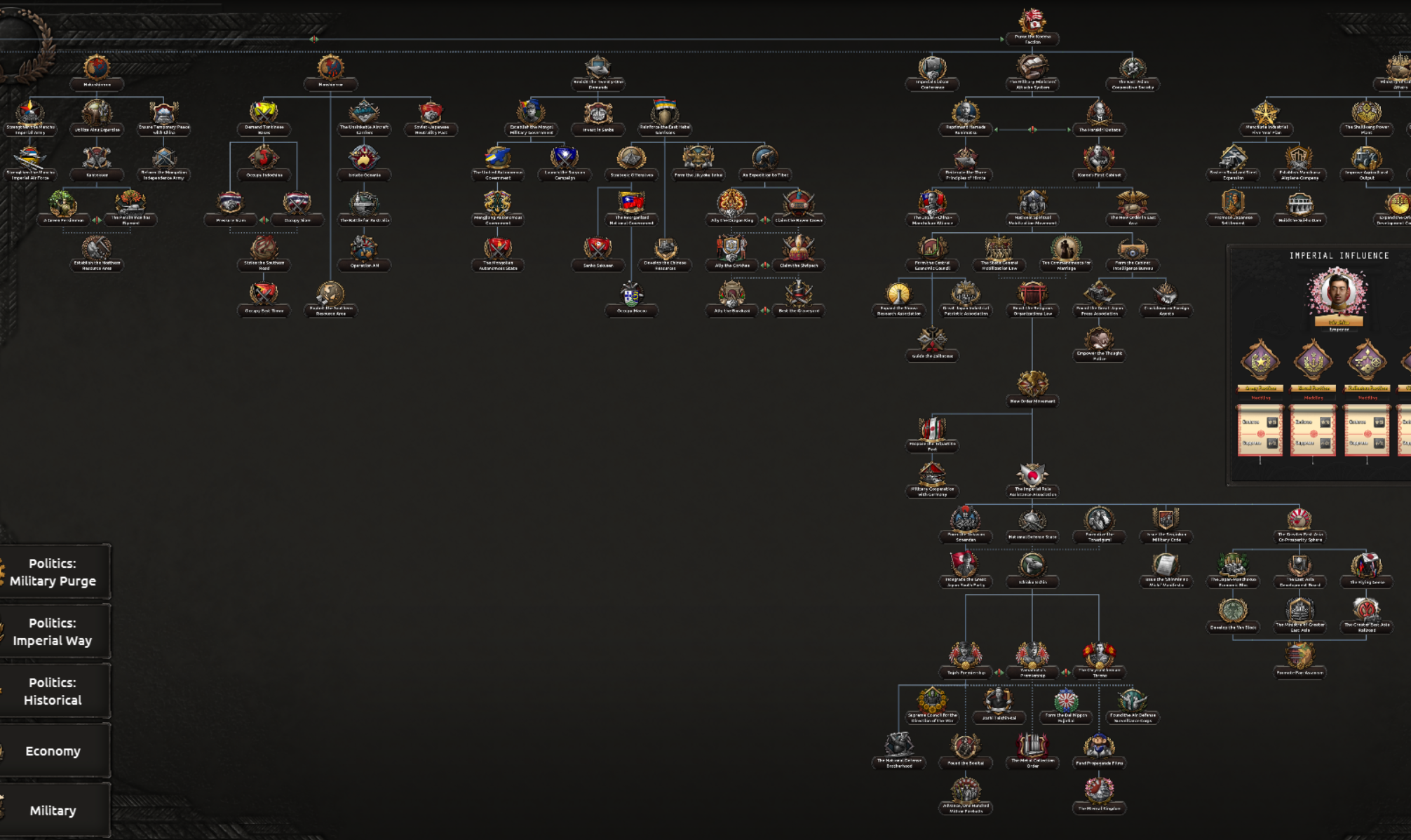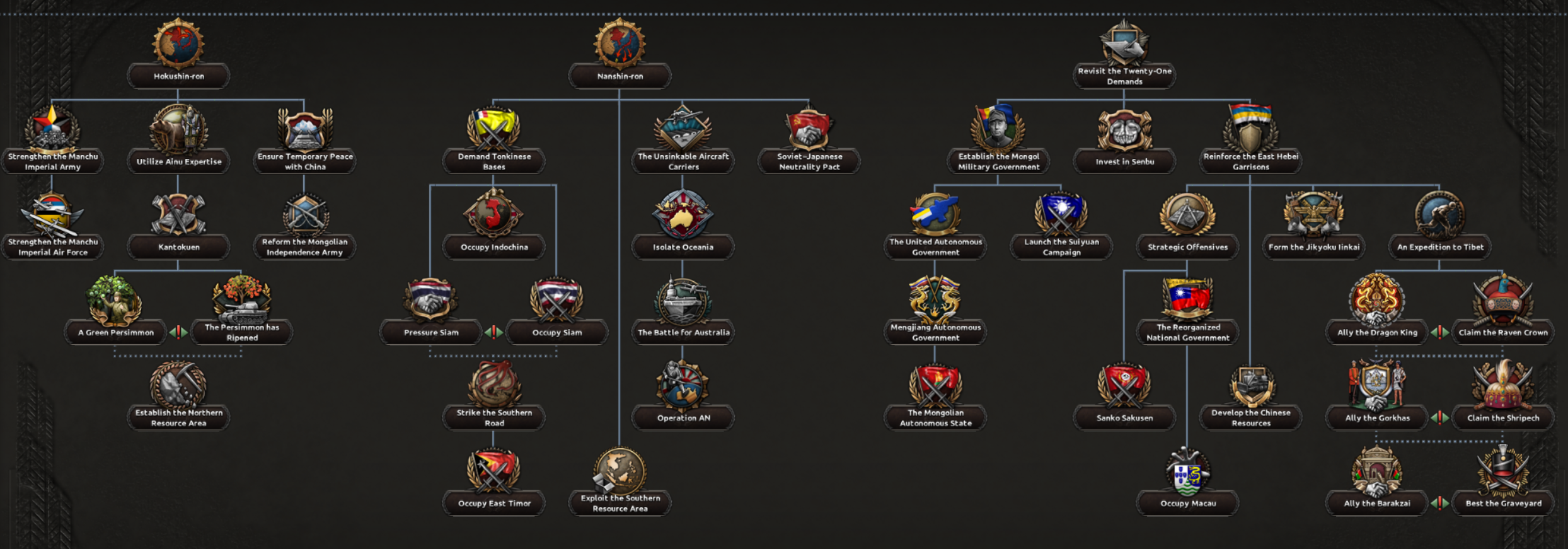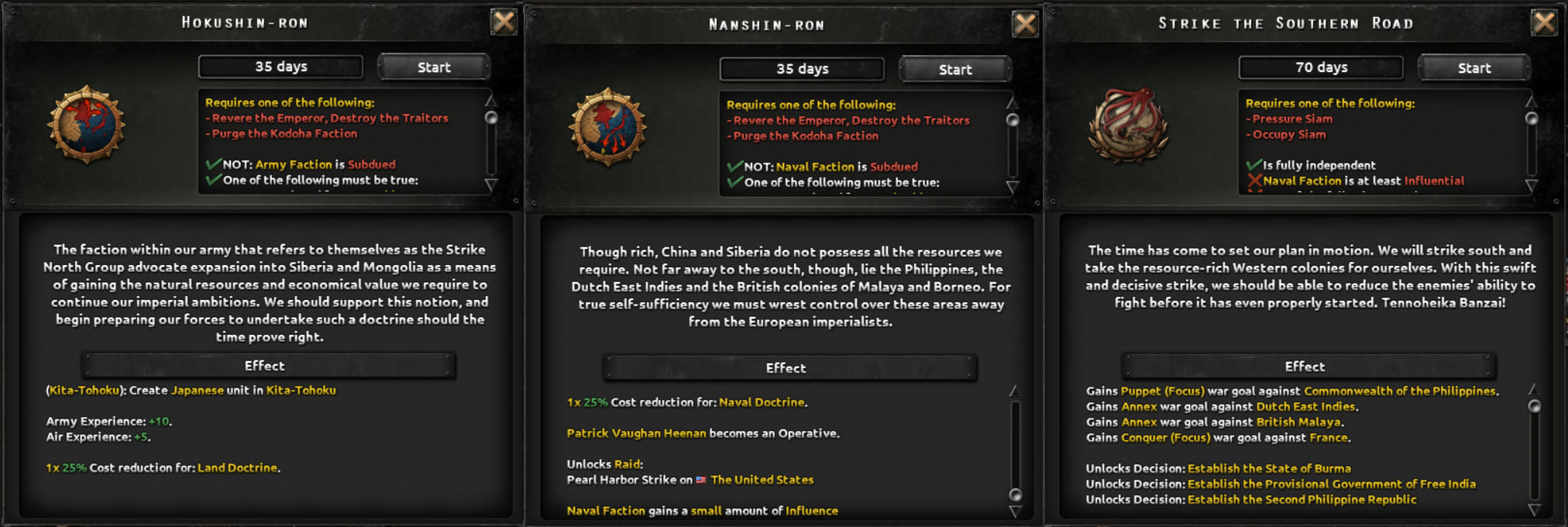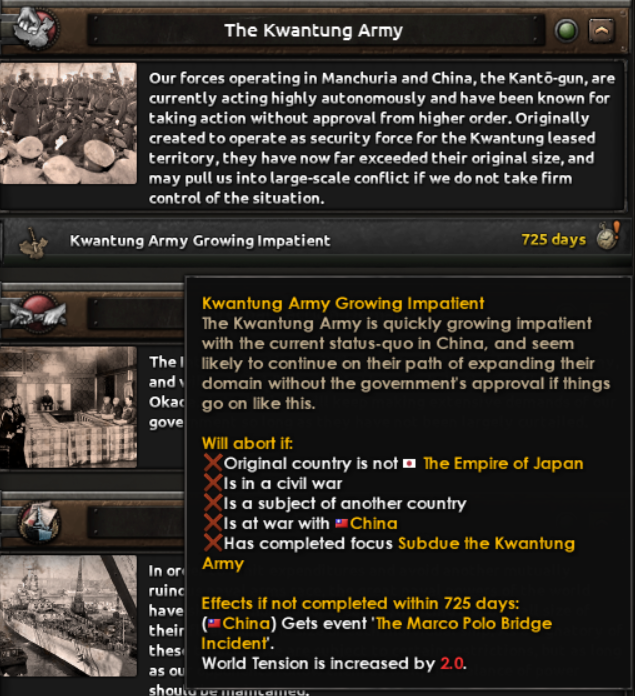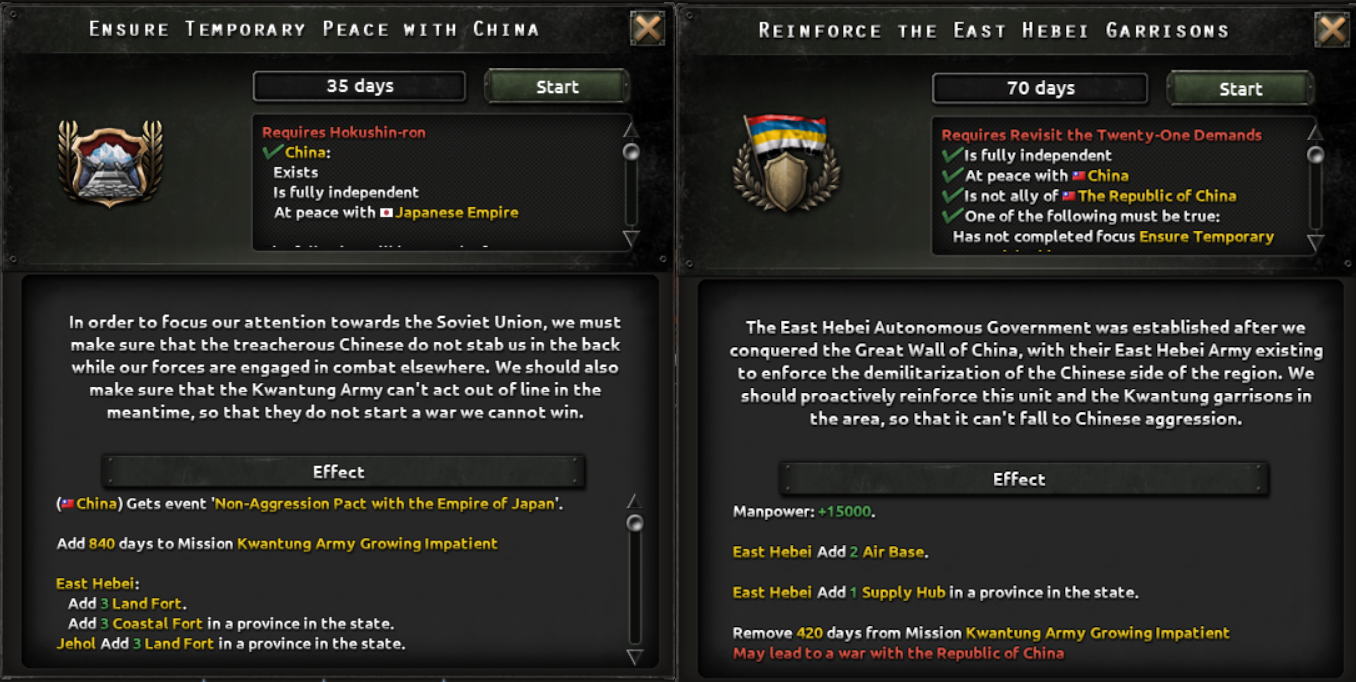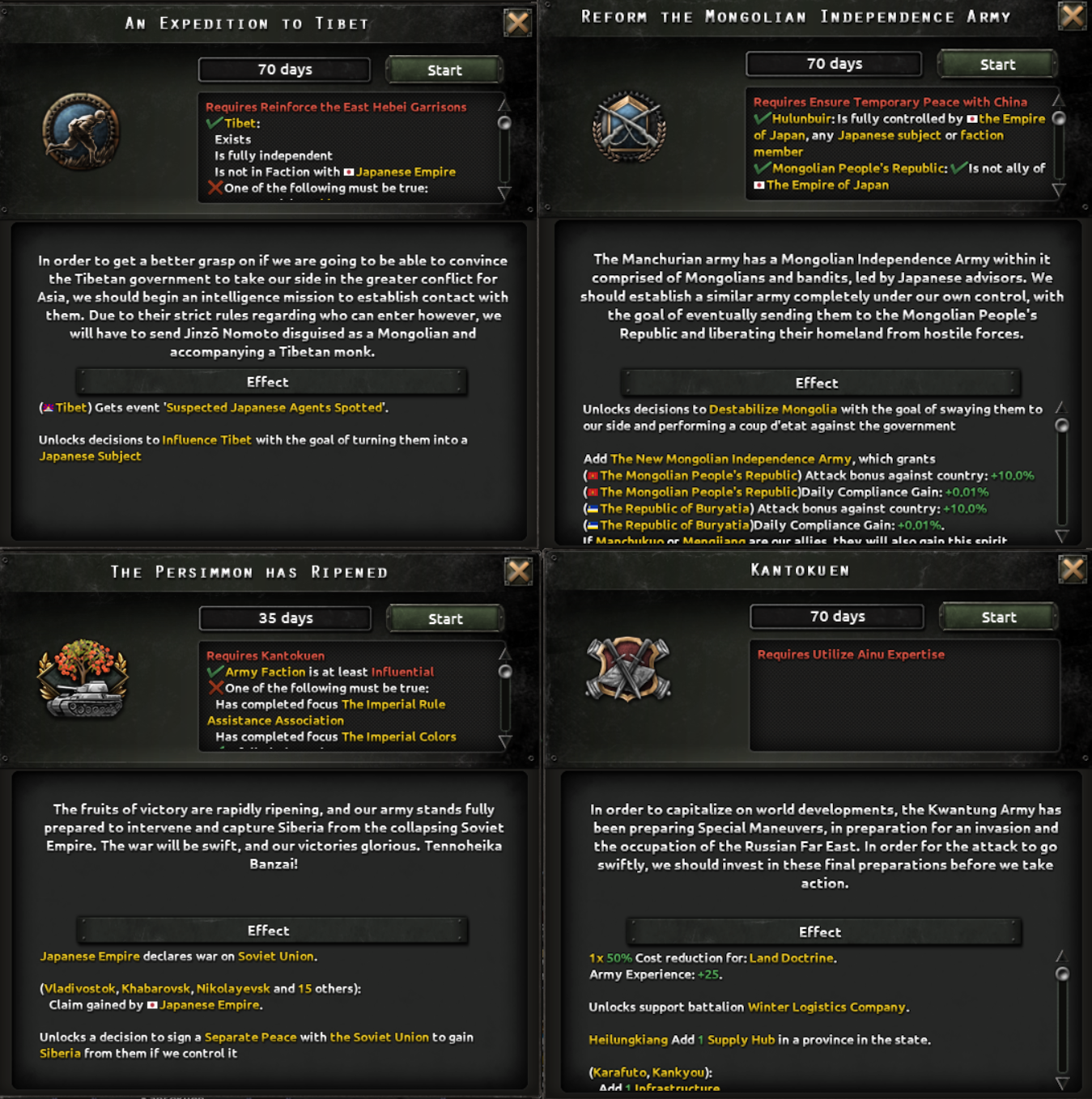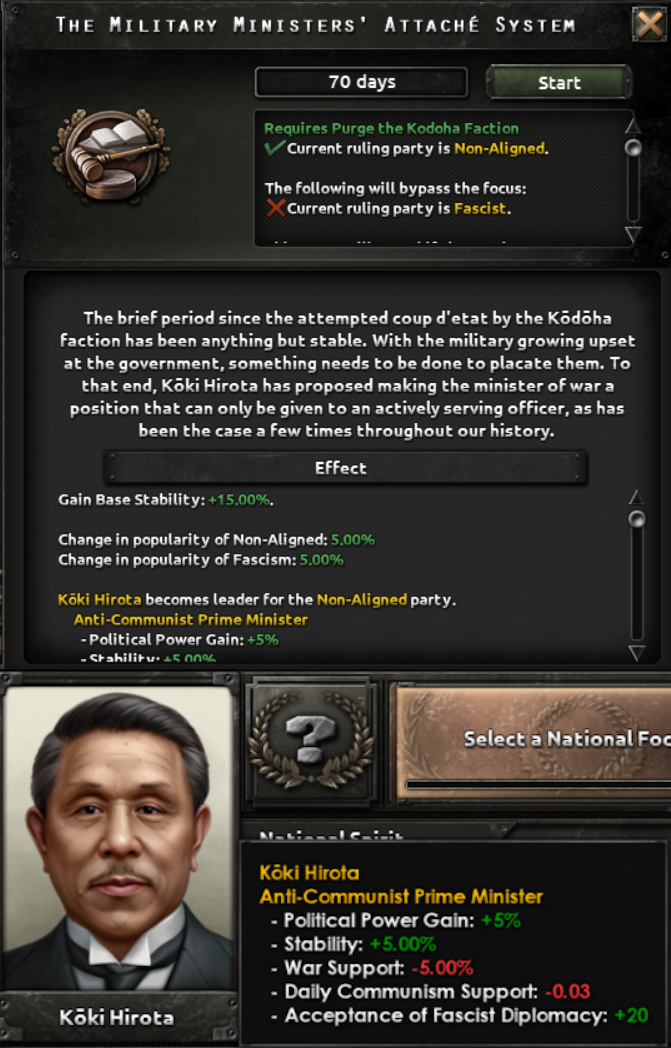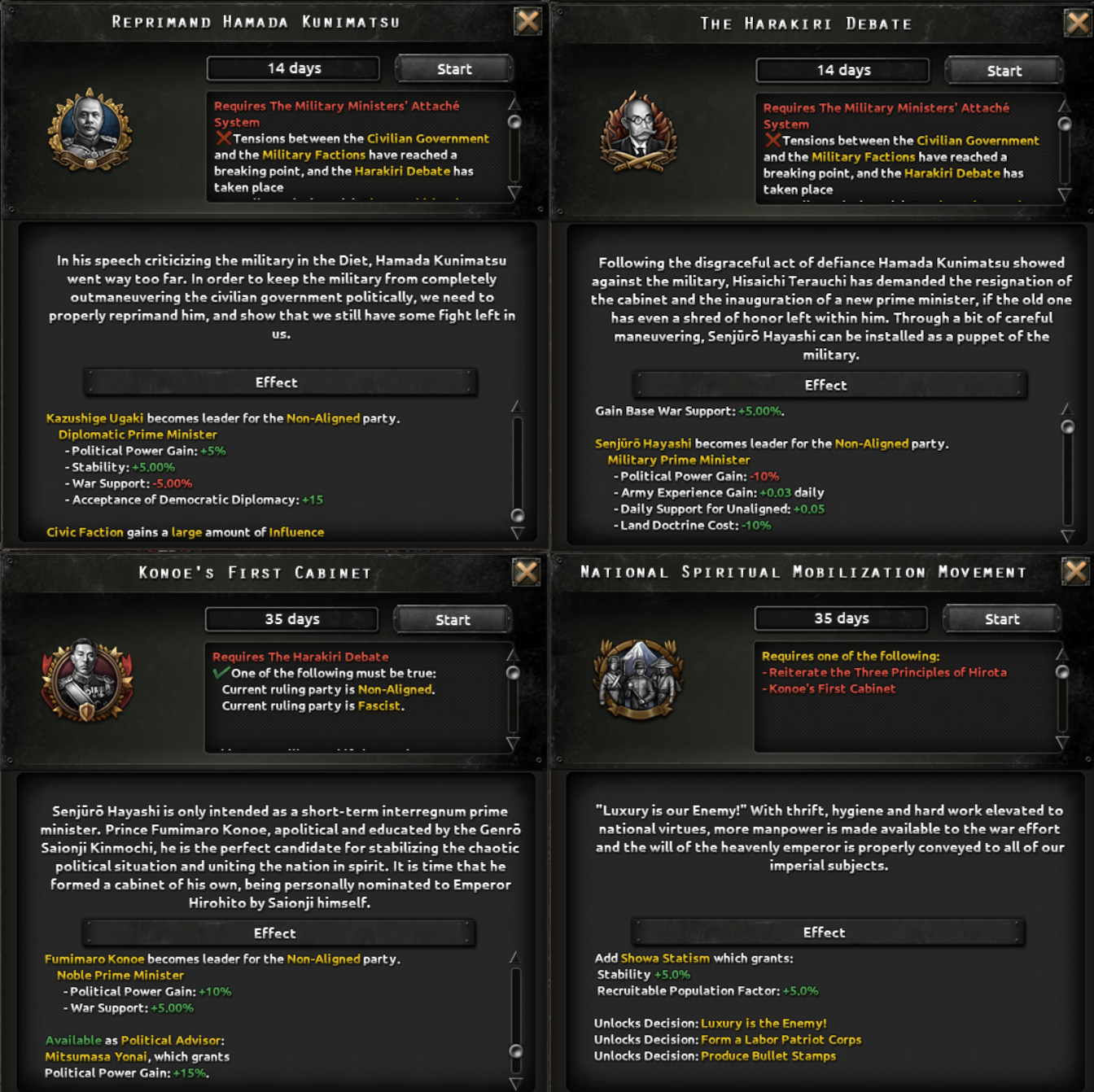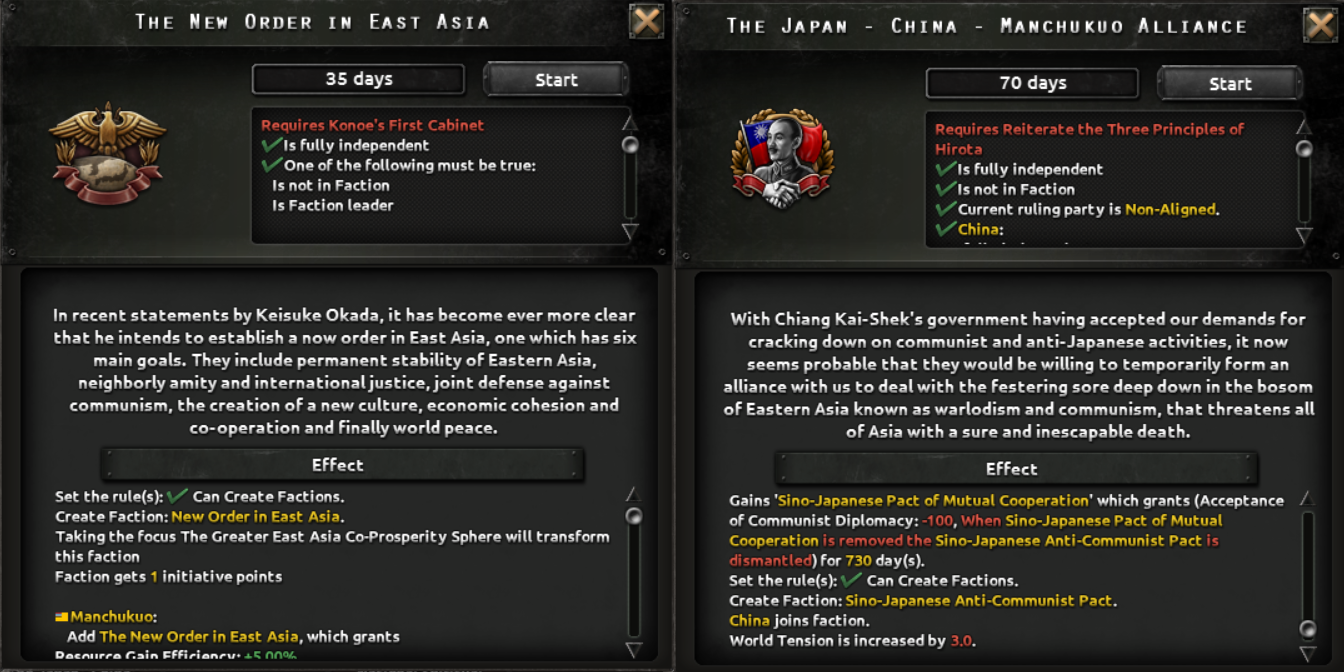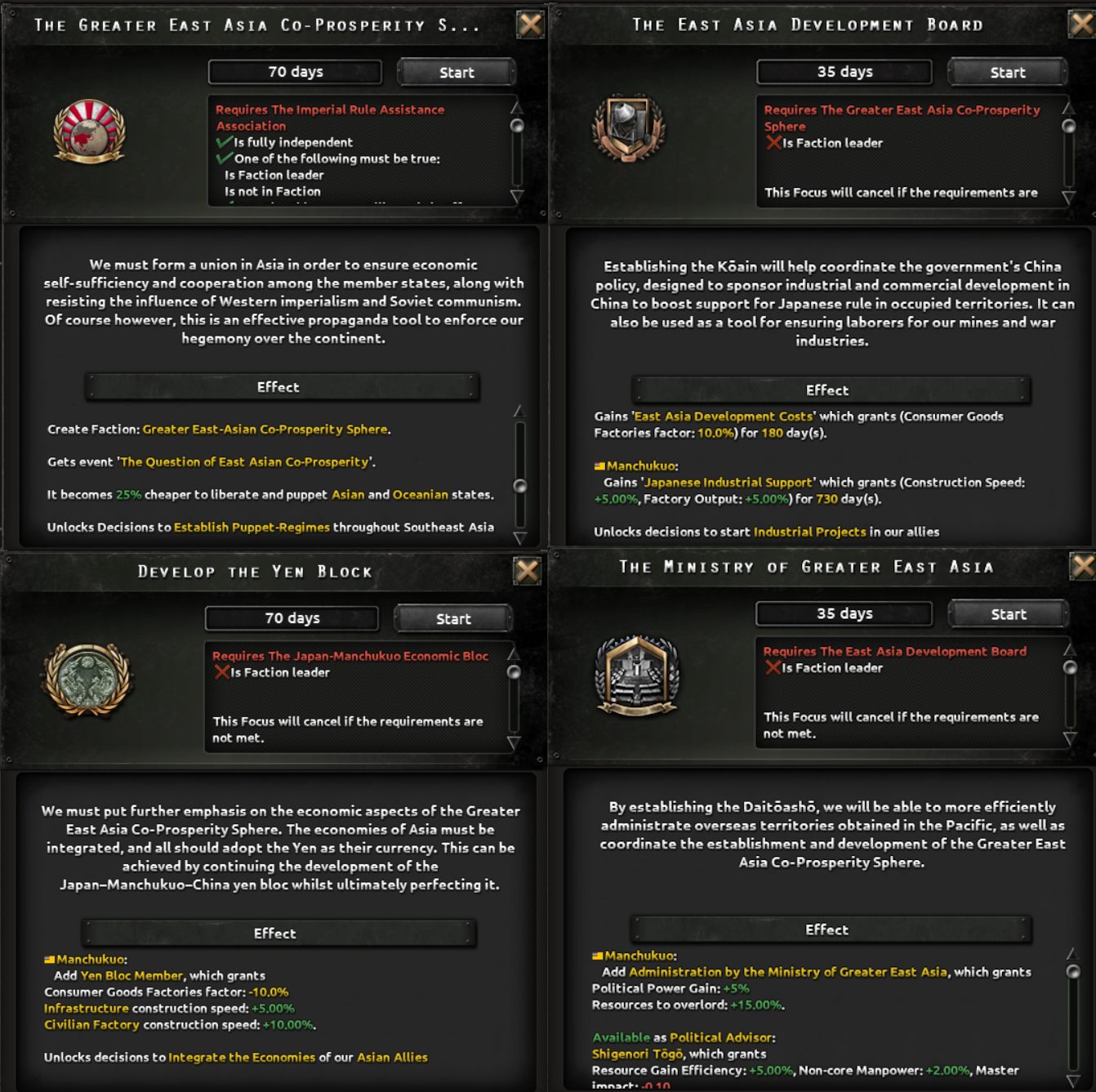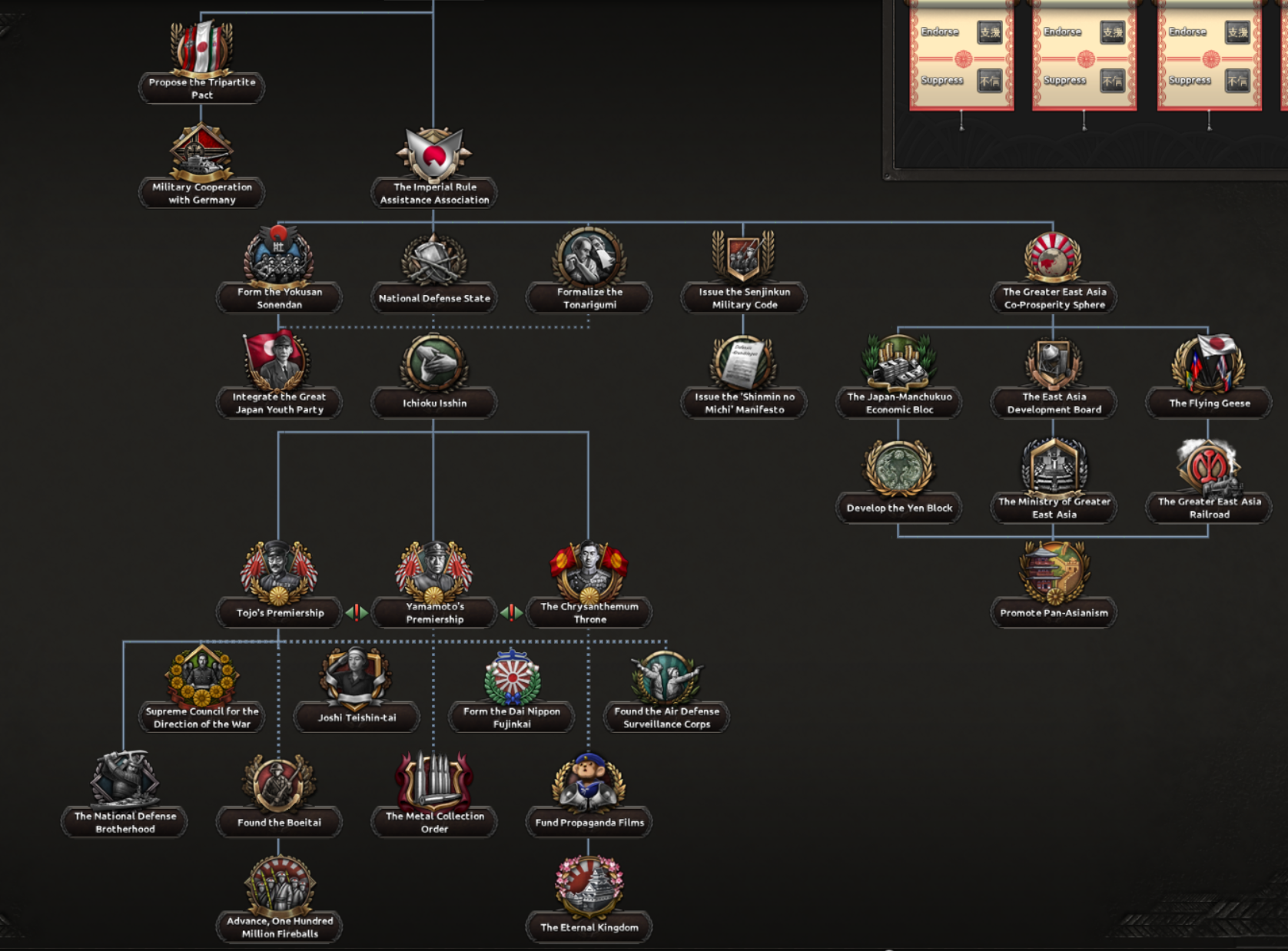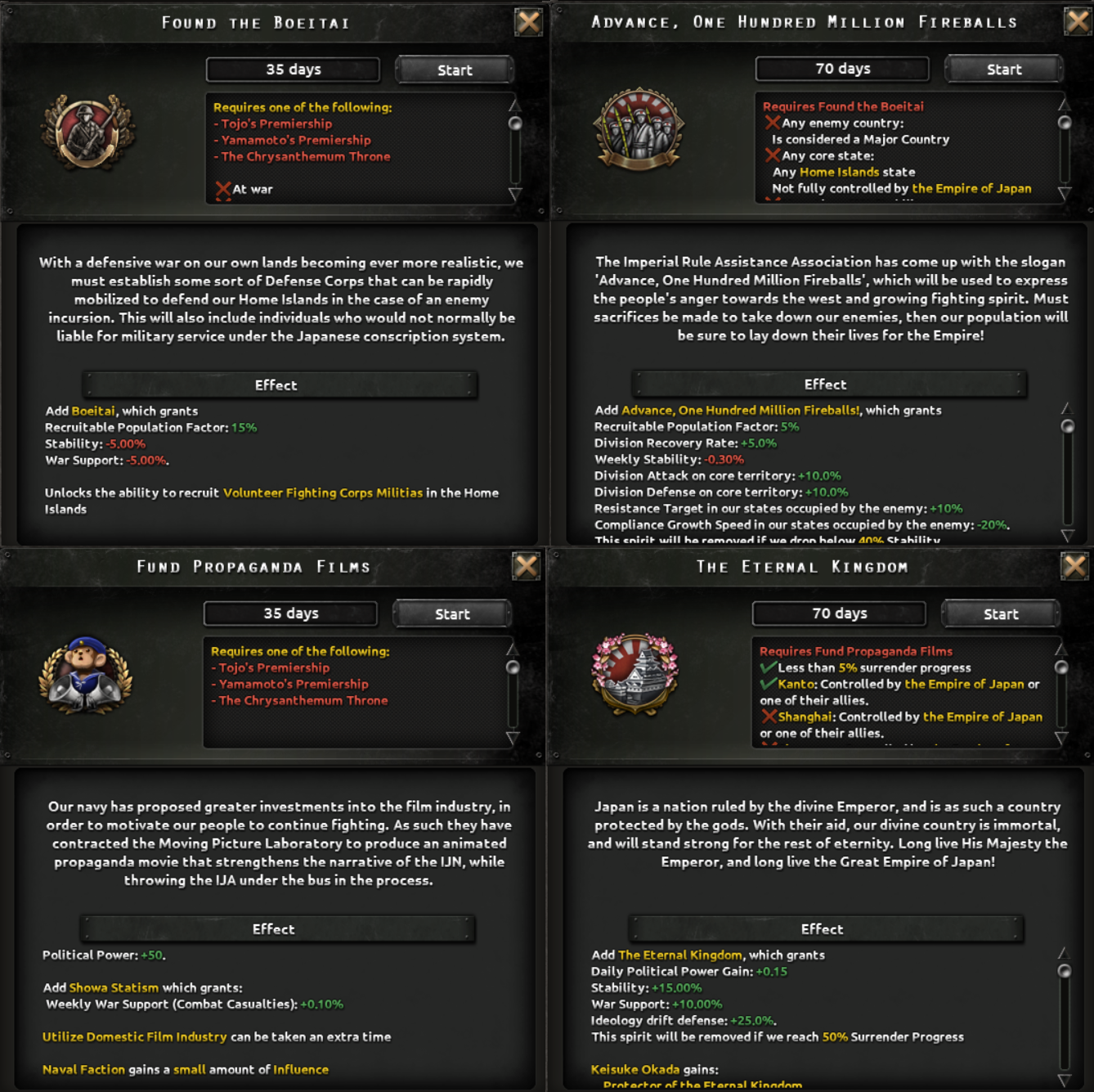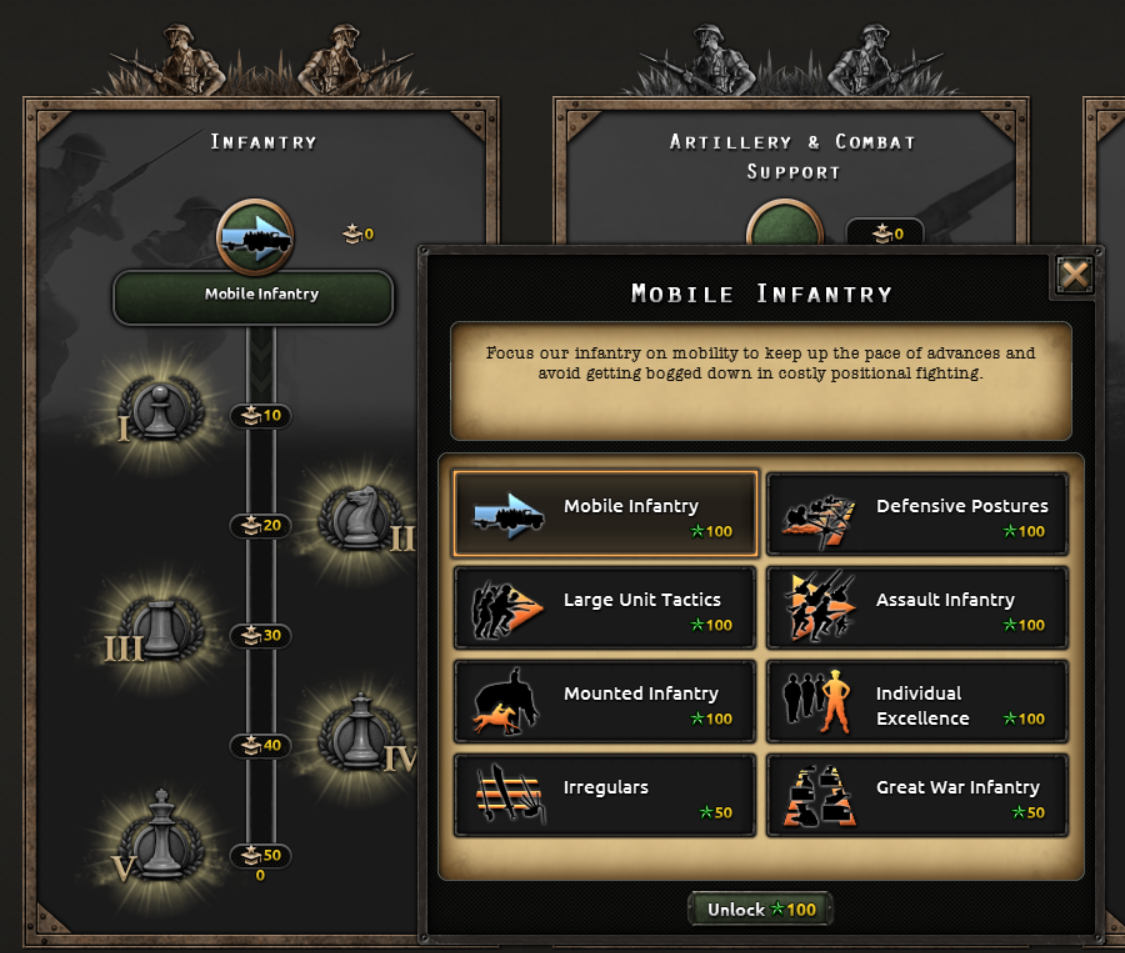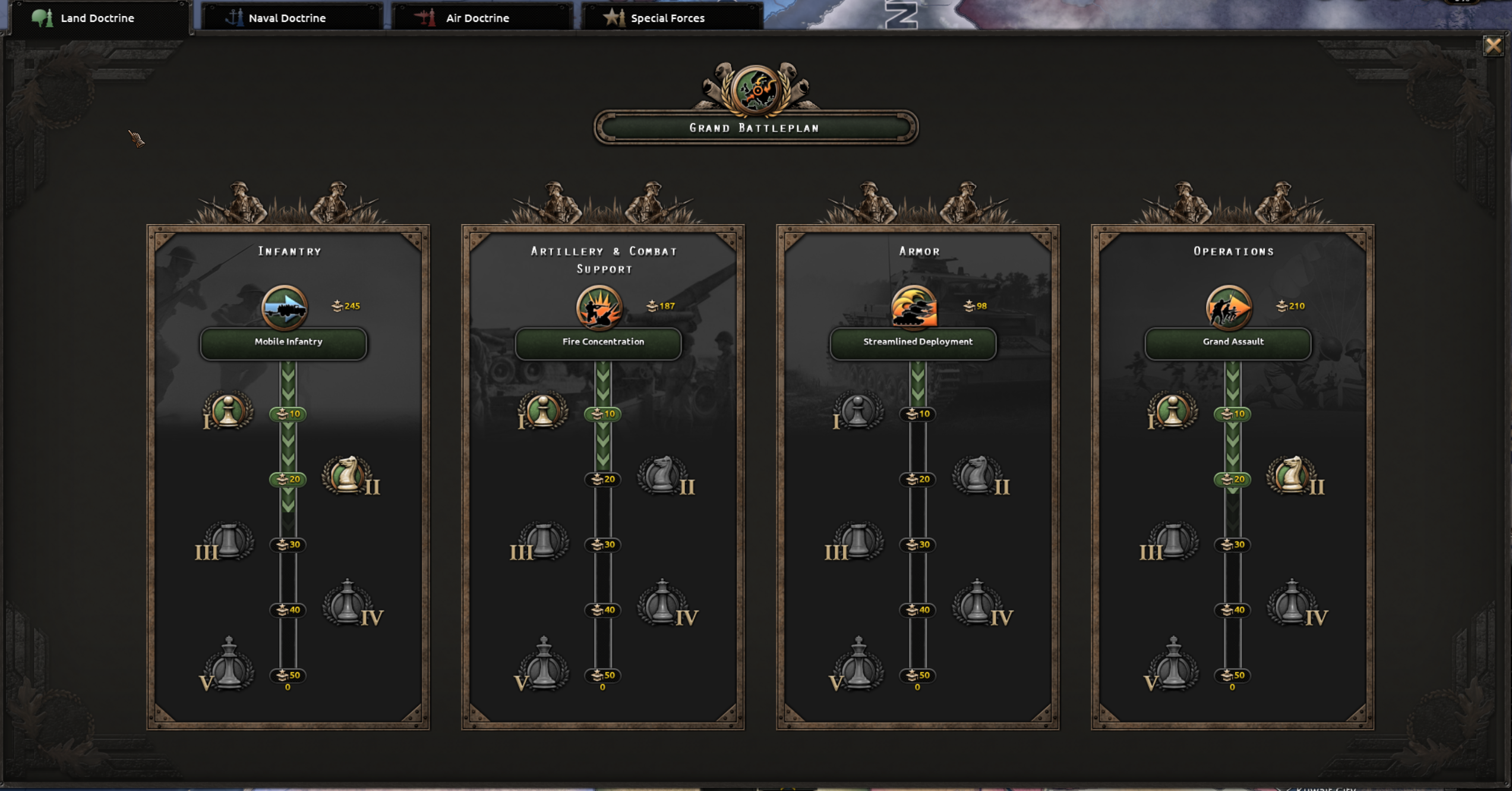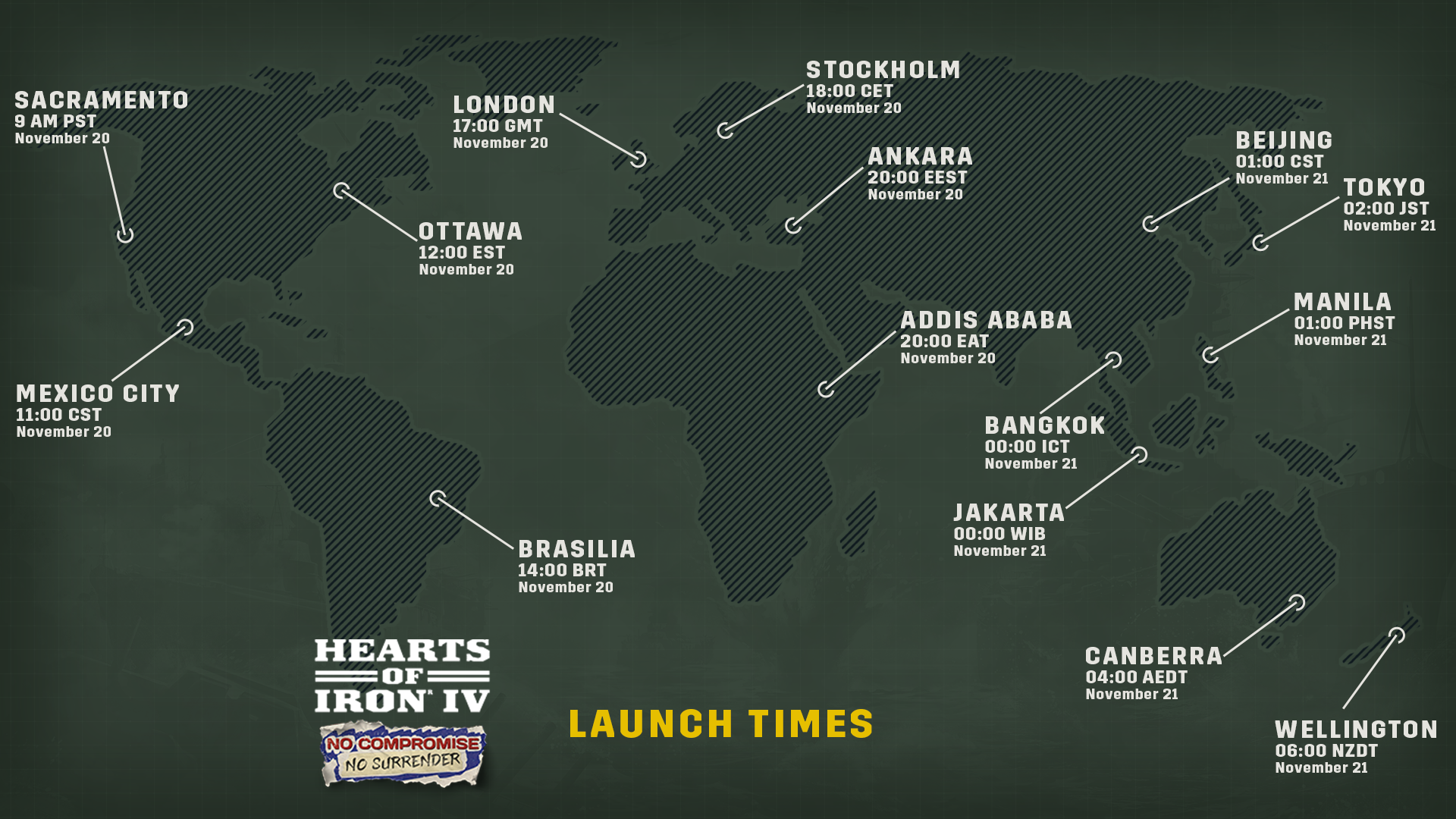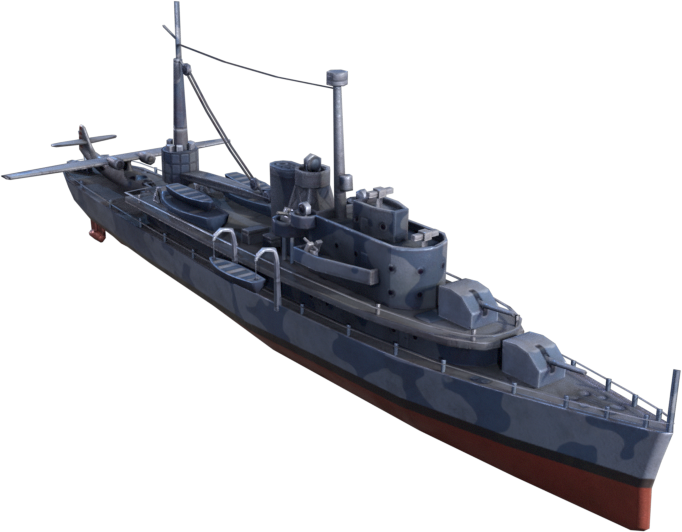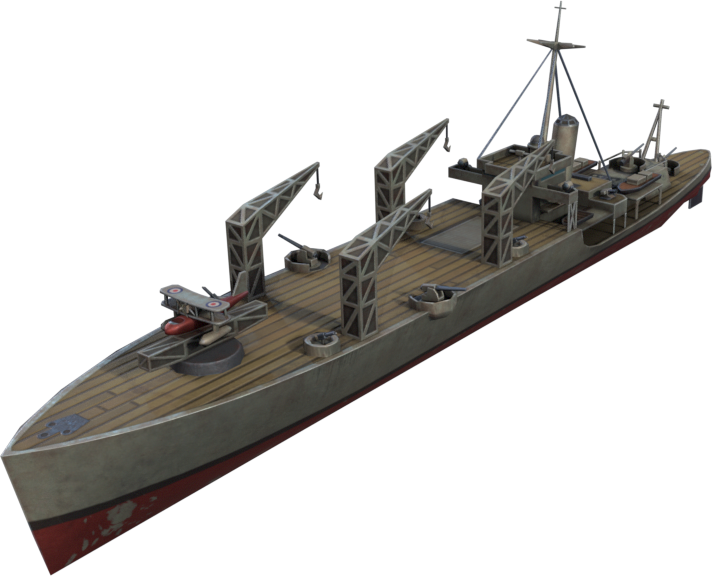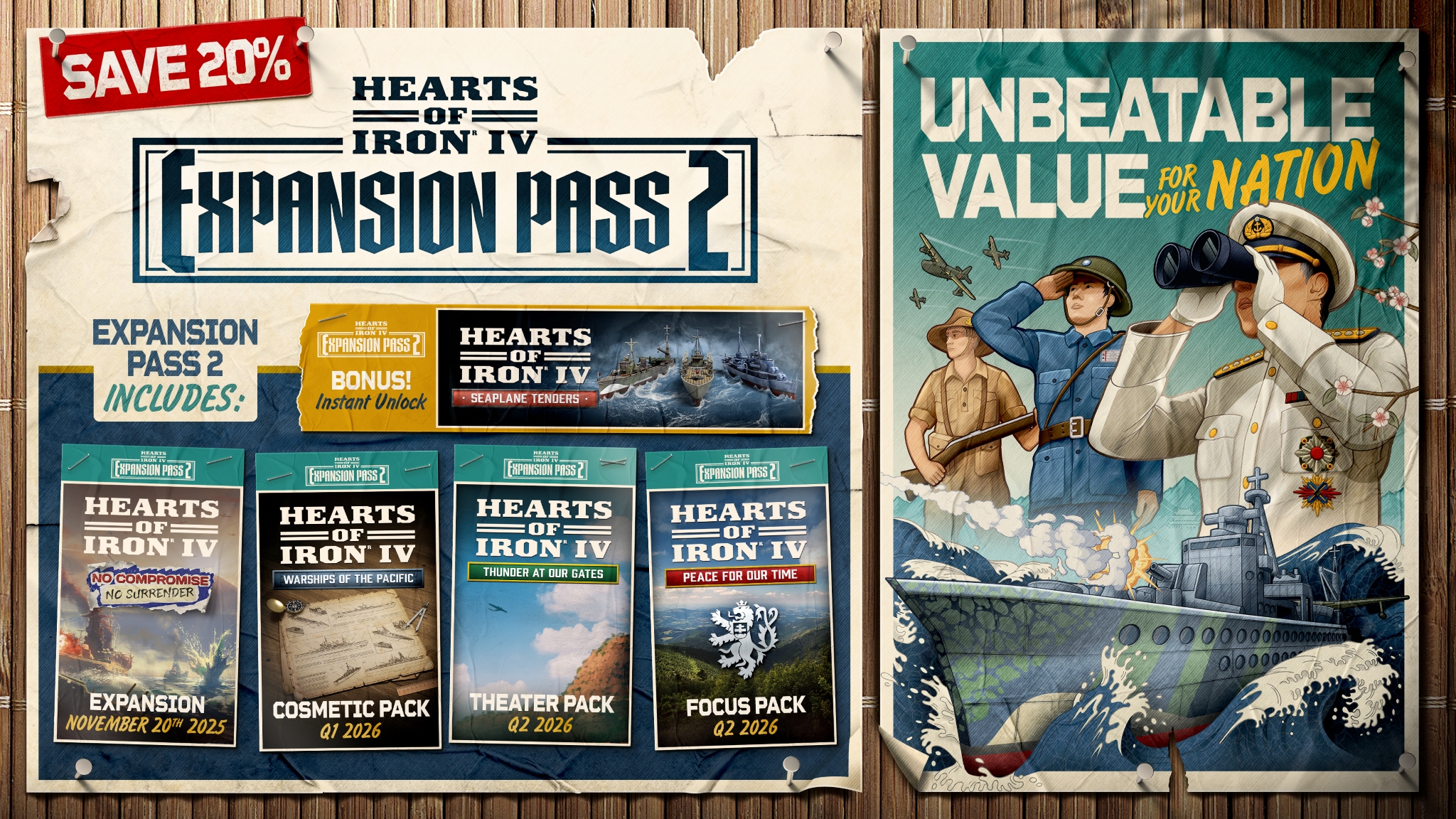Install Steam
login
|
language
简体中文 (Simplified Chinese)
繁體中文 (Traditional Chinese)
日本語 (Japanese)
한국어 (Korean)
ไทย (Thai)
Български (Bulgarian)
Čeština (Czech)
Dansk (Danish)
Deutsch (German)
Español - España (Spanish - Spain)
Español - Latinoamérica (Spanish - Latin America)
Ελληνικά (Greek)
Français (French)
Italiano (Italian)
Bahasa Indonesia (Indonesian)
Magyar (Hungarian)
Nederlands (Dutch)
Norsk (Norwegian)
Polski (Polish)
Português (Portuguese - Portugal)
Português - Brasil (Portuguese - Brazil)
Română (Romanian)
Русский (Russian)
Suomi (Finnish)
Svenska (Swedish)
Türkçe (Turkish)
Tiếng Việt (Vietnamese)
Українська (Ukrainian)
Report a translation problem










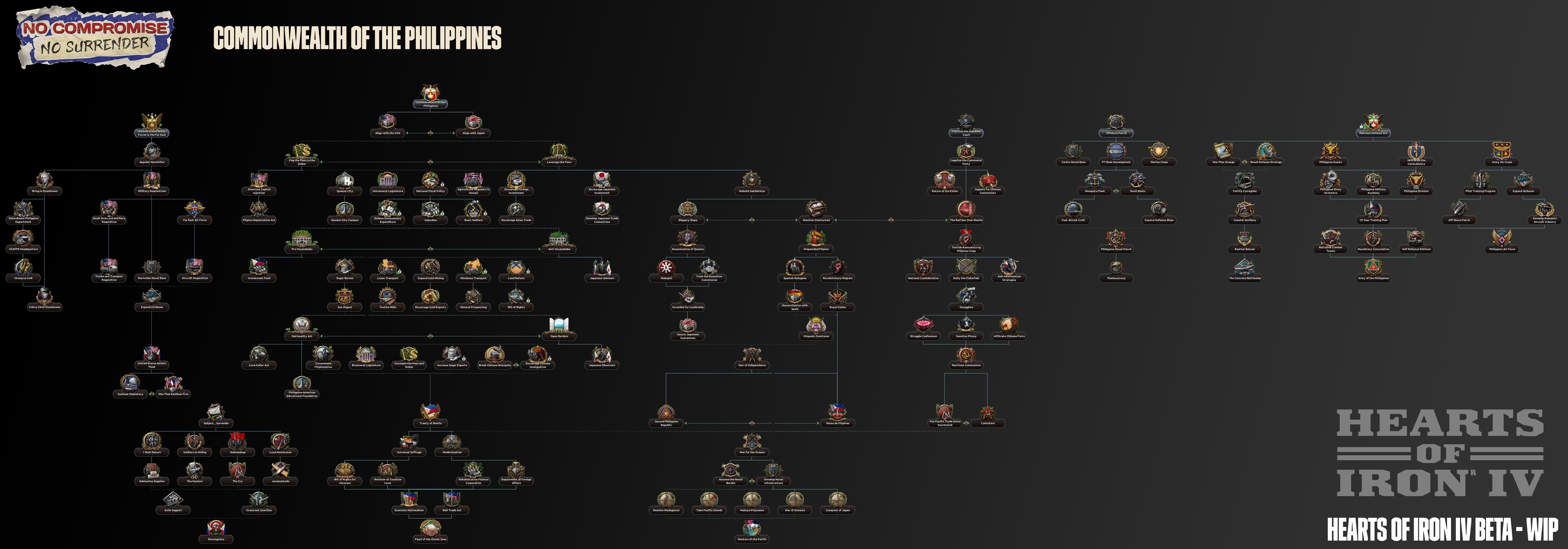
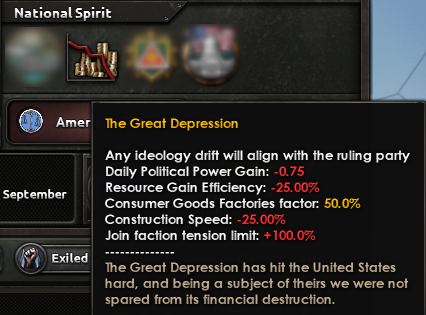
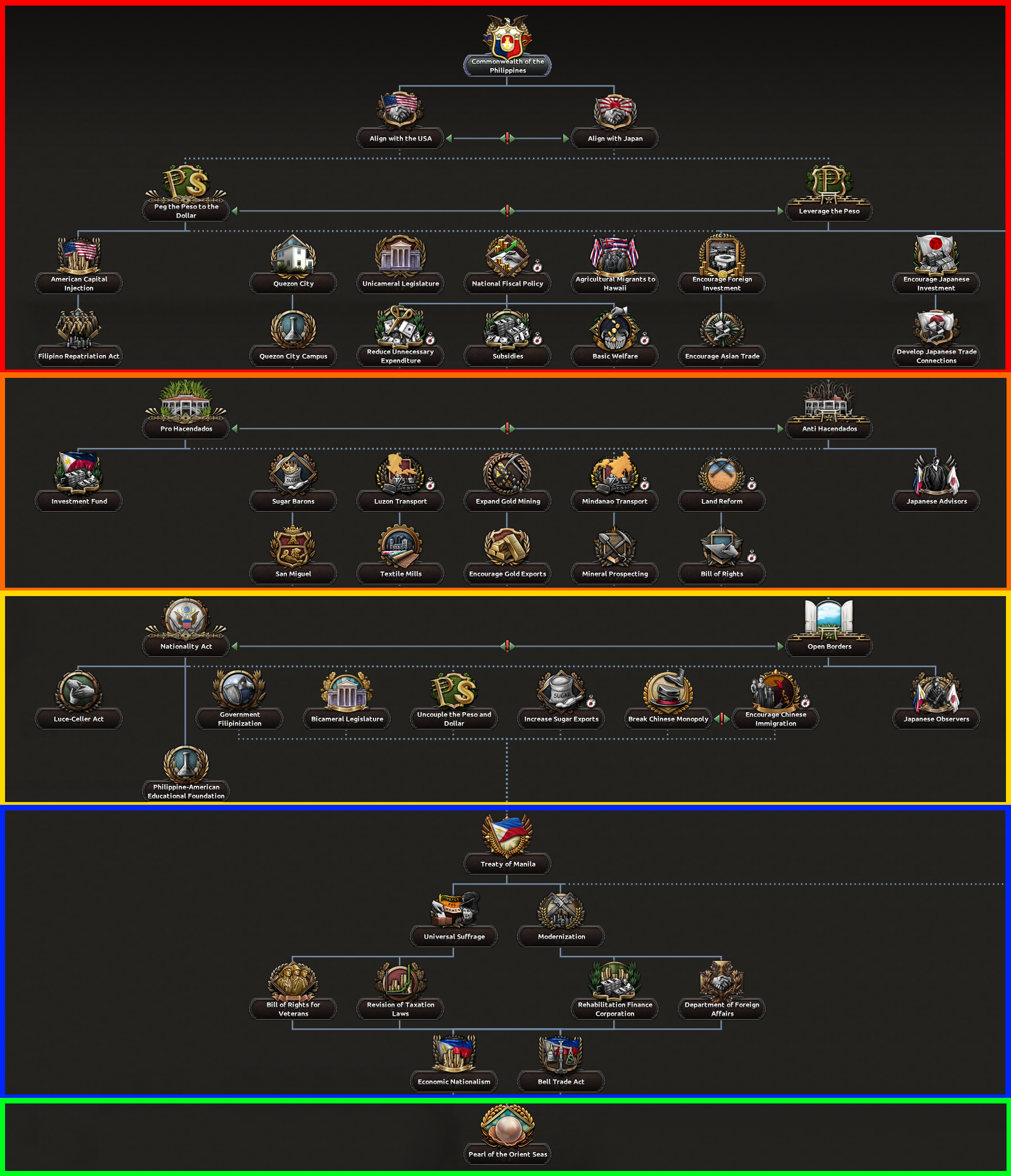

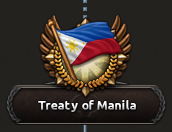
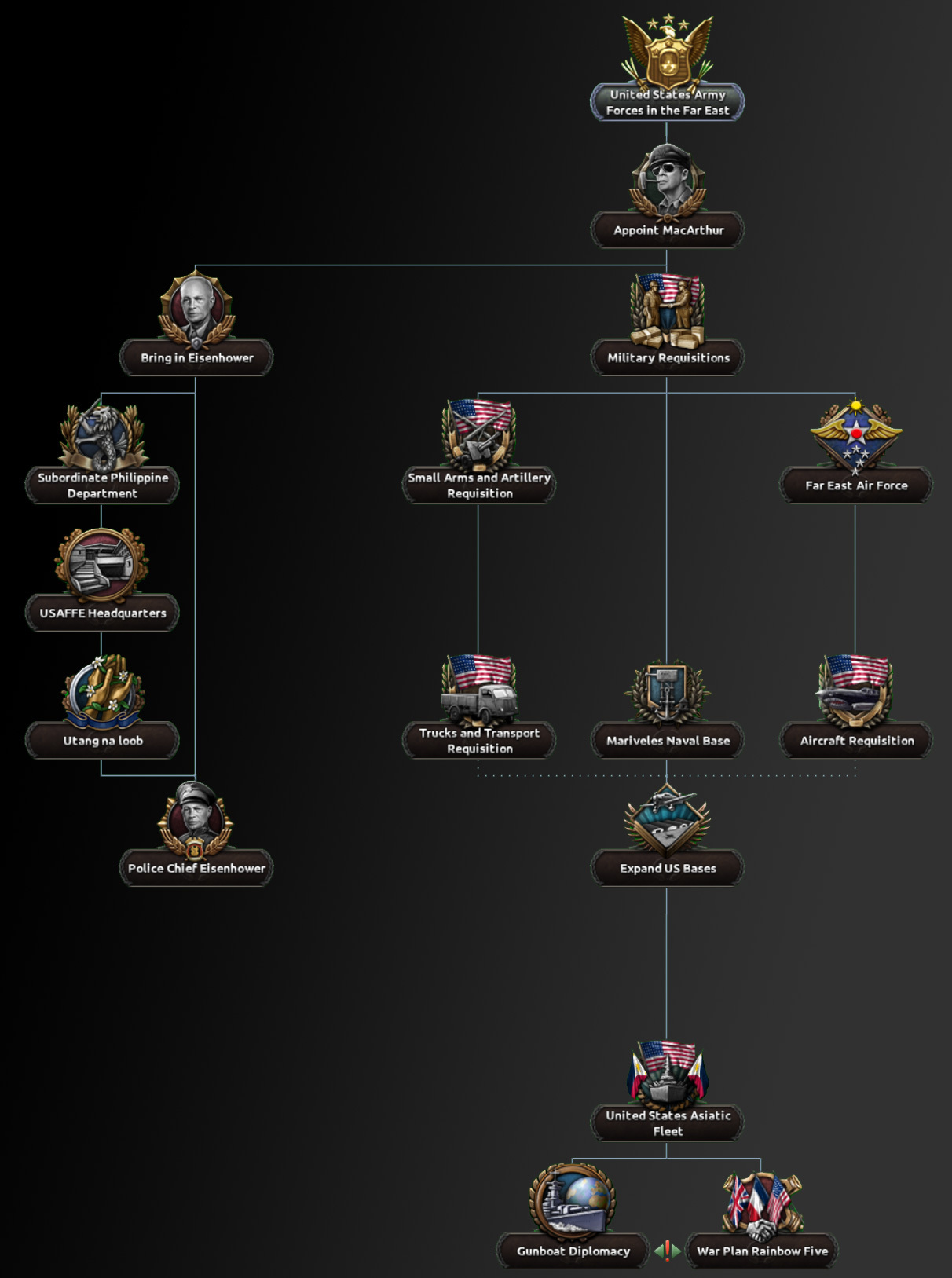

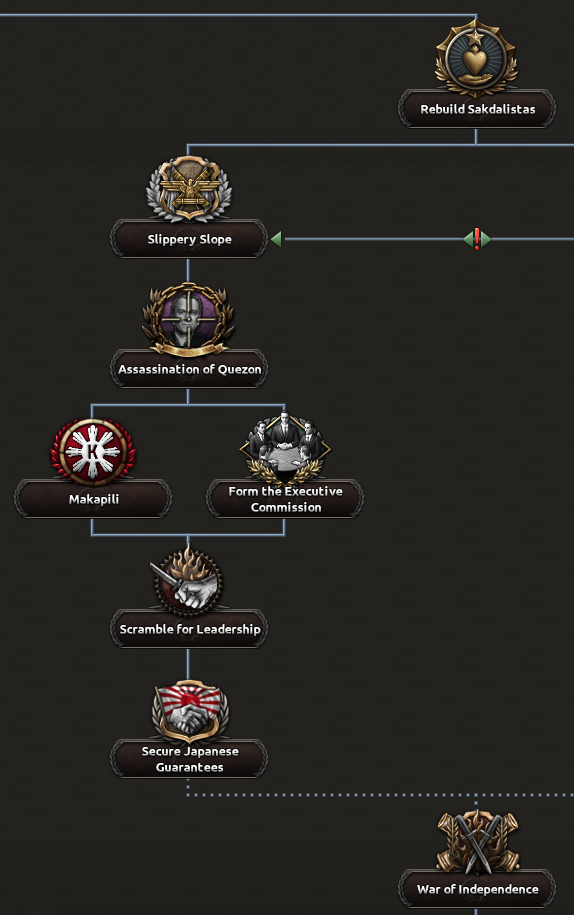


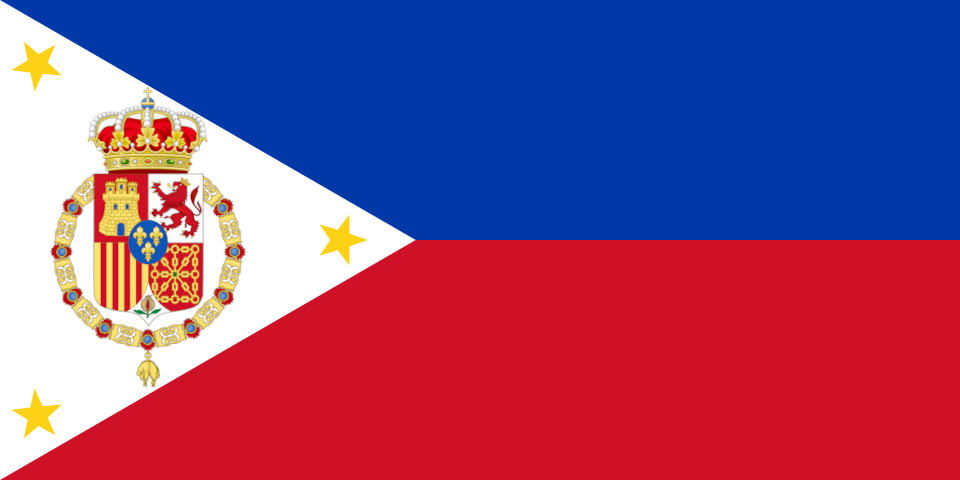

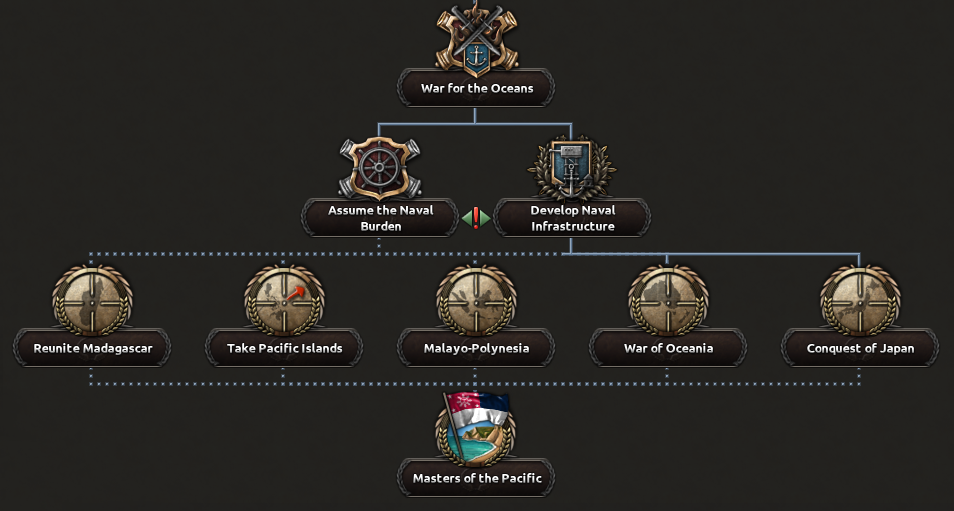
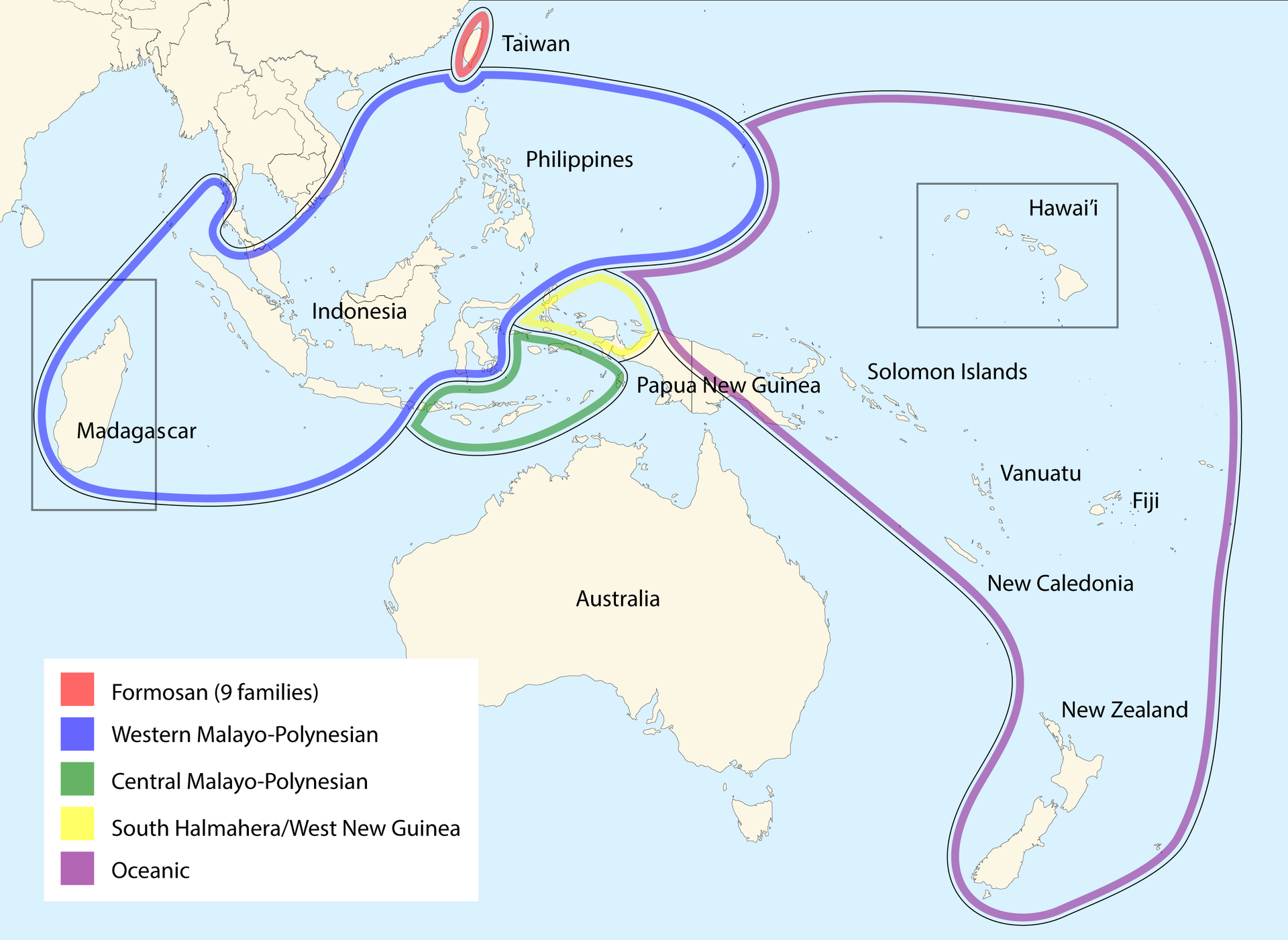
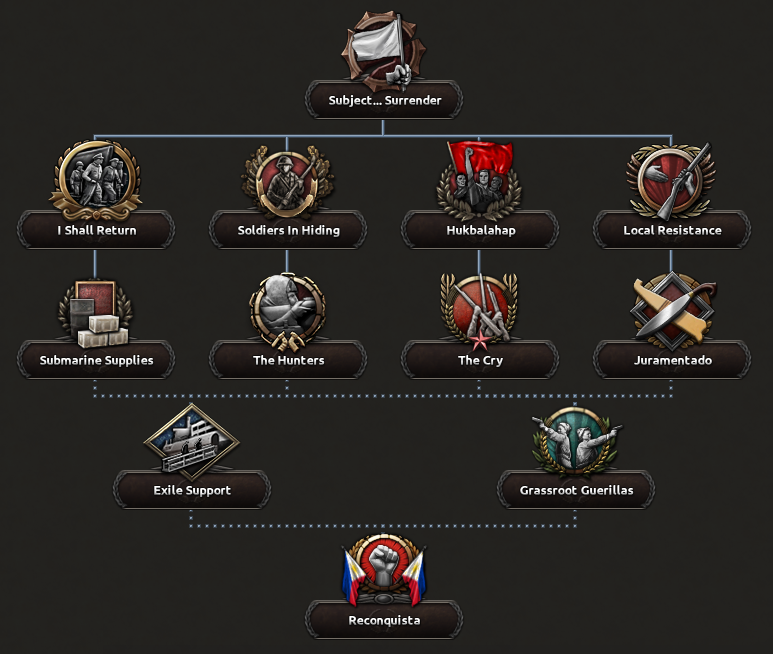

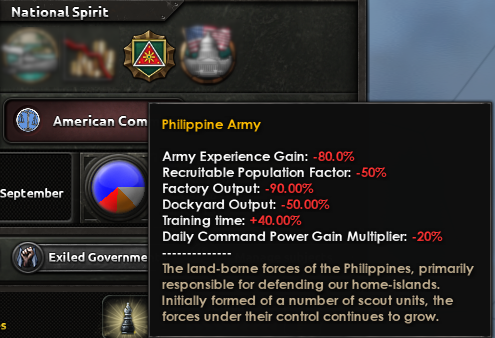



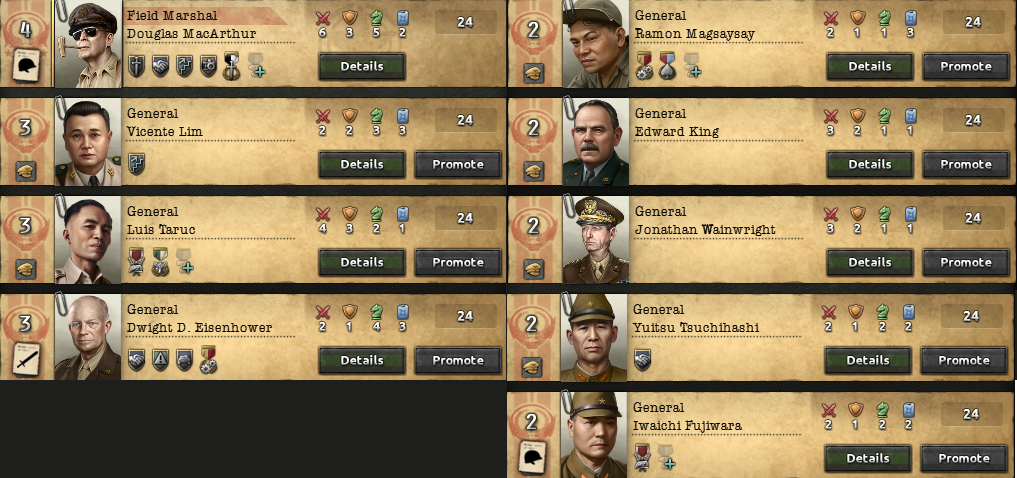


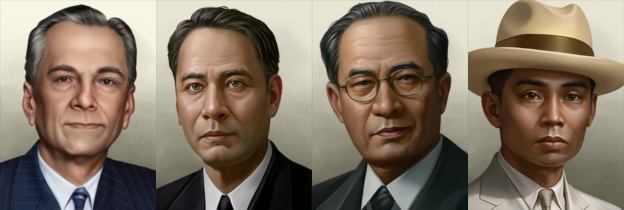
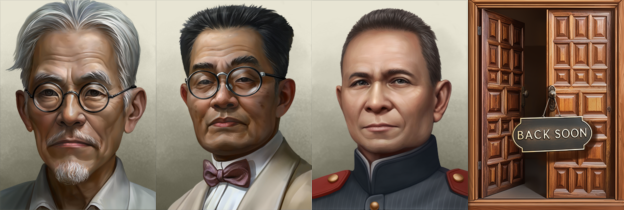
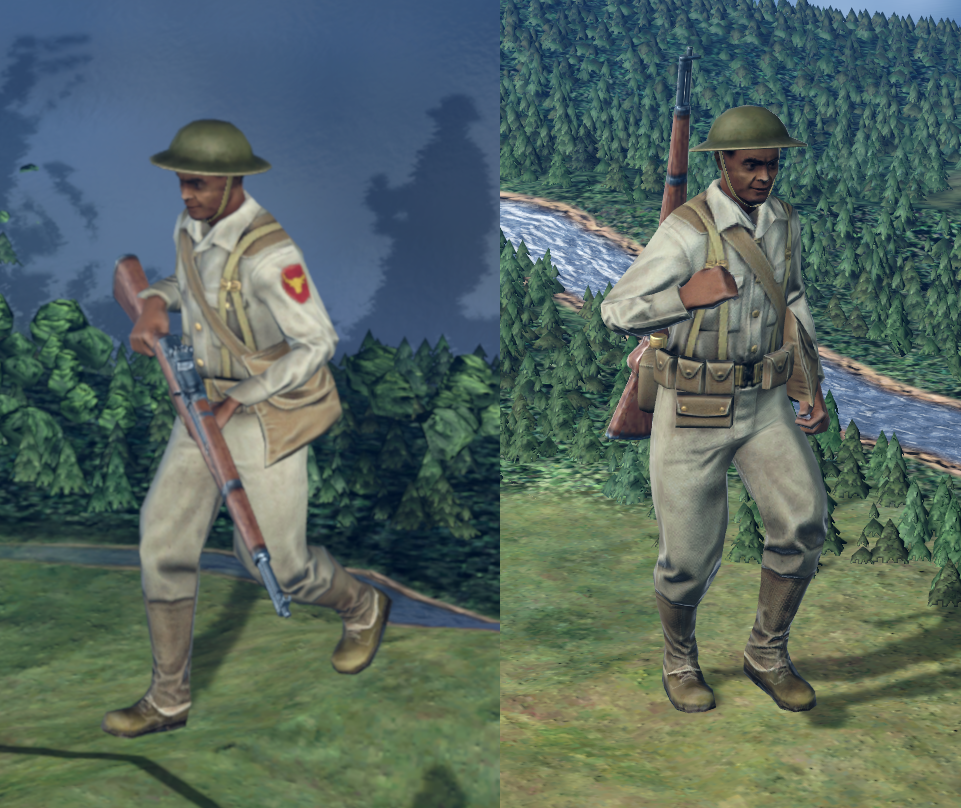
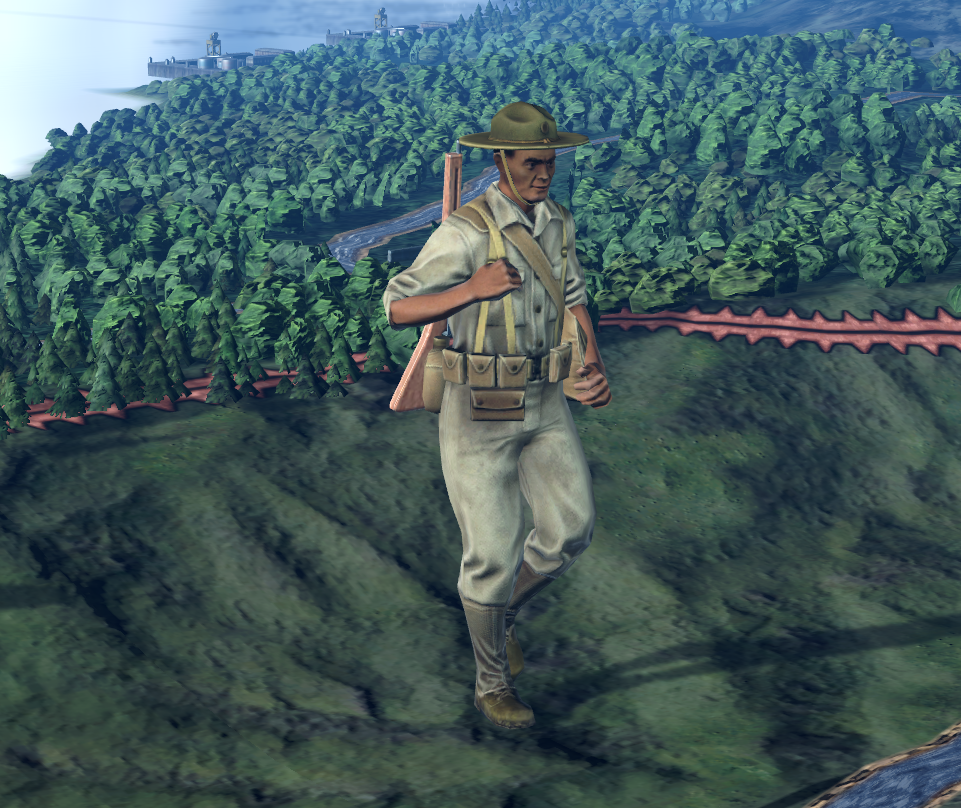
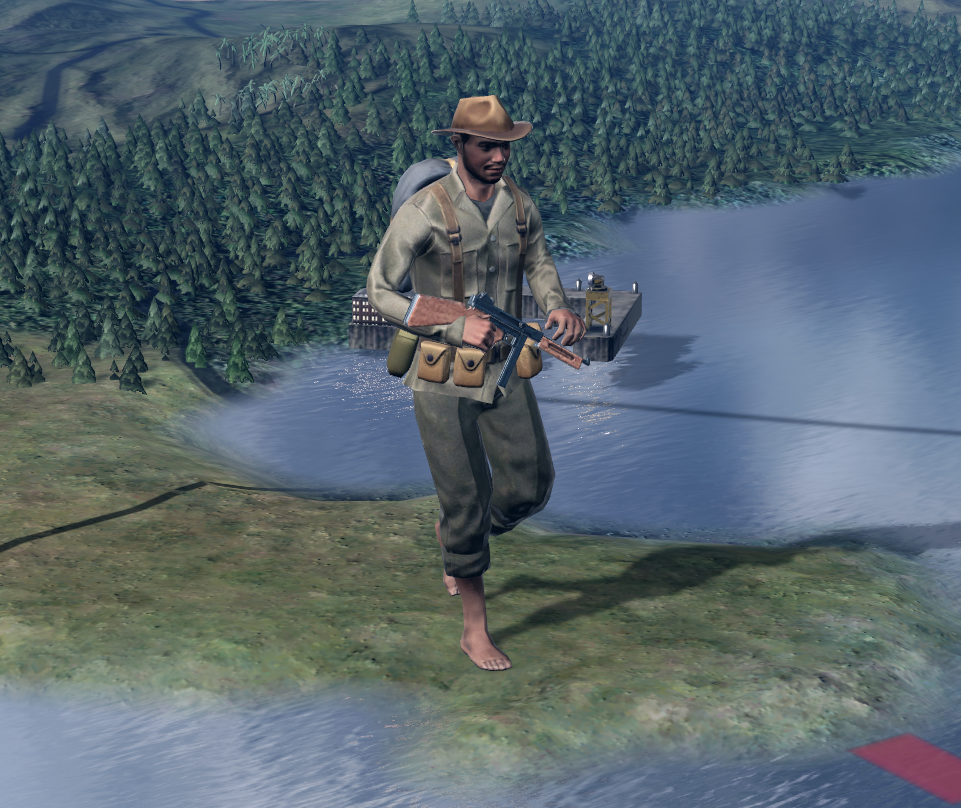
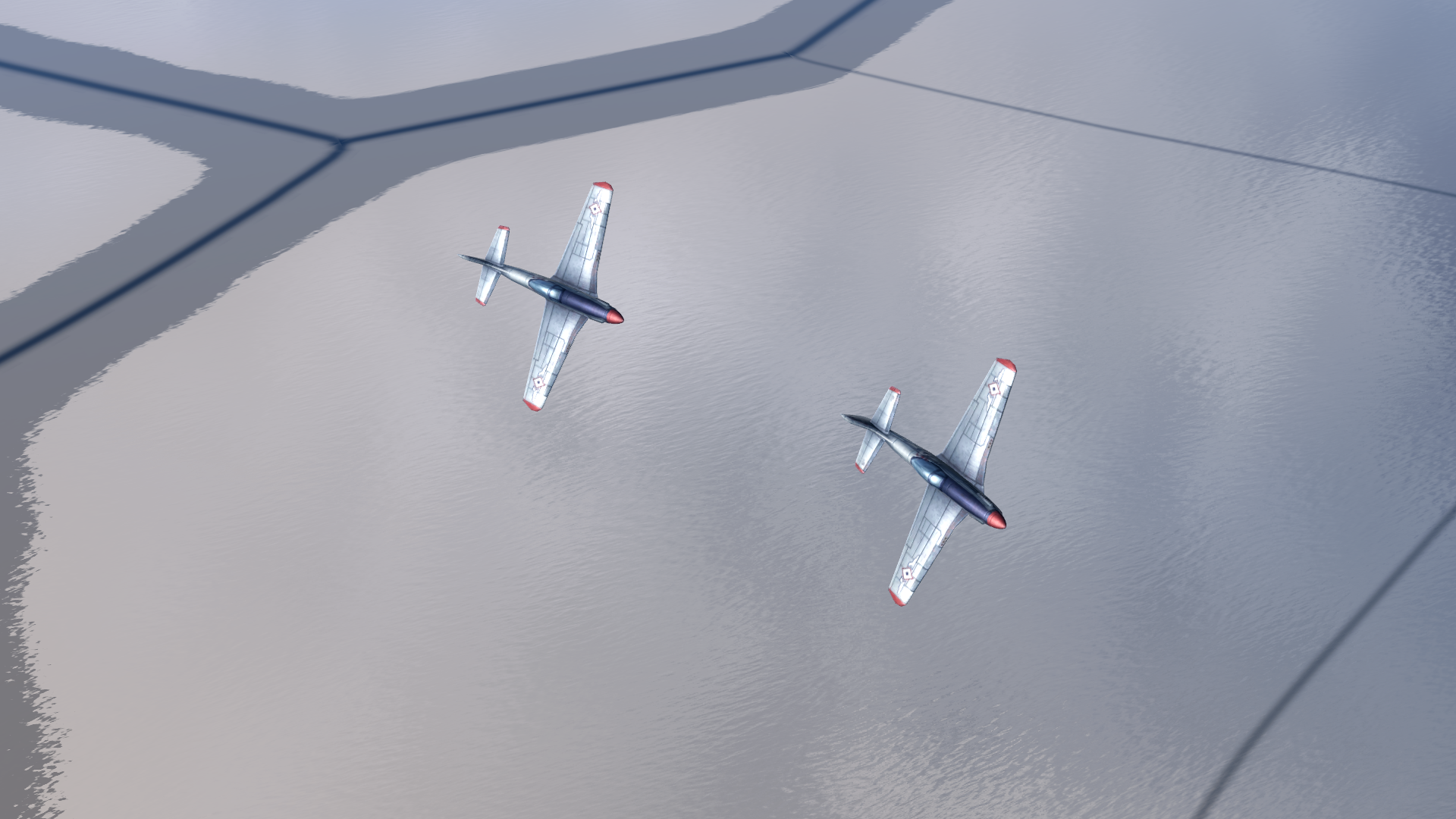

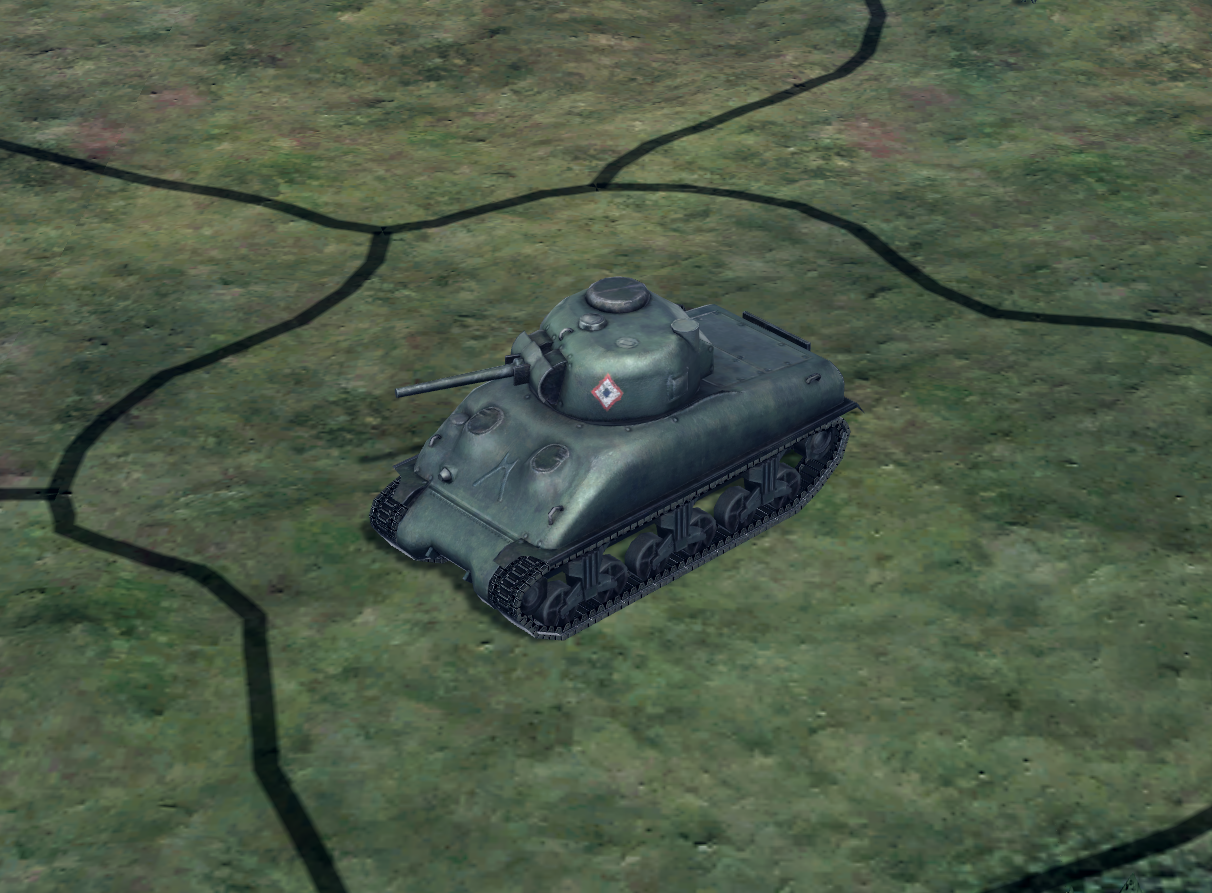

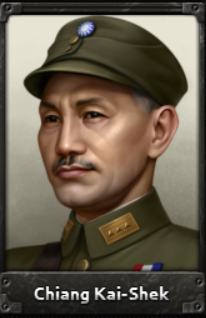
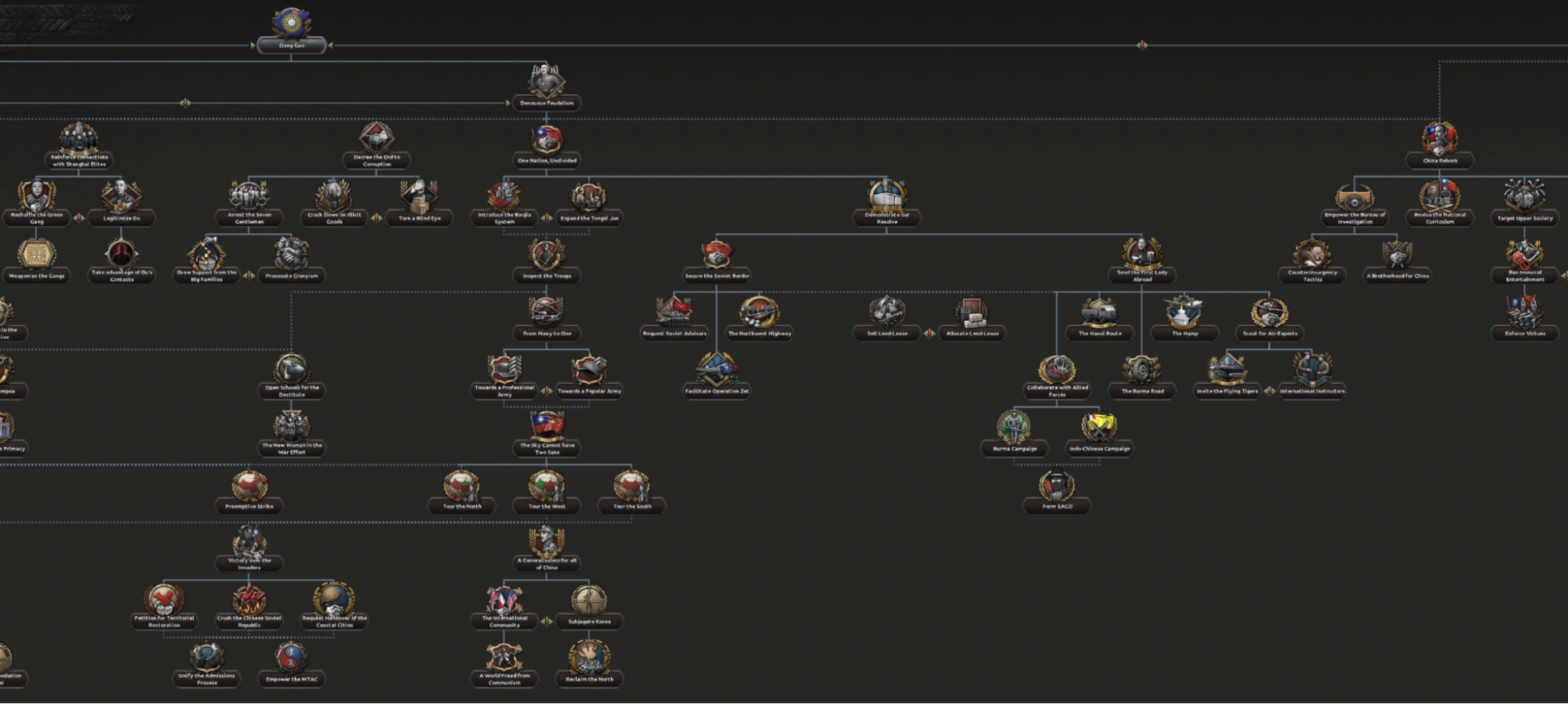

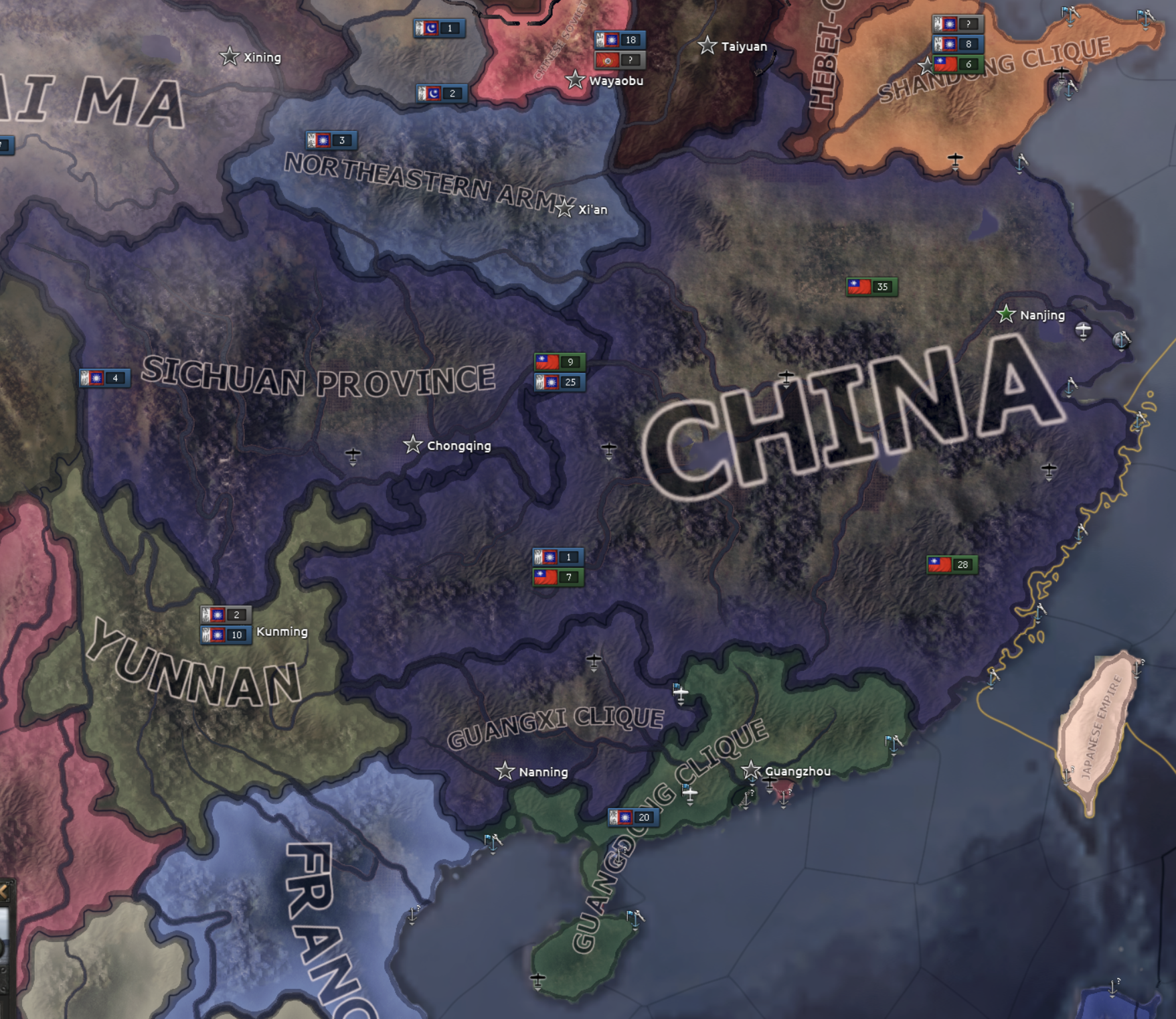
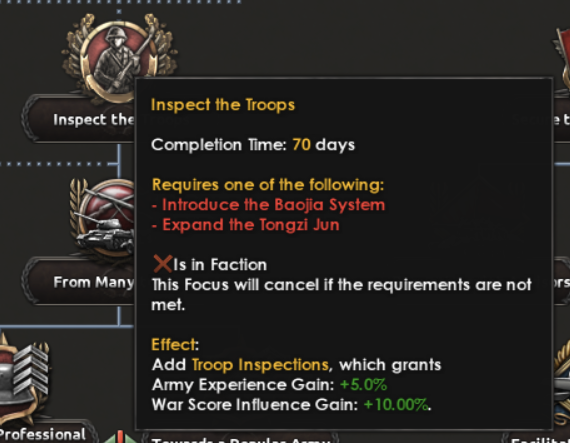
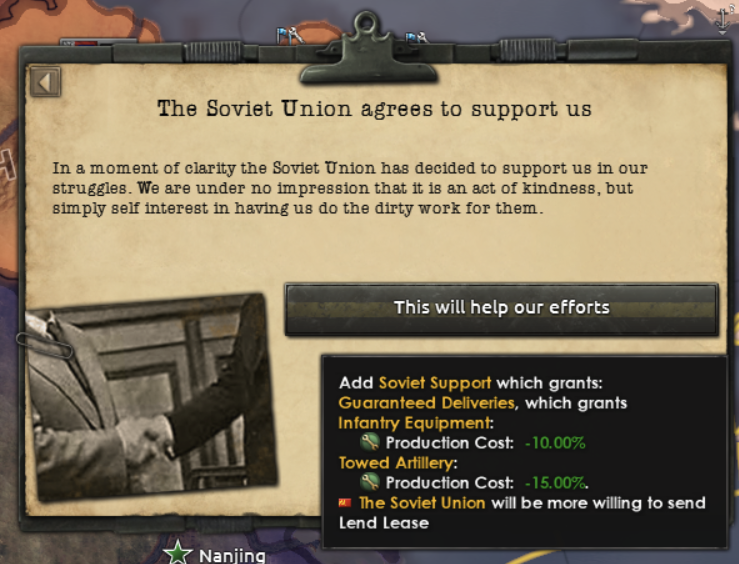
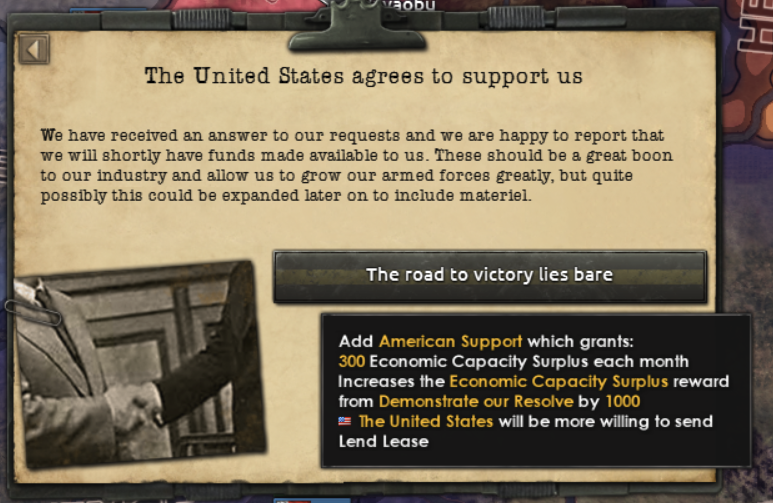

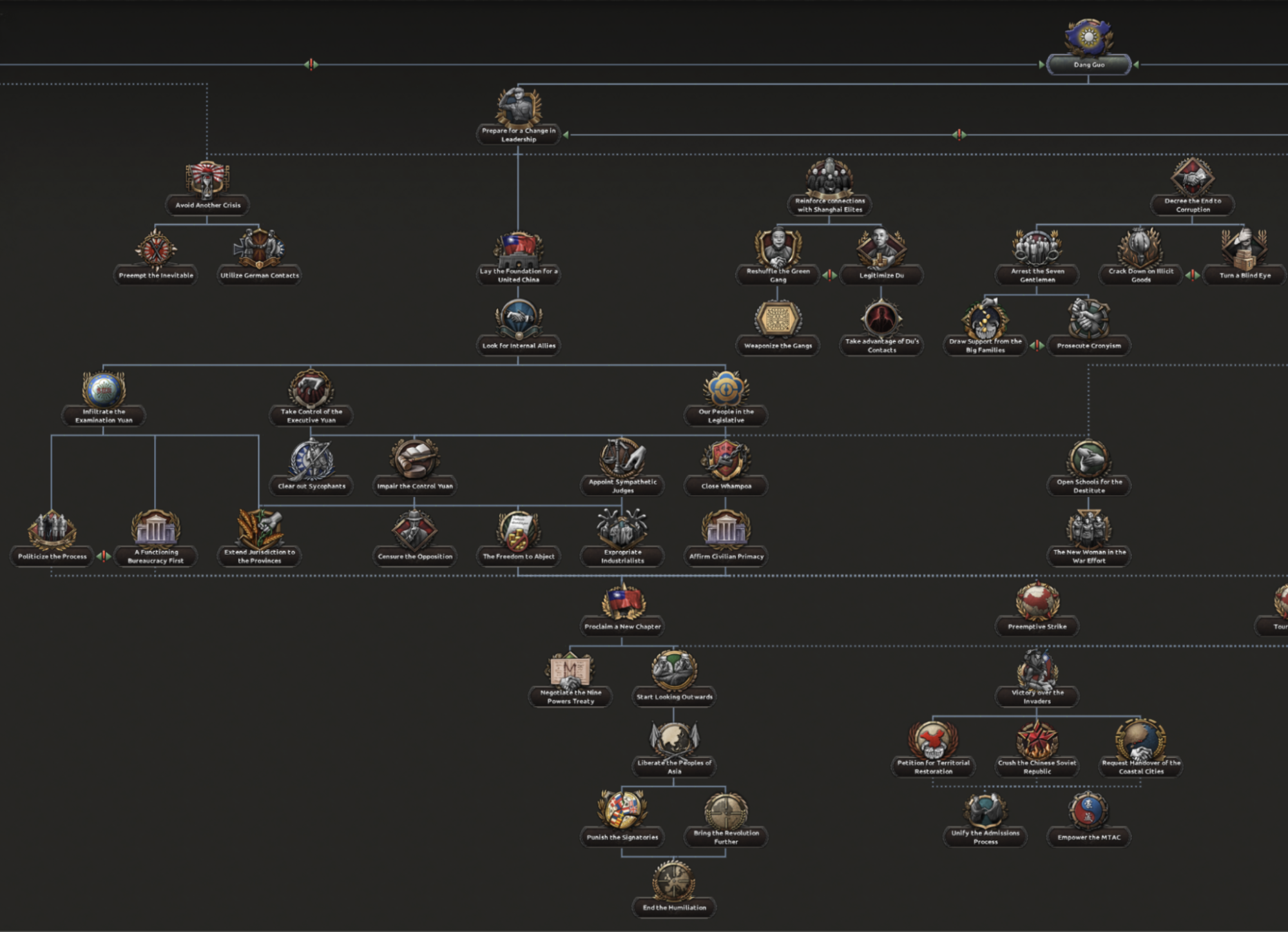
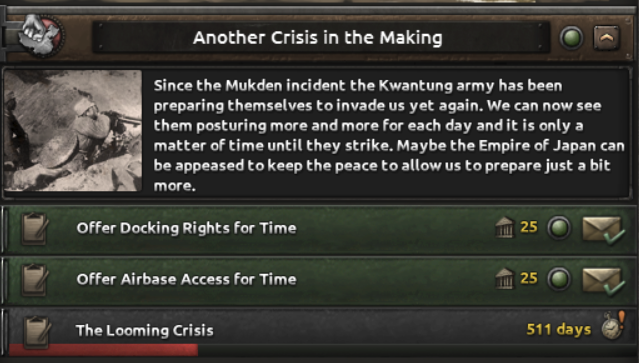
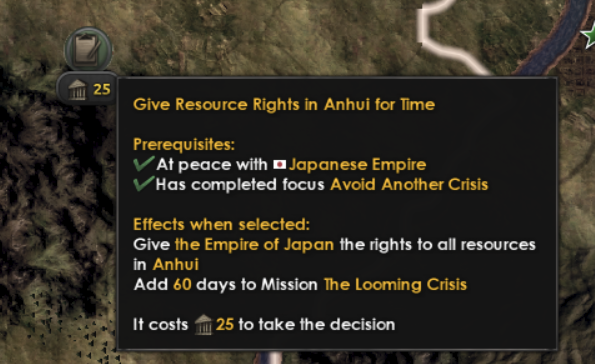
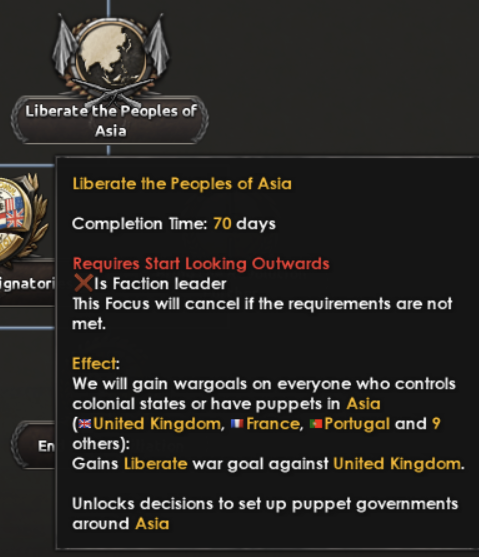
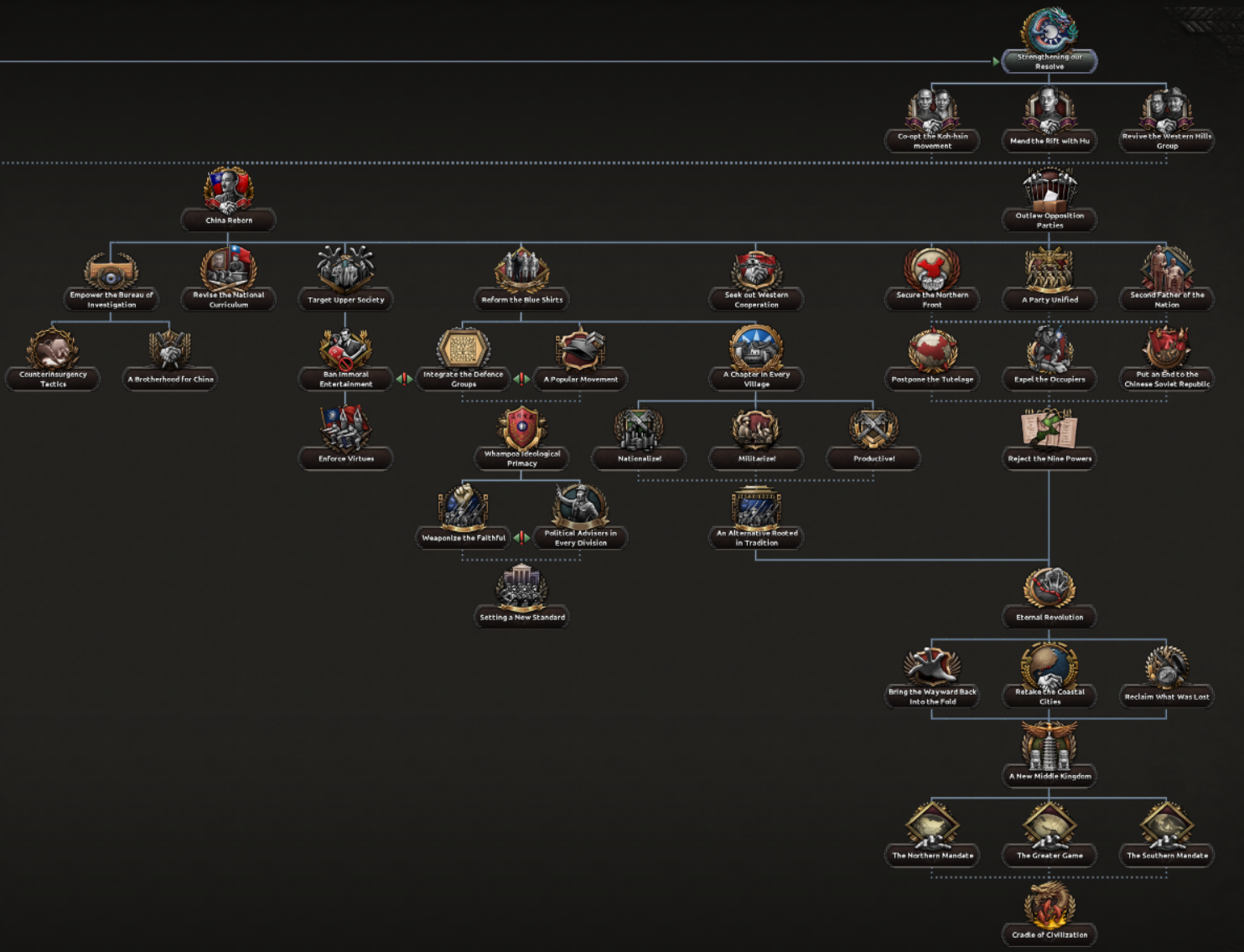
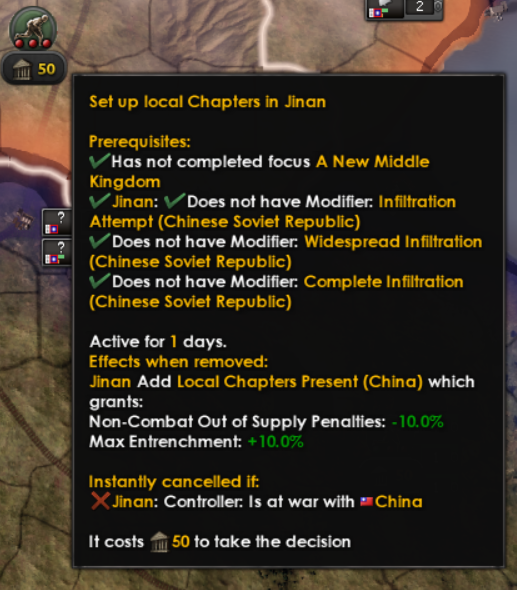


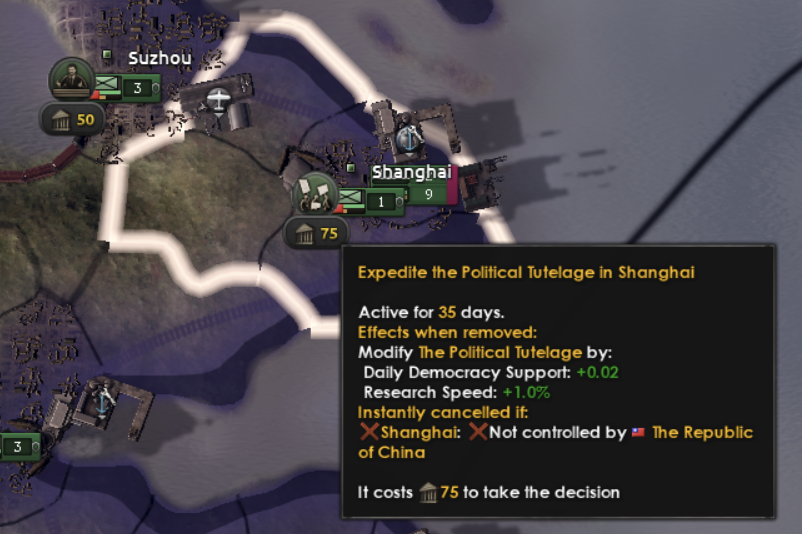

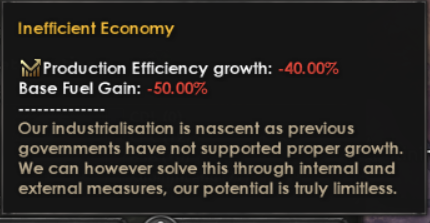
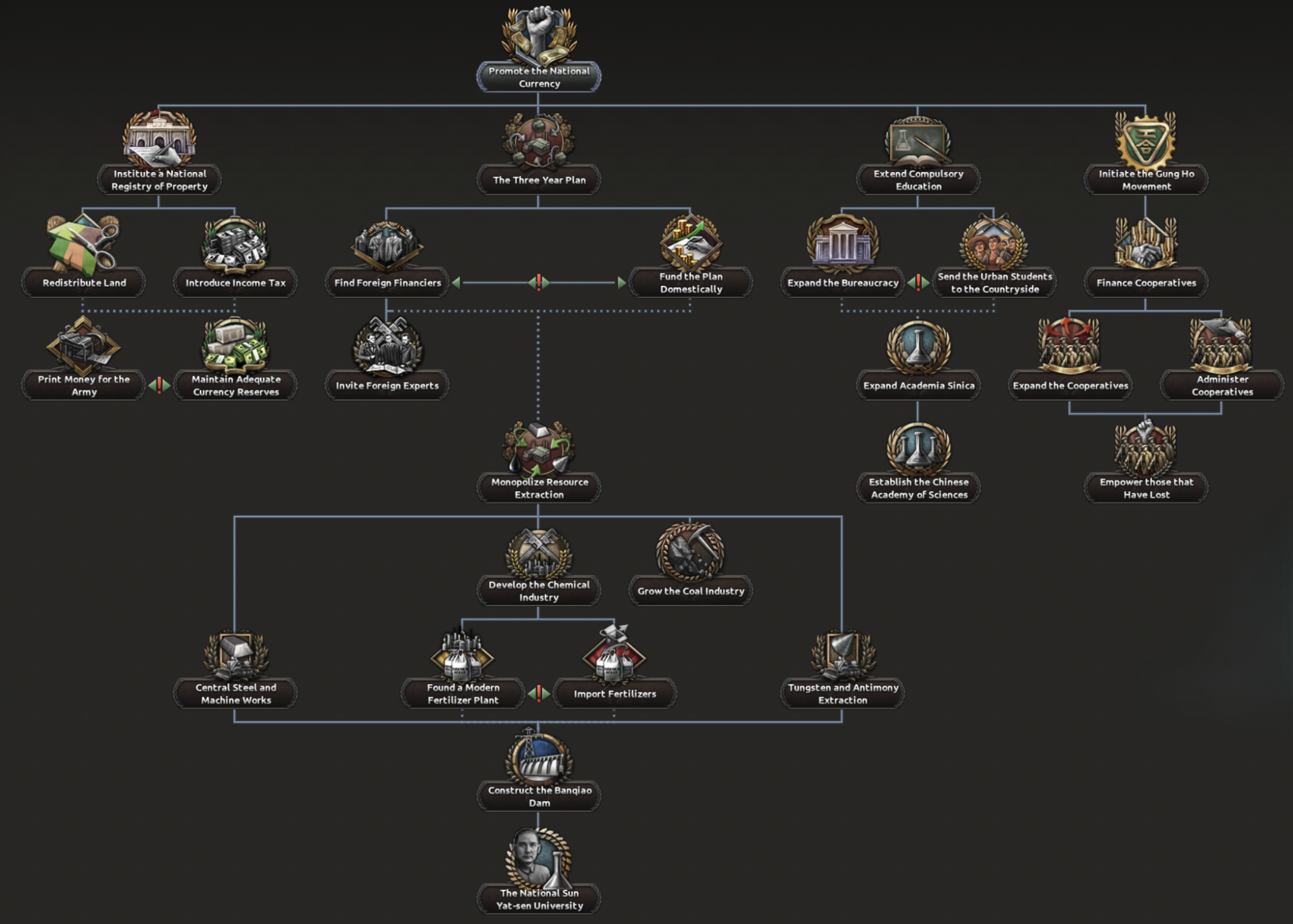
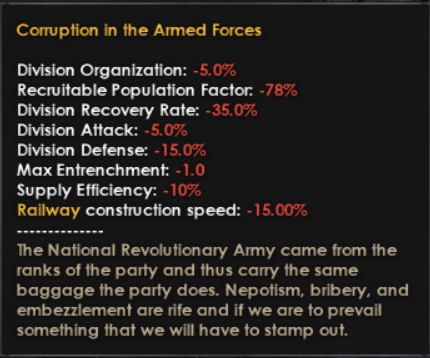

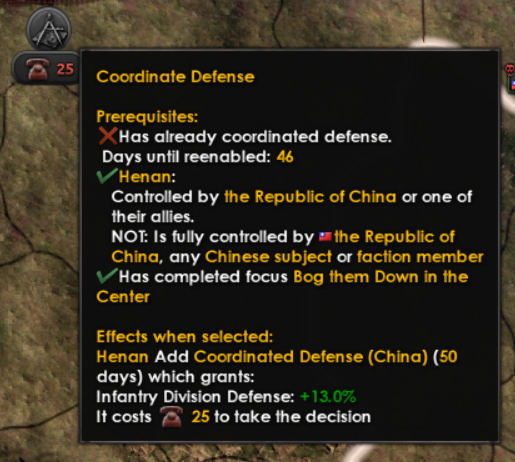

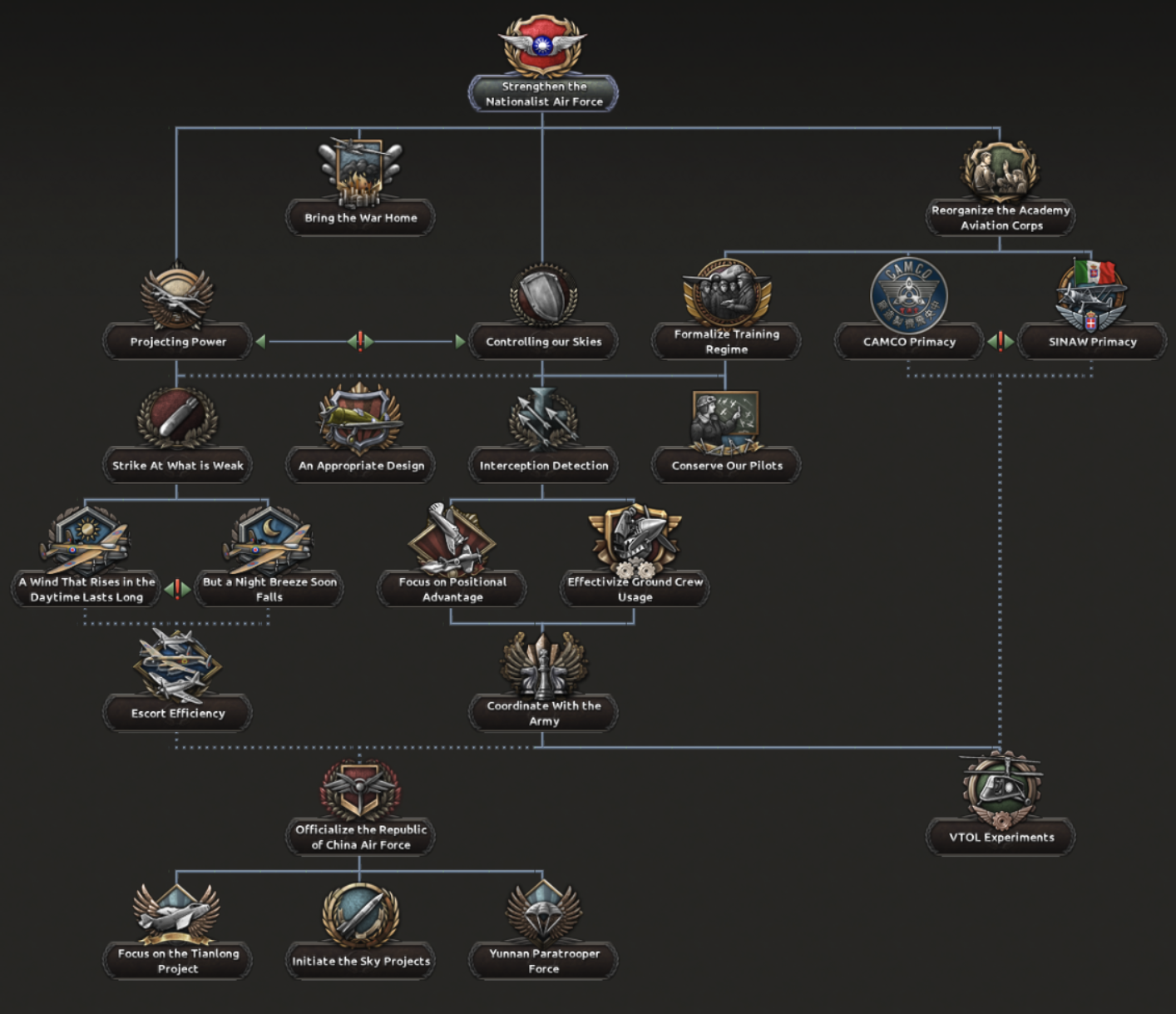
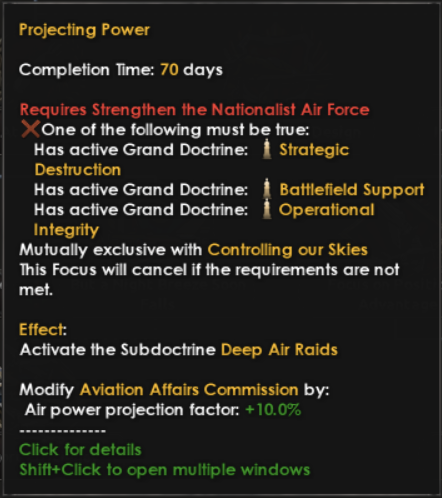
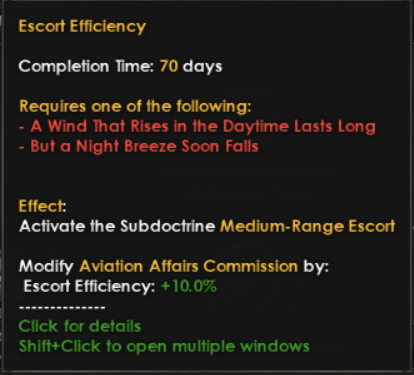
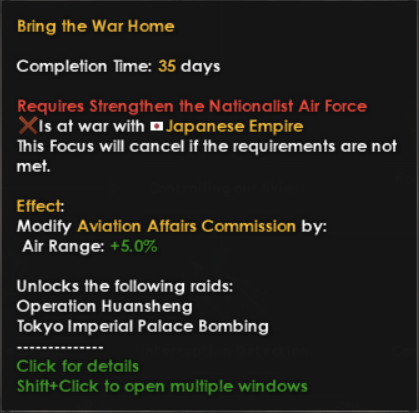
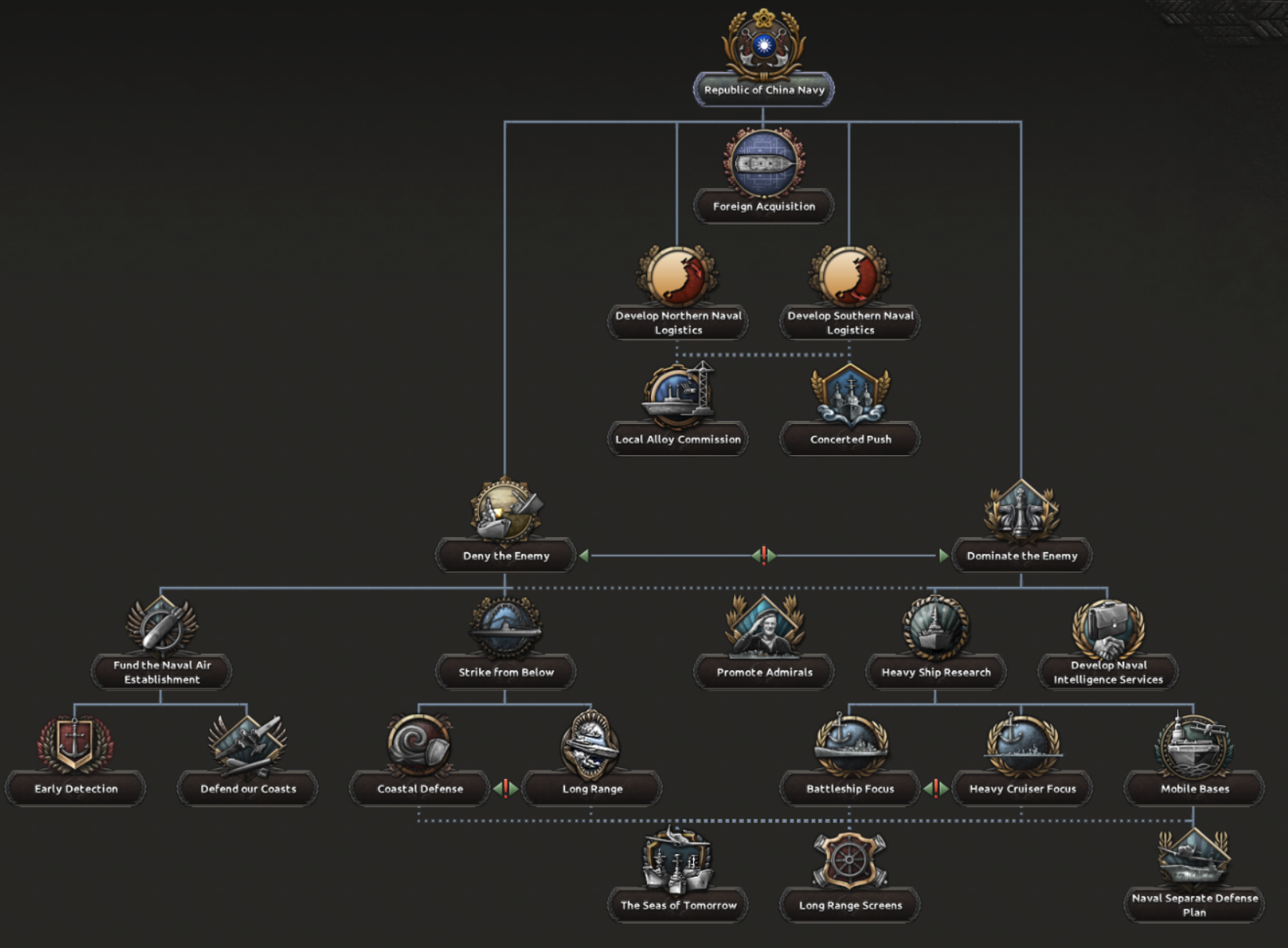


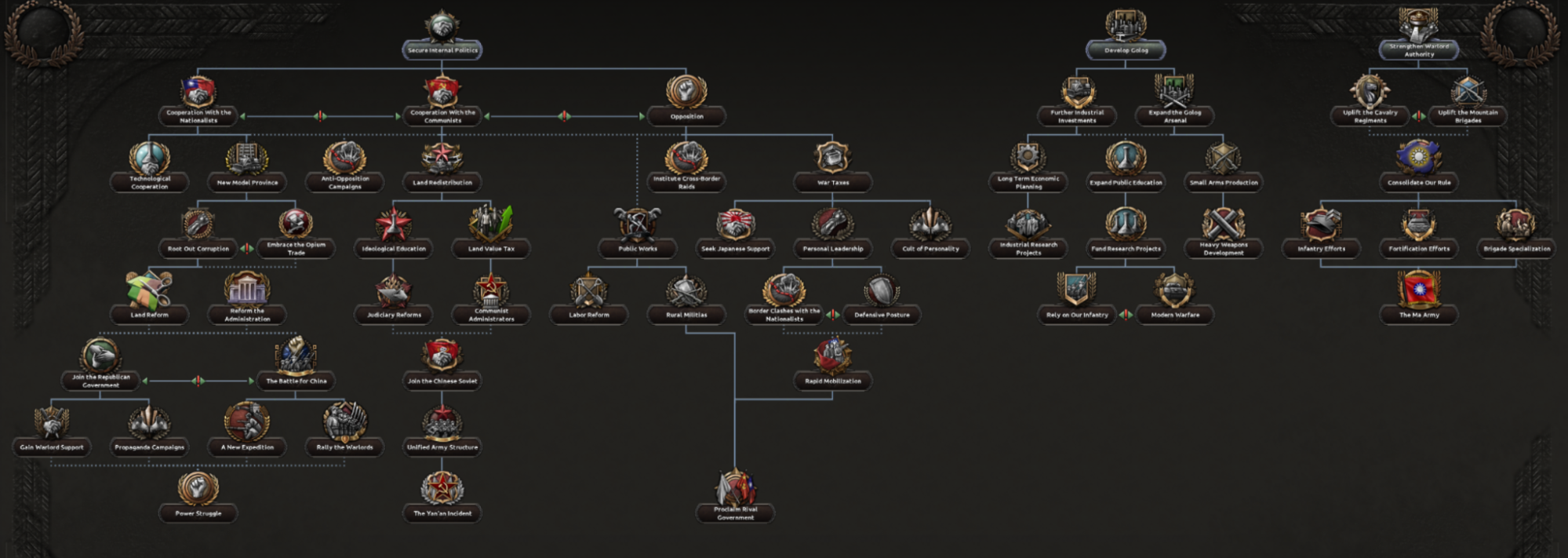
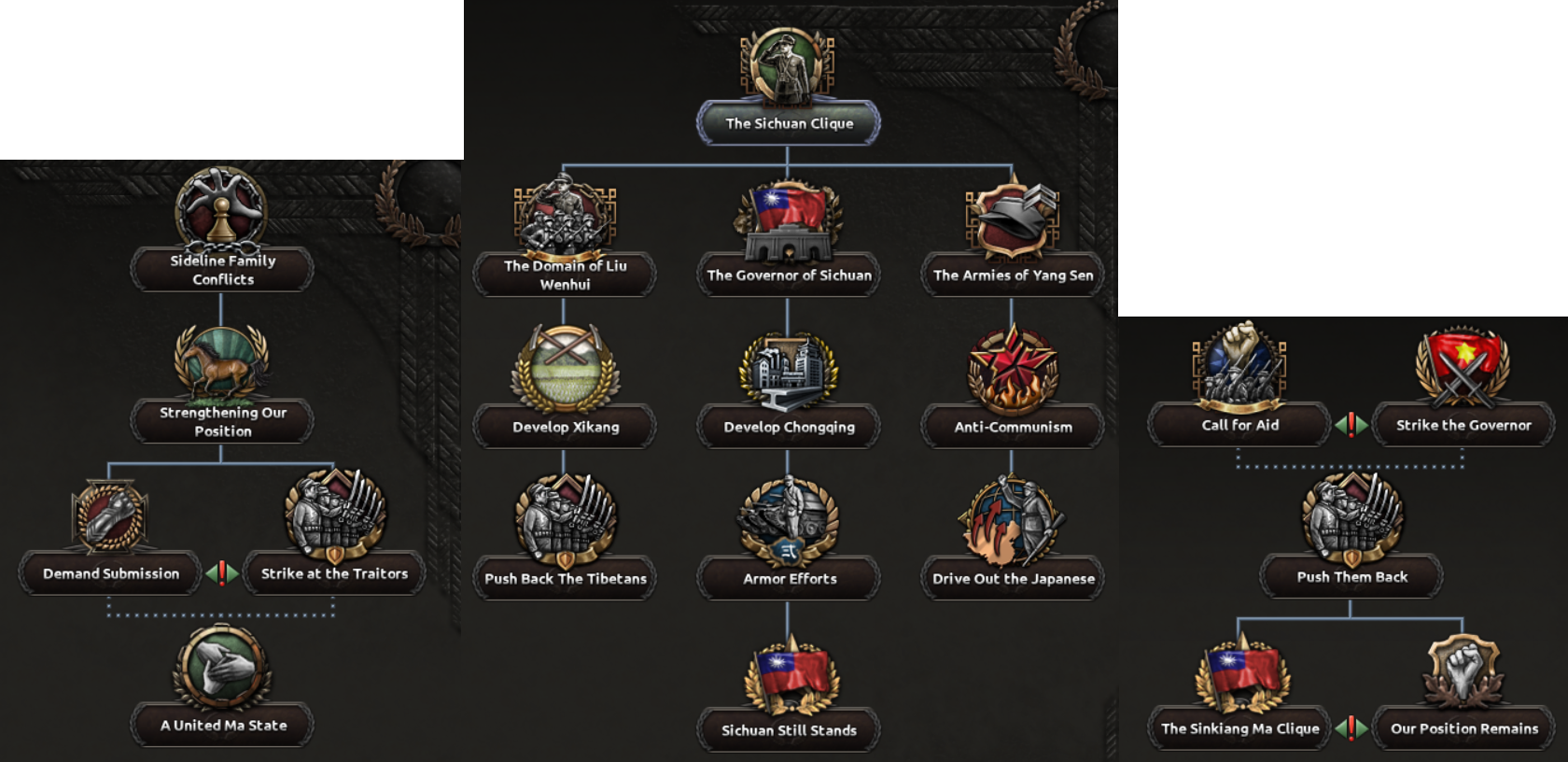
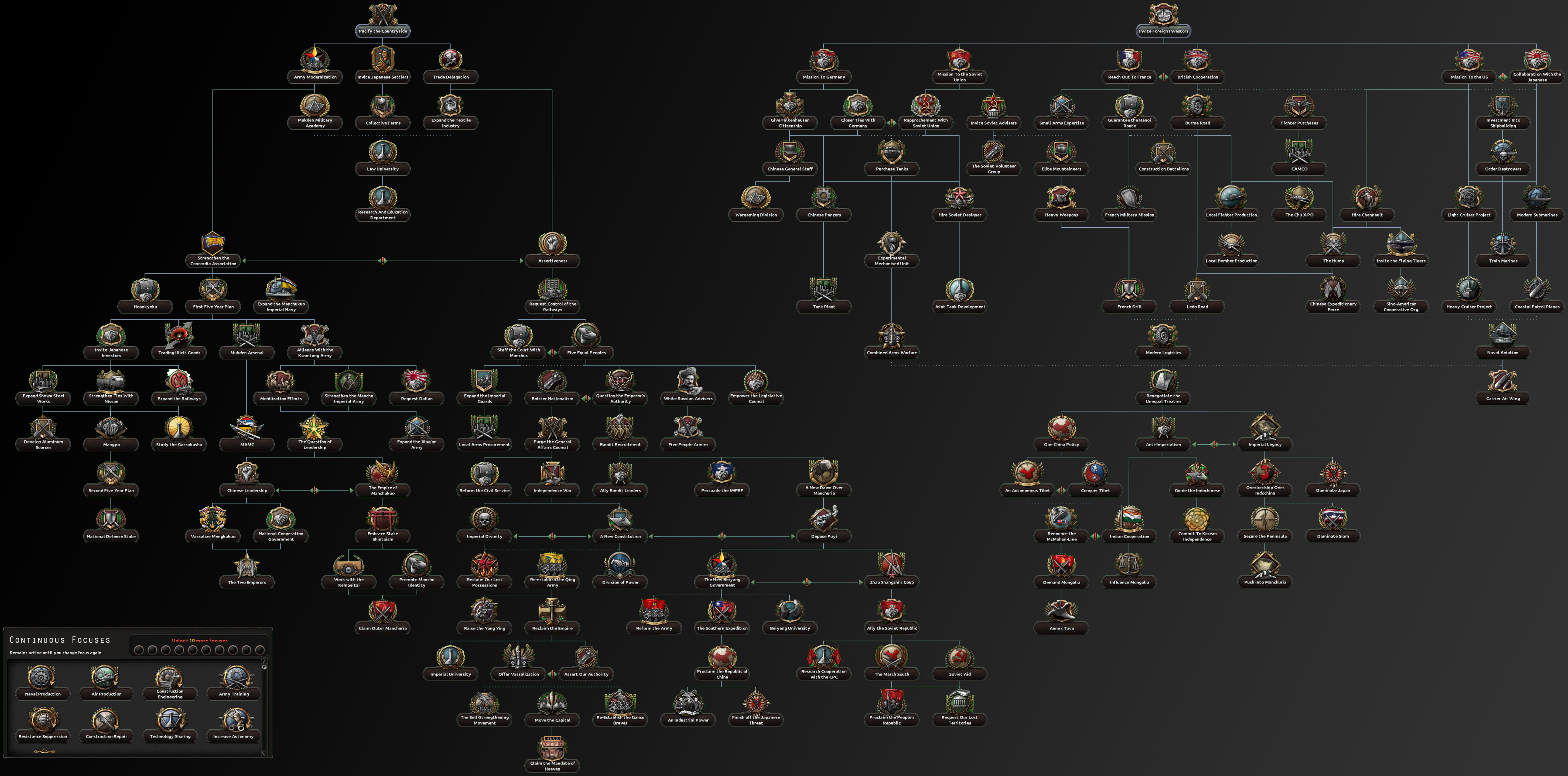

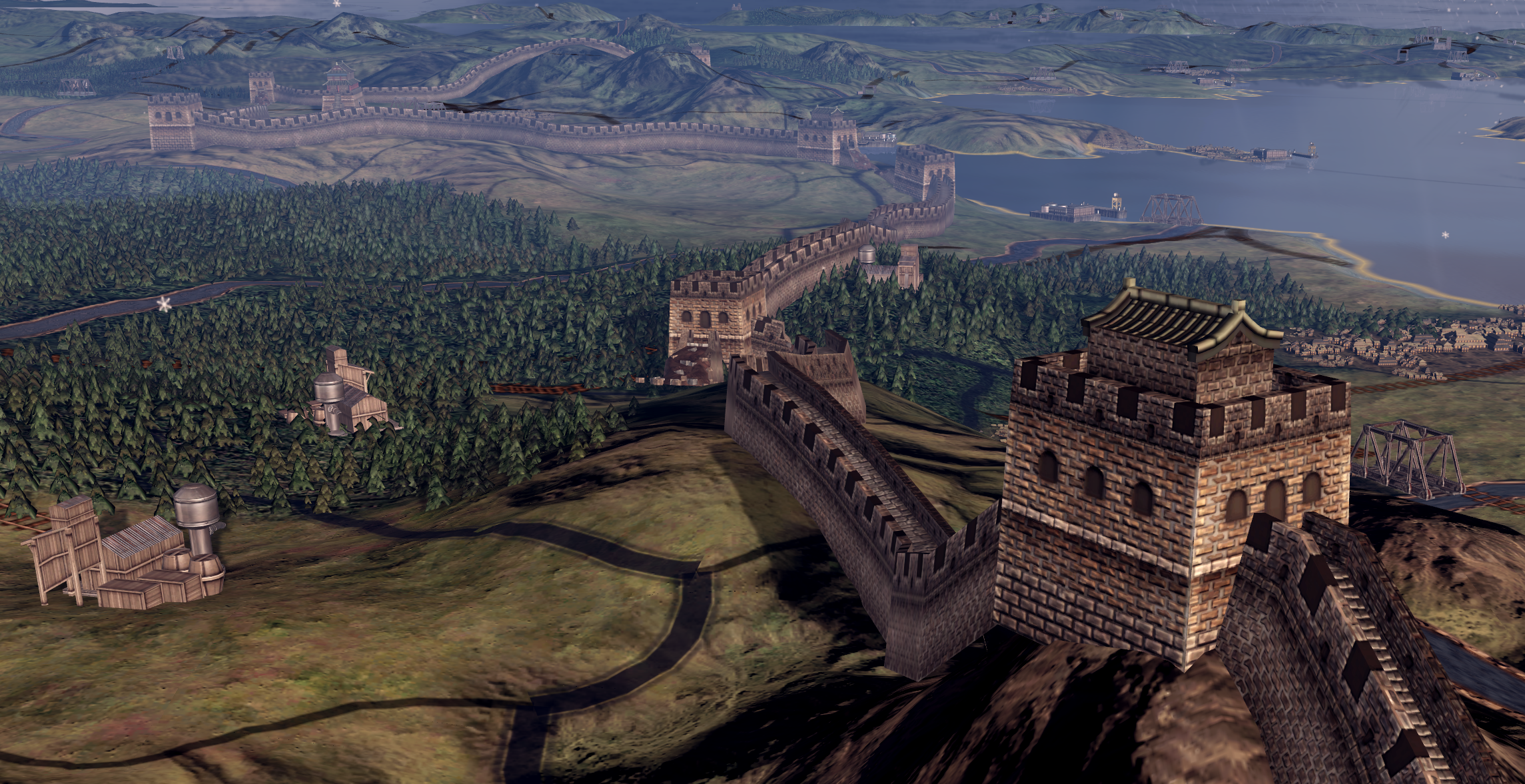

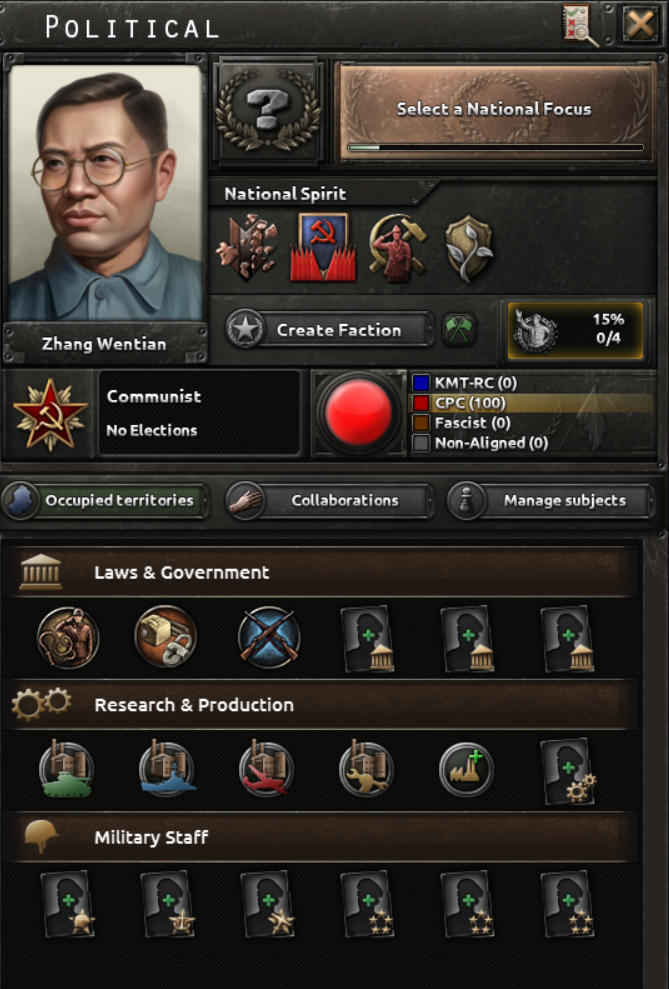
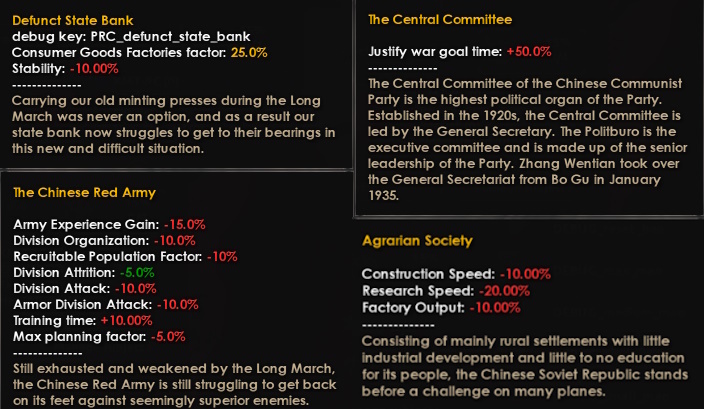

 Old / New
Old / New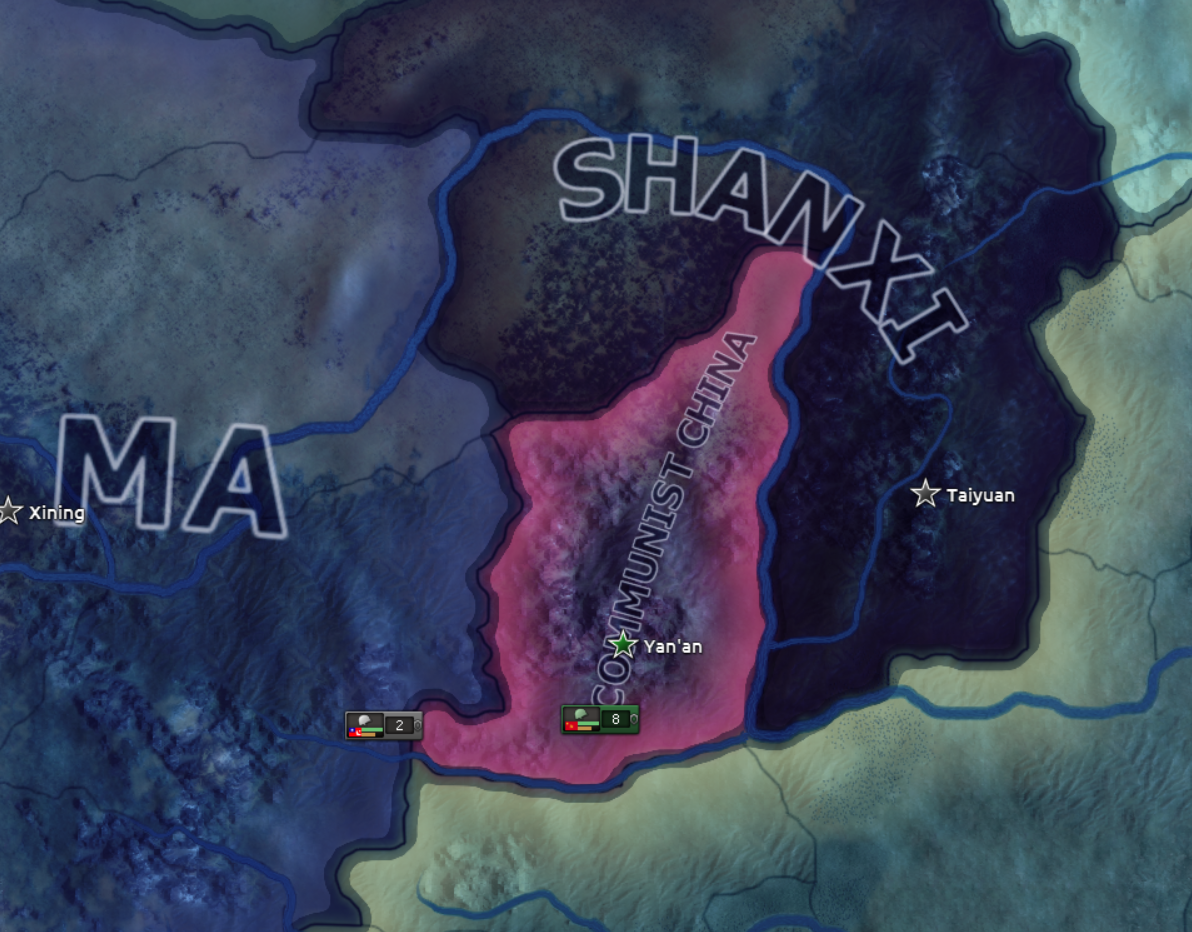
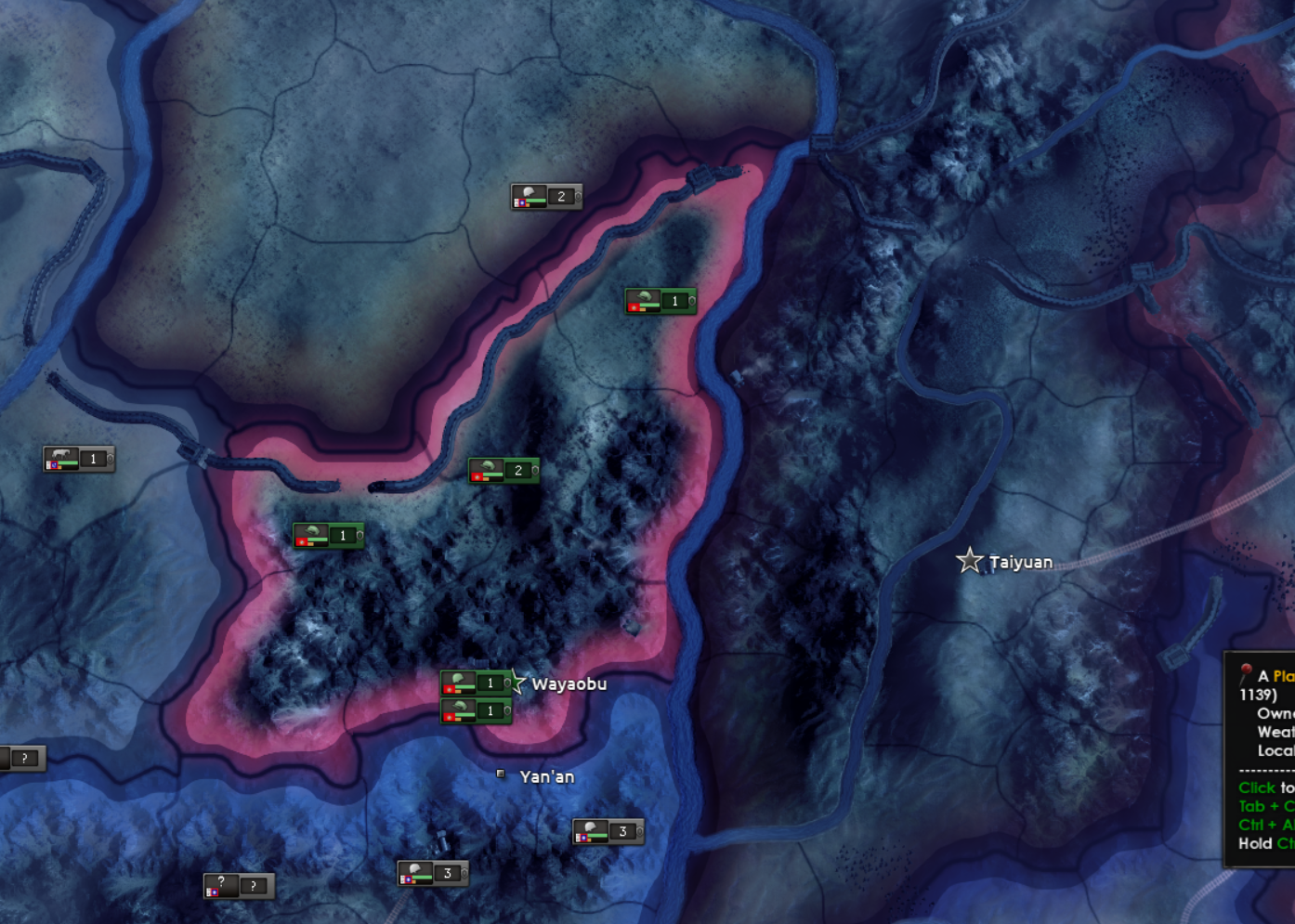 Old start position and new
Old start position and new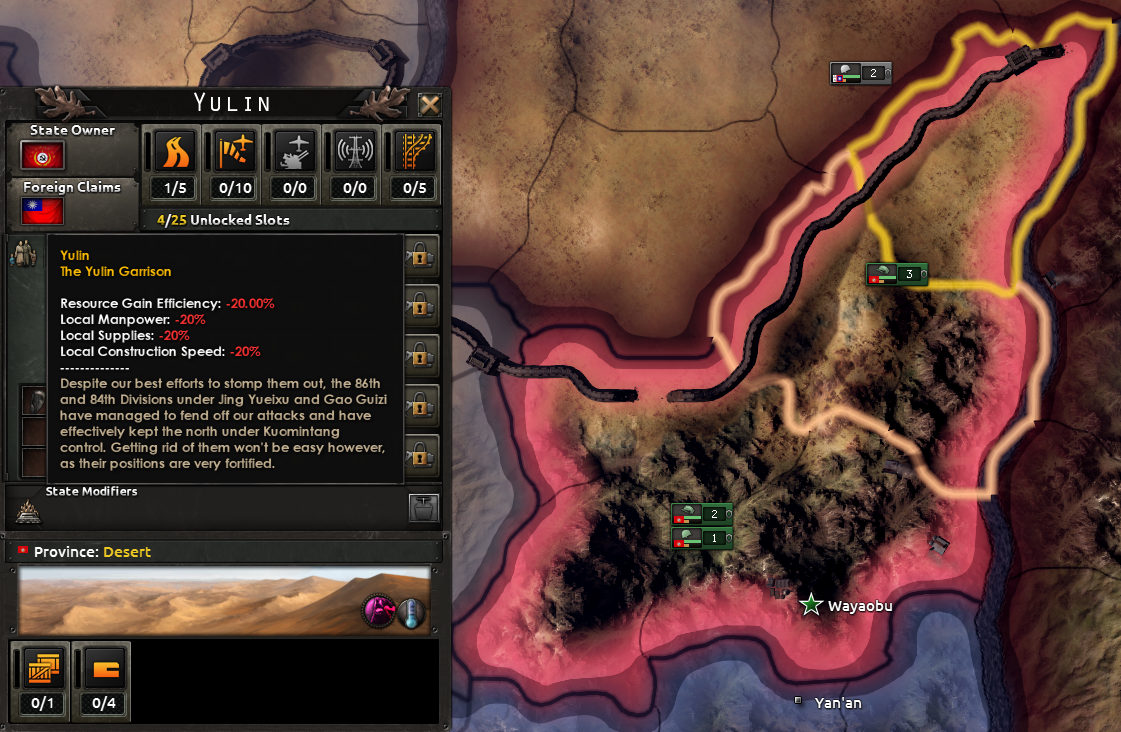
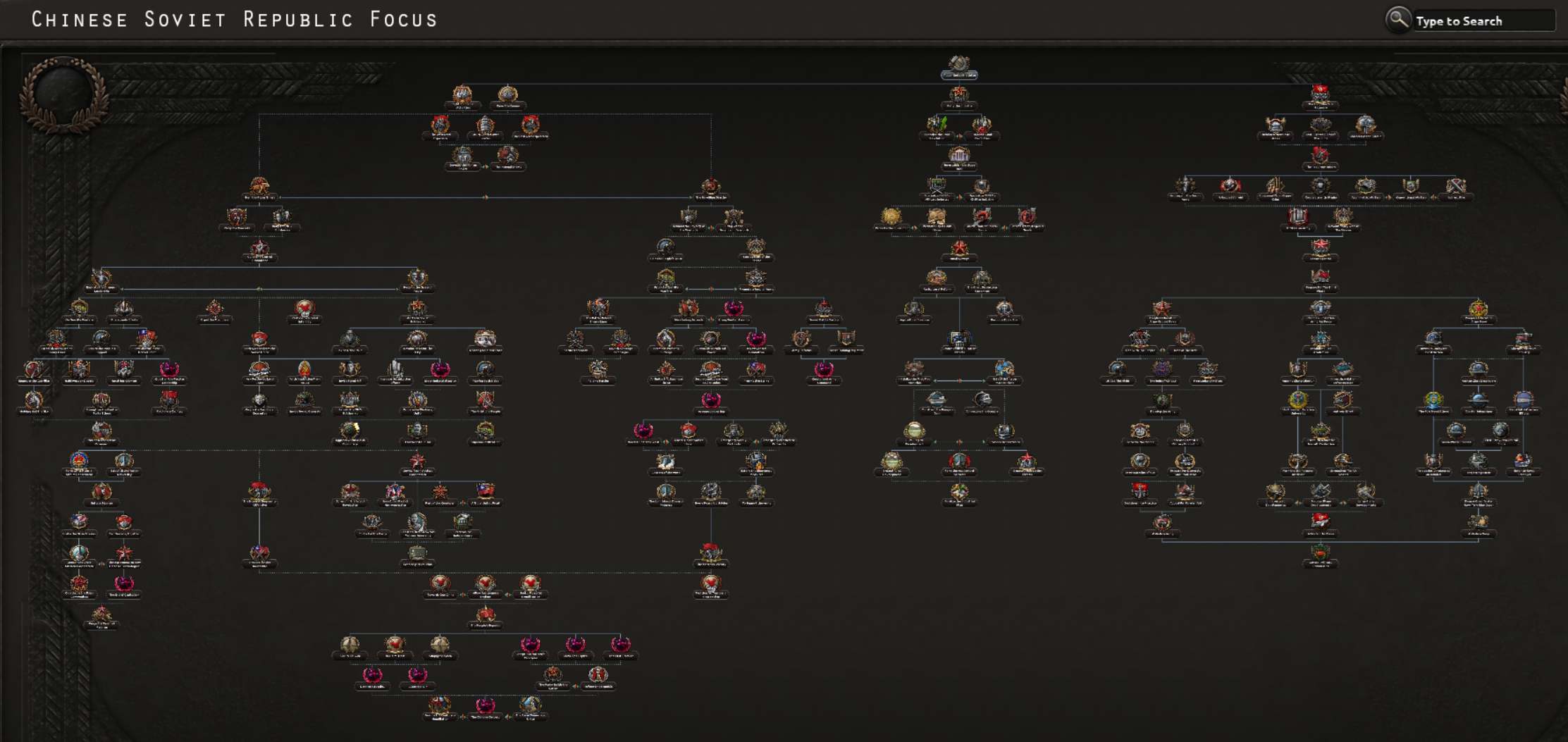
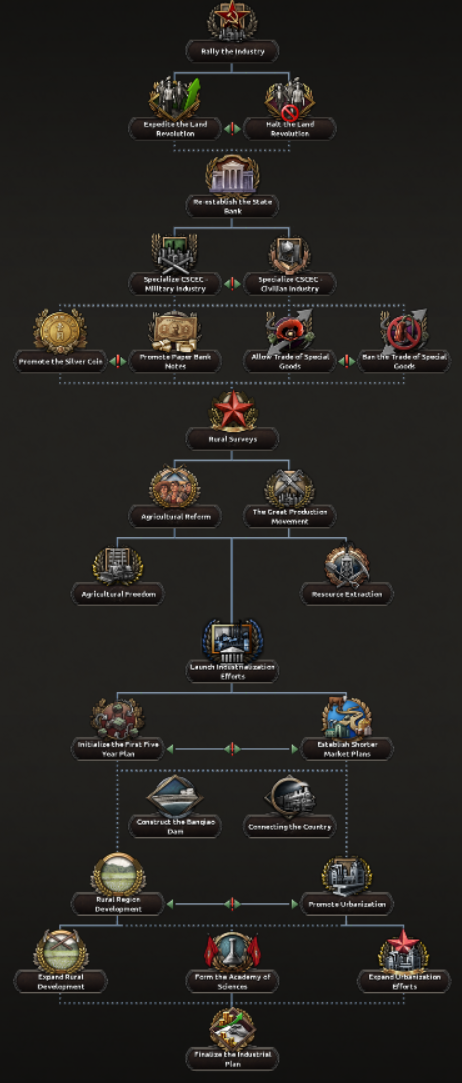 The industrial branch
The industrial branch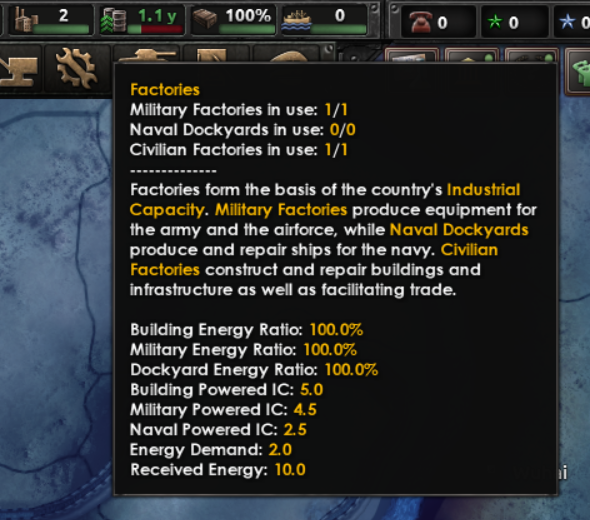
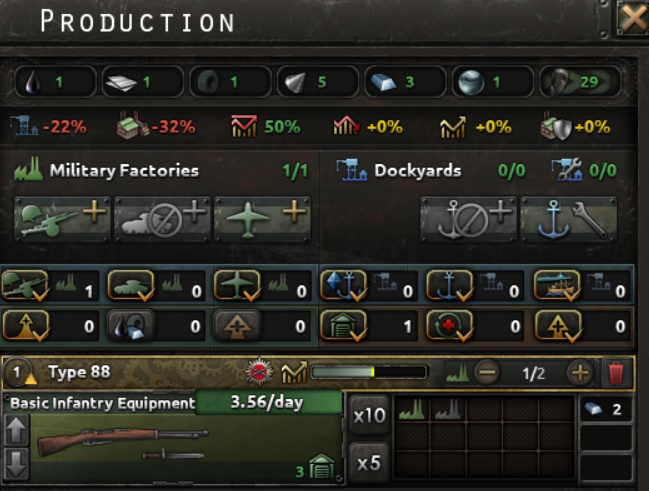 Did I mention we want you to feel like you are building from nothing?
Did I mention we want you to feel like you are building from nothing? 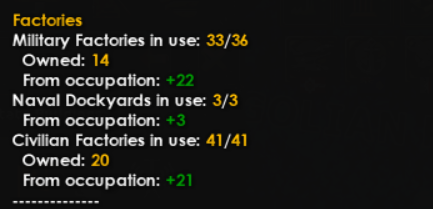
 The industrial situation from a game in 1945, while still at war with Japan. While not on the scale of more industrialized nations, this represents a 4000% increase in factories from the start.
The industrial situation from a game in 1945, while still at war with Japan. While not on the scale of more industrialized nations, this represents a 4000% increase in factories from the start.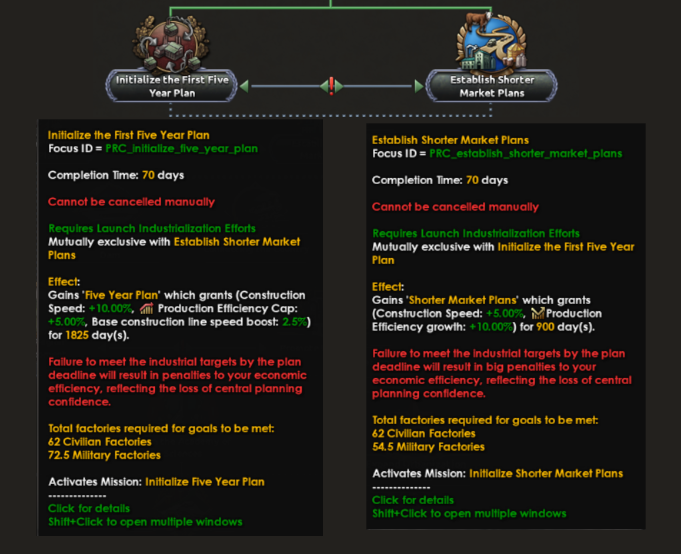 The focuses and requirements for the missions from the industrial situation in screenshot above
The focuses and requirements for the missions from the industrial situation in screenshot above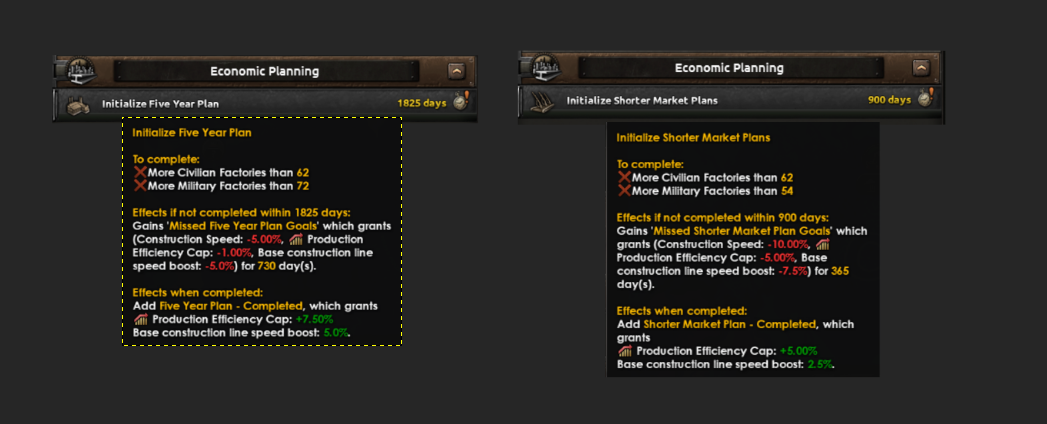 The missions
The missions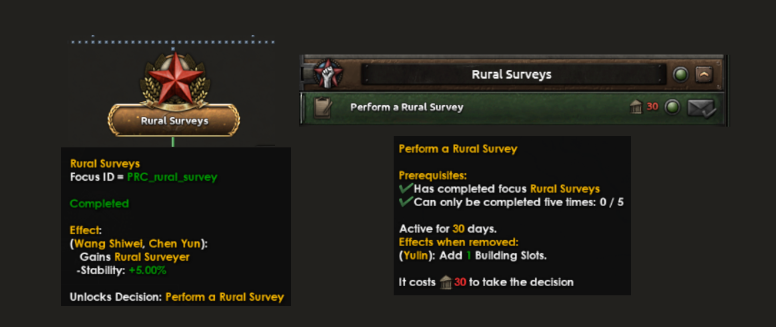
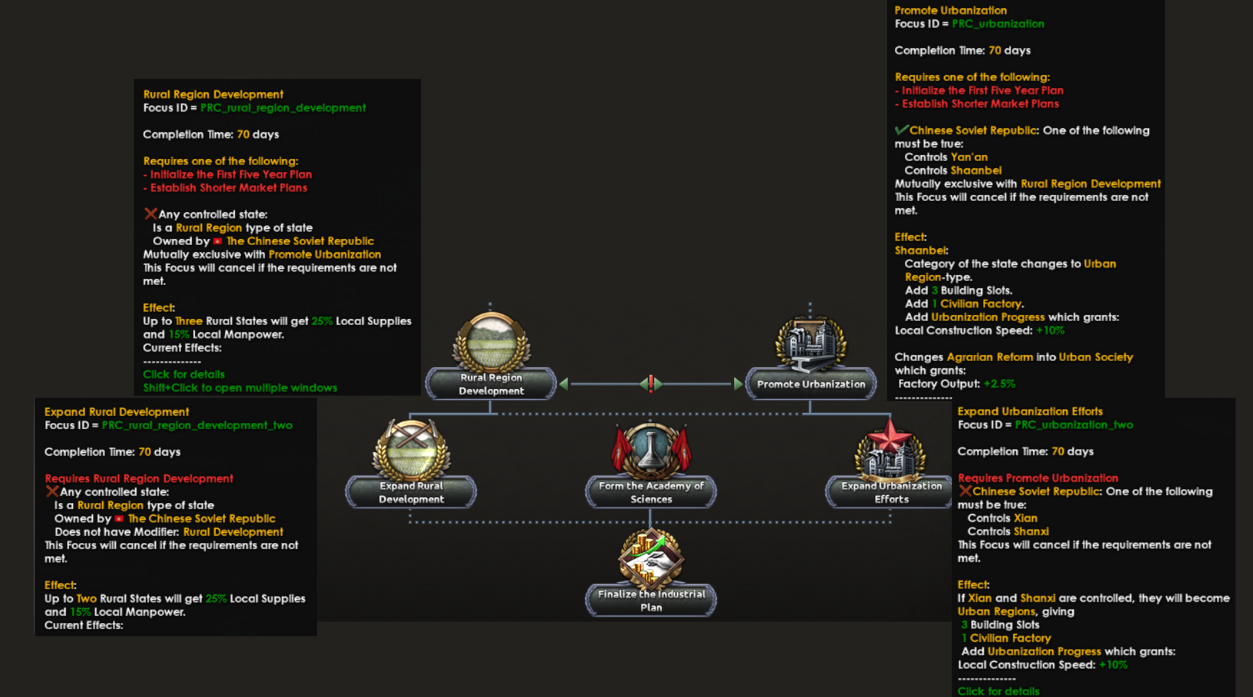
 The player starts with Agrarian Society, but can improve it to Agrarian Reform. Later in the tree the player can turn it into Urban Society. The numbers and balance are not finished yet.
The player starts with Agrarian Society, but can improve it to Agrarian Reform. Later in the tree the player can turn it into Urban Society. The numbers and balance are not finished yet.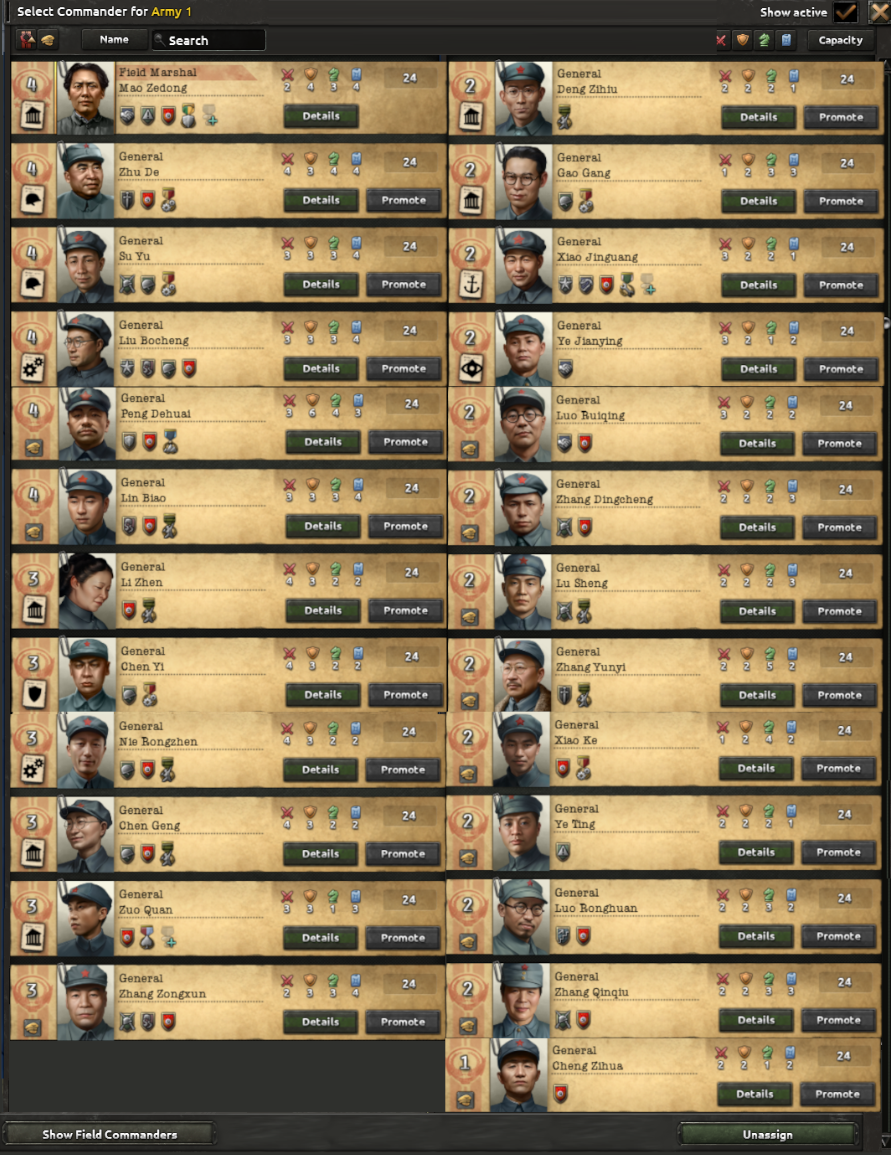 Here’s a list of all the starting Generals. He Long and Zhang Guotao are on a road trip (they can join you later on) at the start of the game.
Here’s a list of all the starting Generals. He Long and Zhang Guotao are on a road trip (they can join you later on) at the start of the game.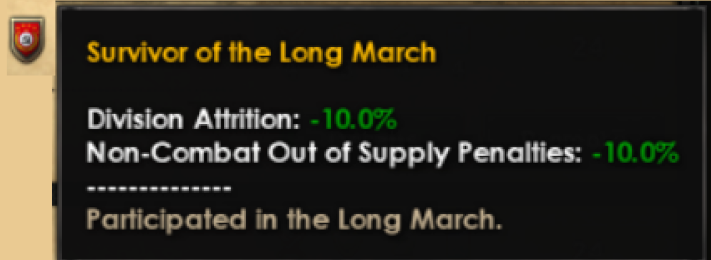 Survivor of the Long March trait
Survivor of the Long March trait 
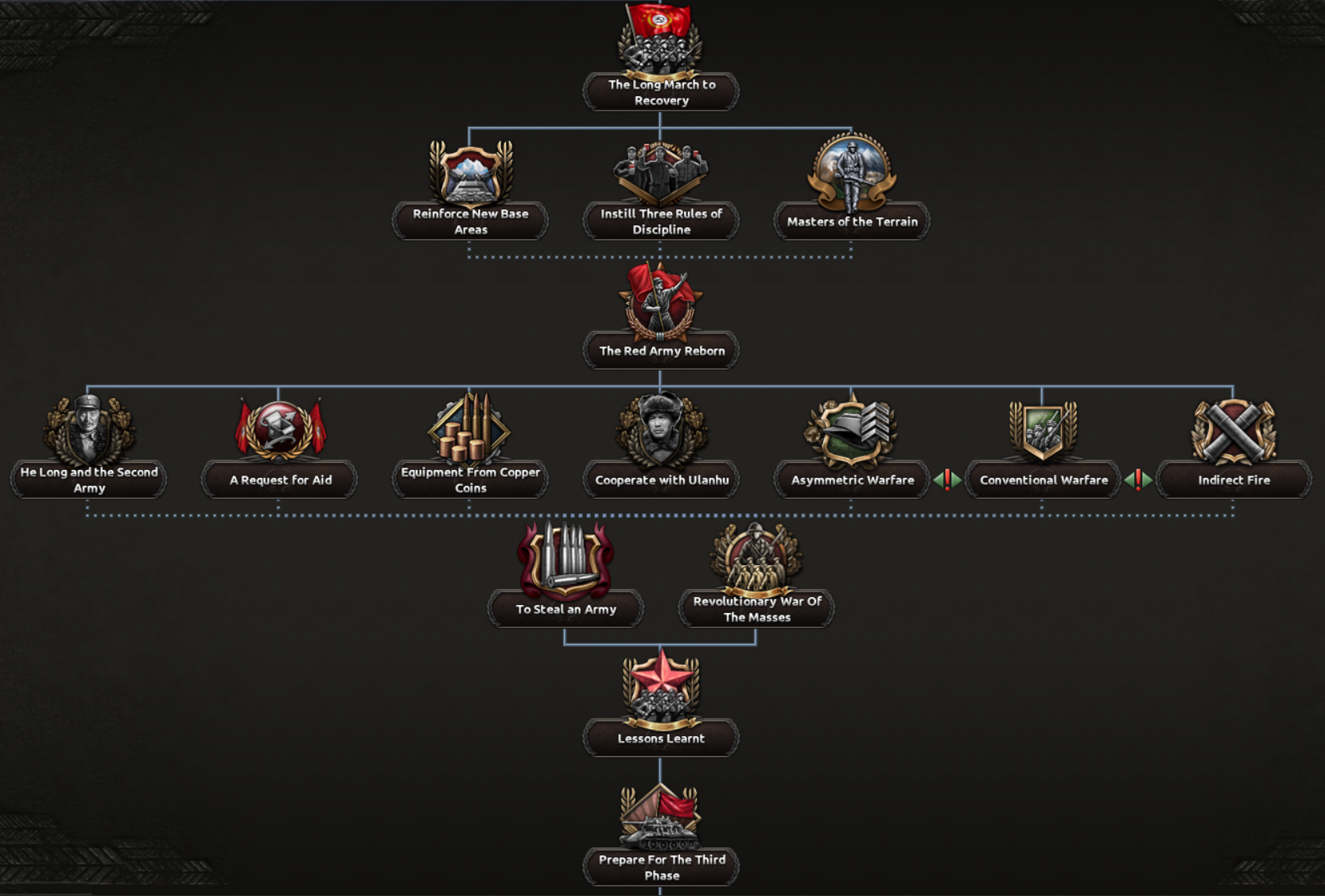
 In the early part of the military, the goal for the player is to catch up and recover from the Long March.
In the early part of the military, the goal for the player is to catch up and recover from the Long March. 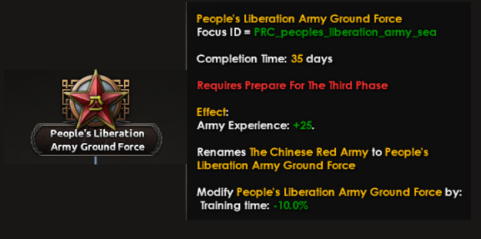
 The different late game military branches
The different late game military branches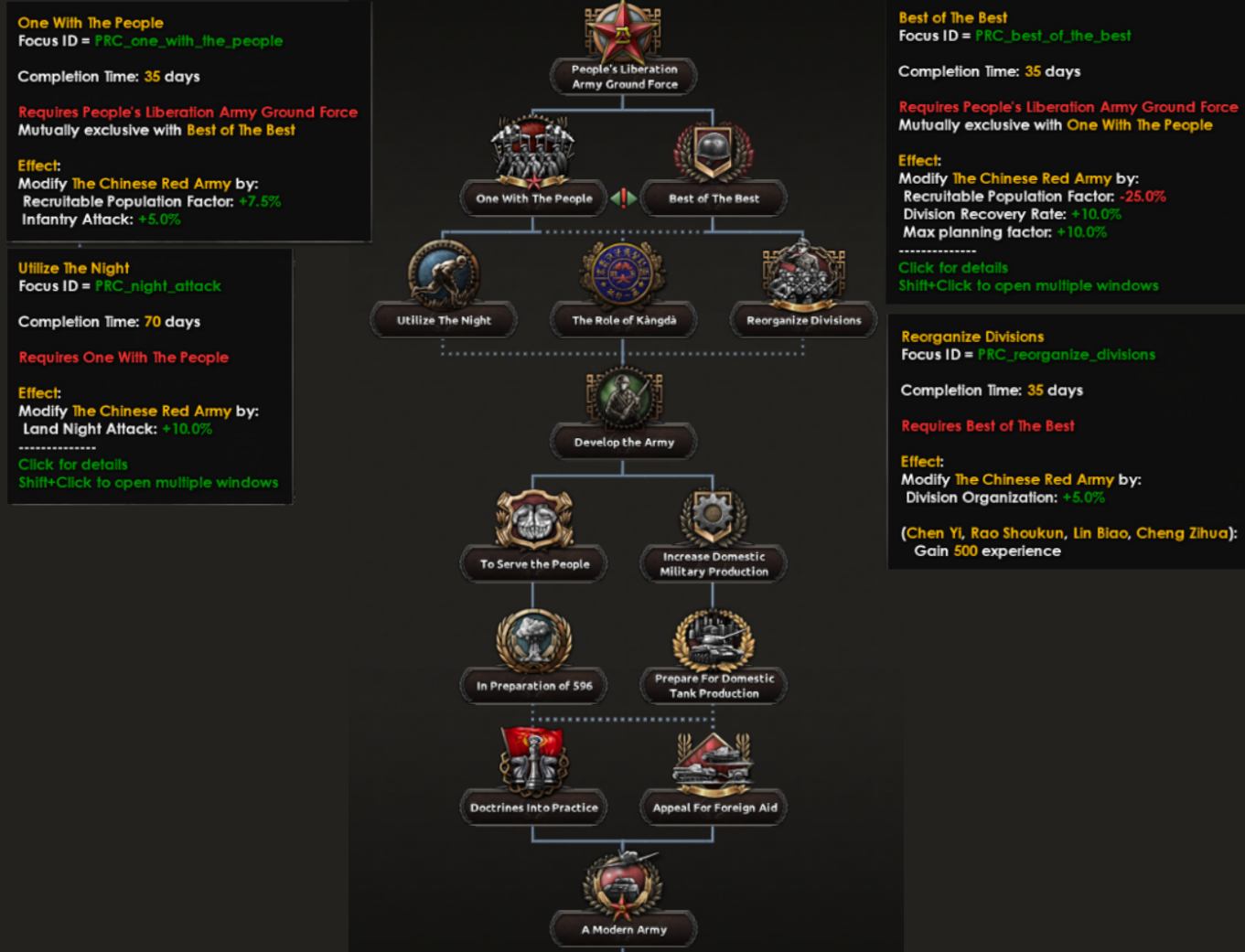
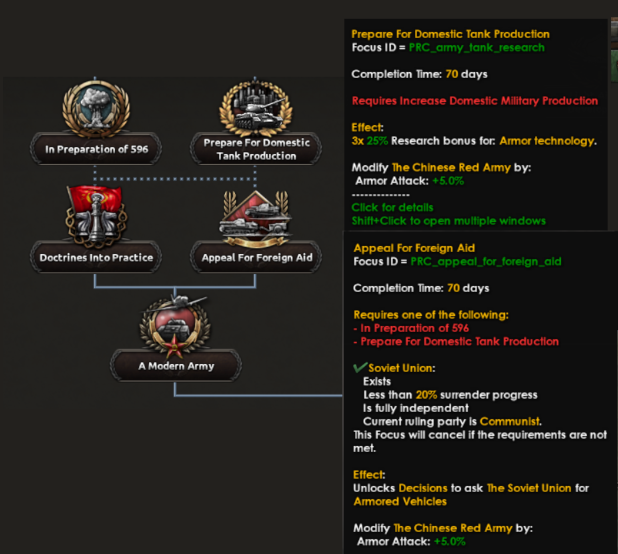
 Tanks. Tanks.
Tanks. Tanks.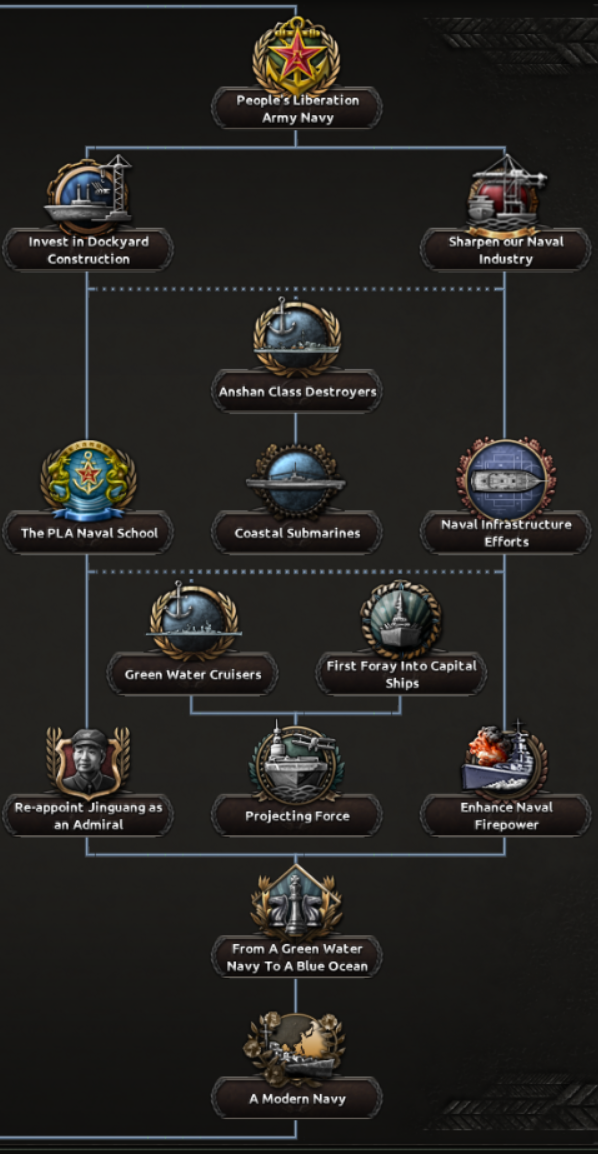
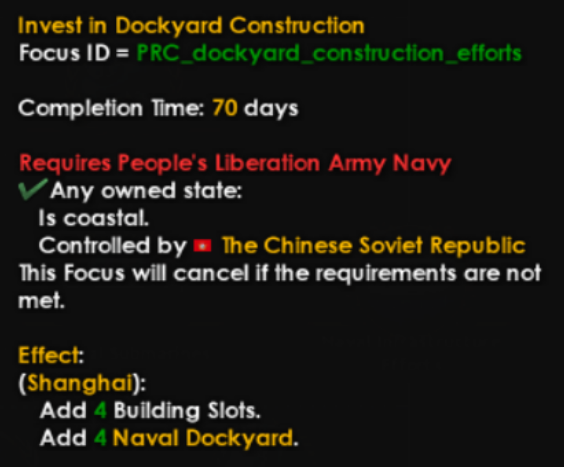
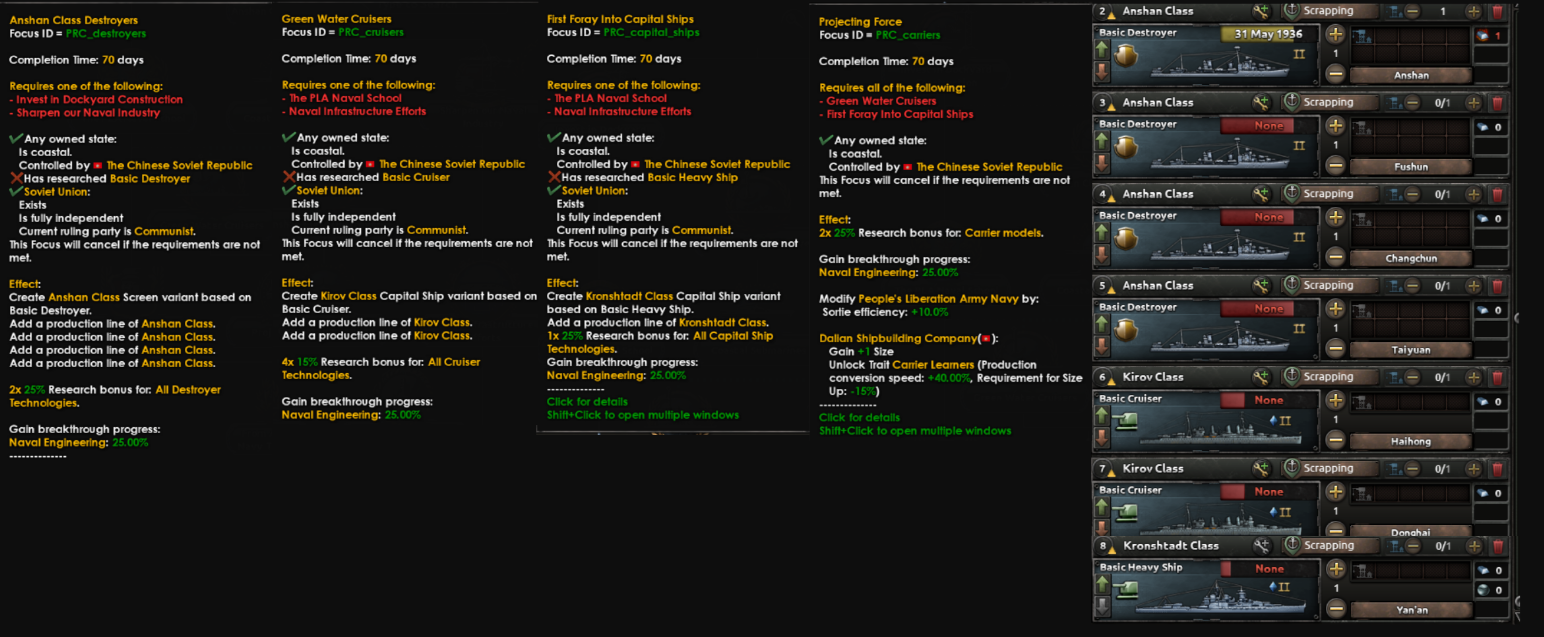 Soviet ships
Soviet ships
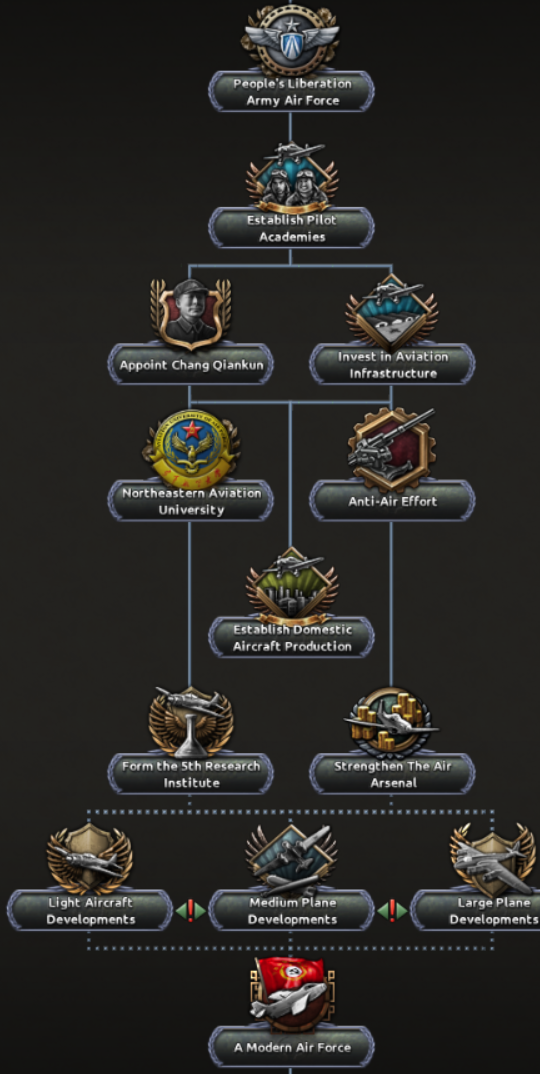
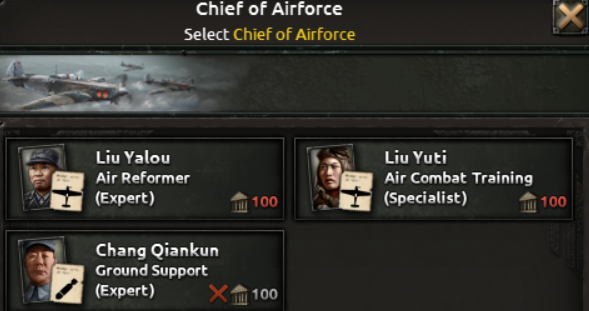
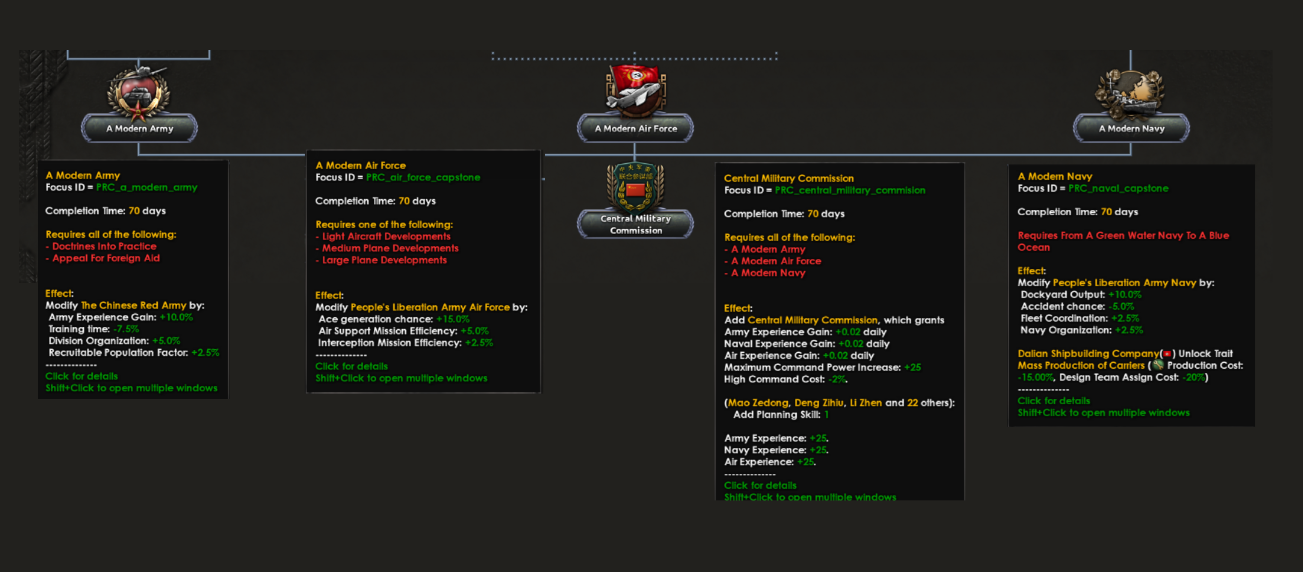 And here is a look of all the capstone focuses on the military branch, leading up to the creation of the Central Military Commission.
And here is a look of all the capstone focuses on the military branch, leading up to the creation of the Central Military Commission. 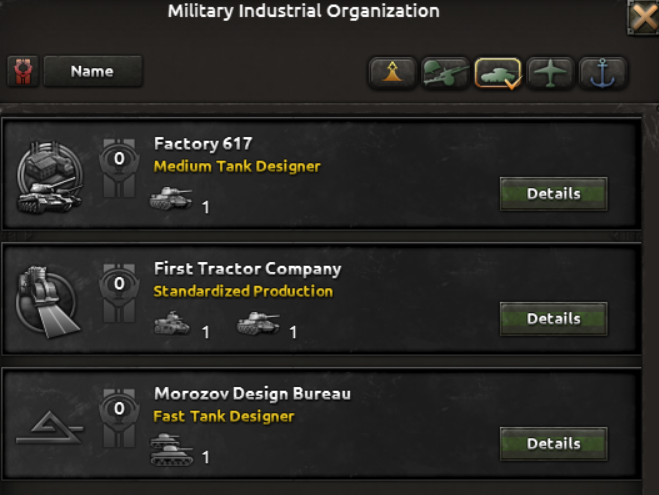 Tank MIOs
Tank MIOs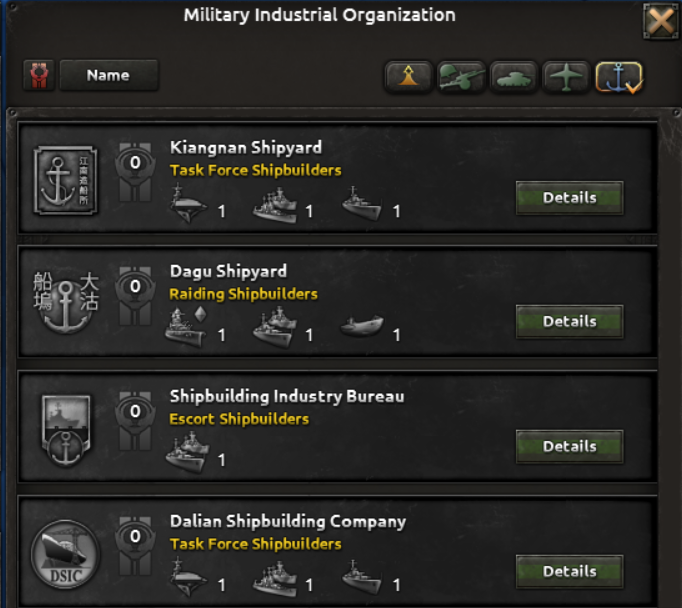 Naval MIOs
Naval MIOs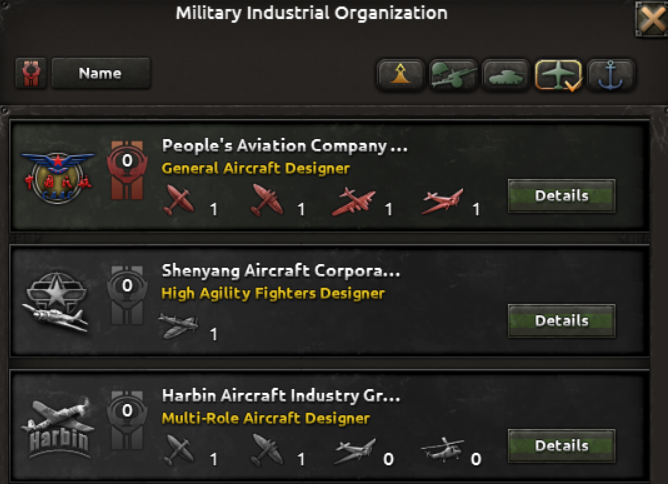 Aircraft MIOs
Aircraft MIOs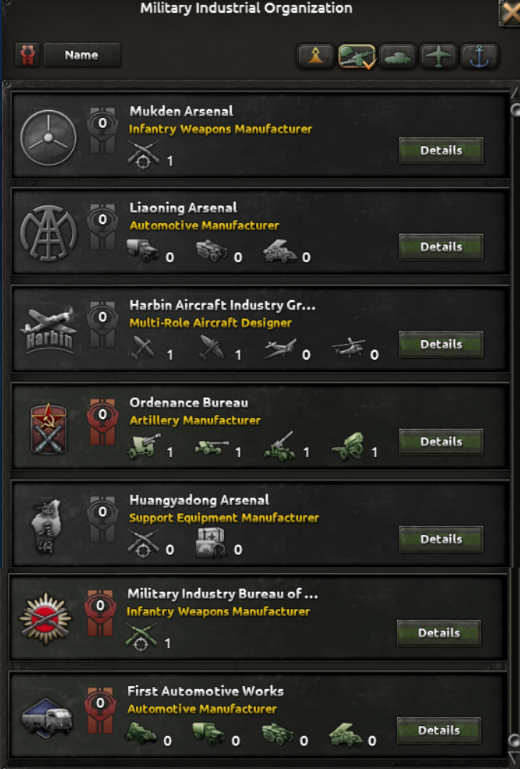 Material MIO
Material MIO
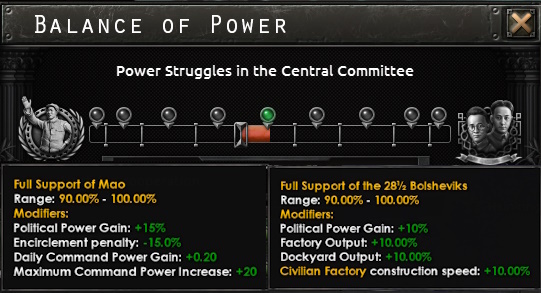

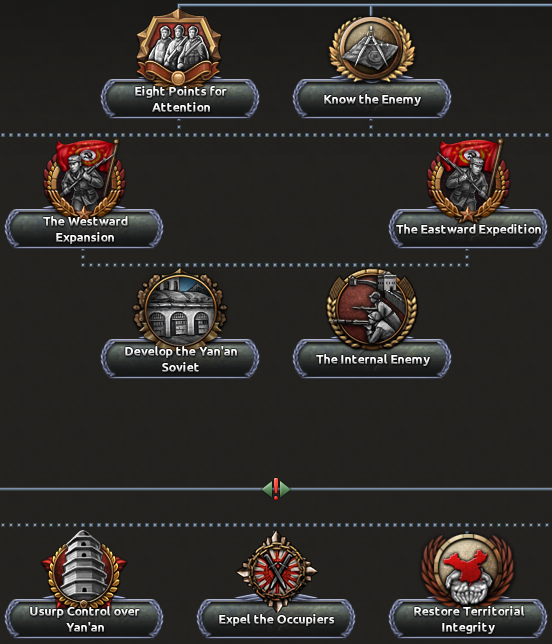
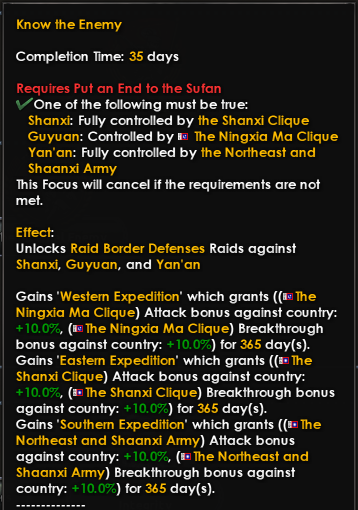
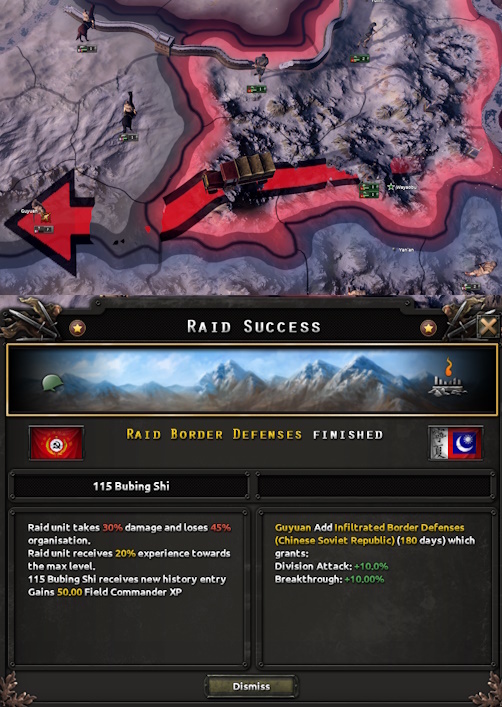



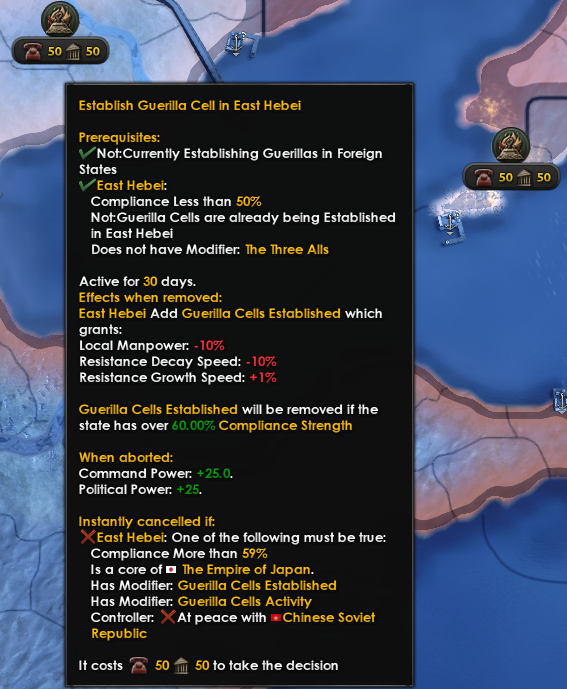
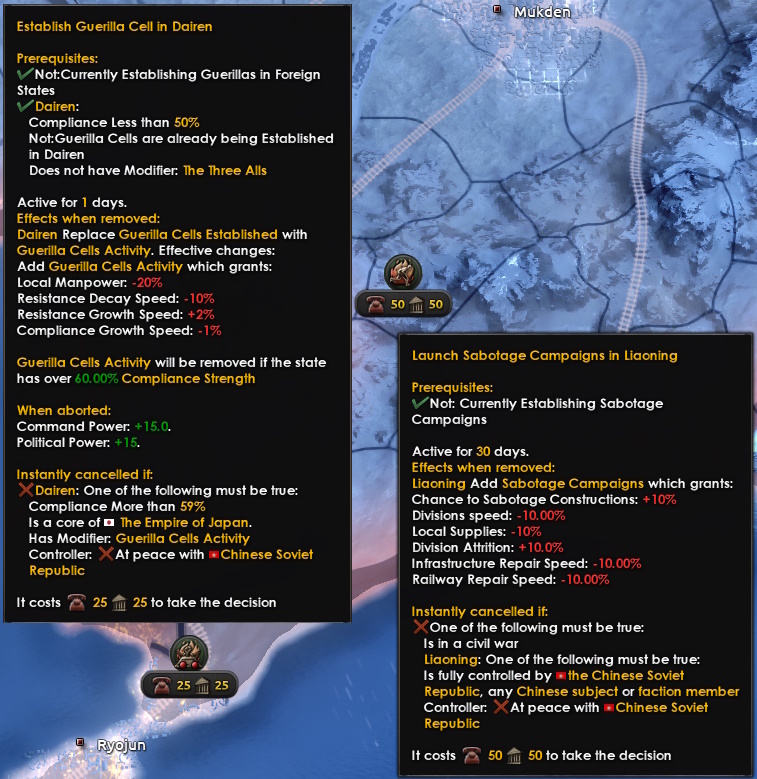
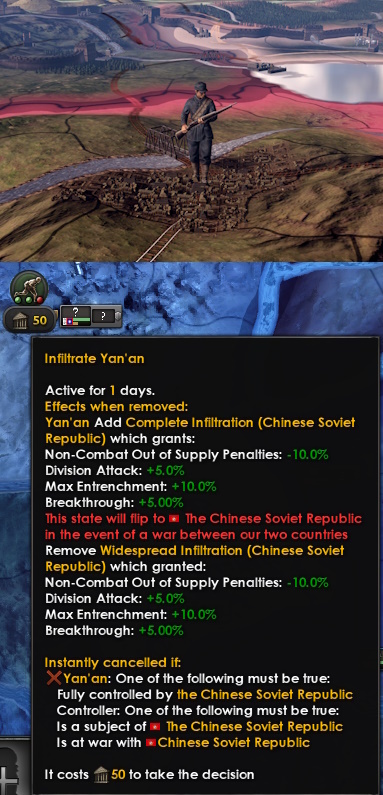
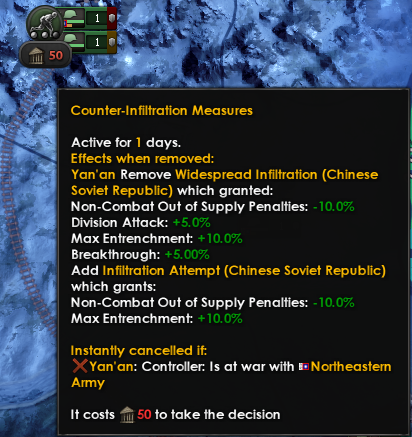

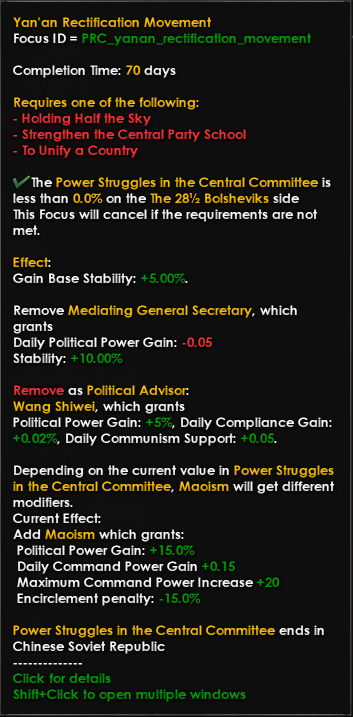
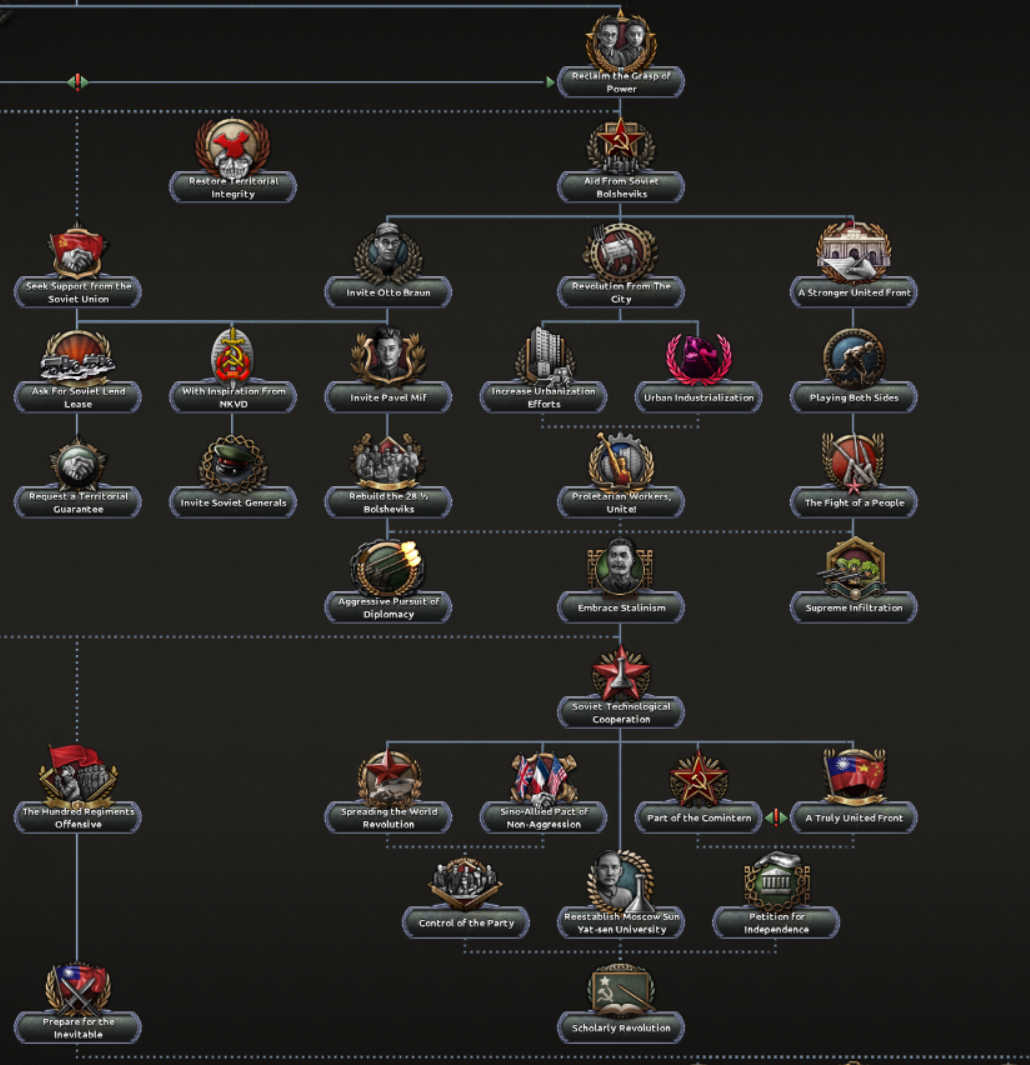 The focus paths for 28 ½ Bolsheviks
The focus paths for 28 ½ Bolsheviks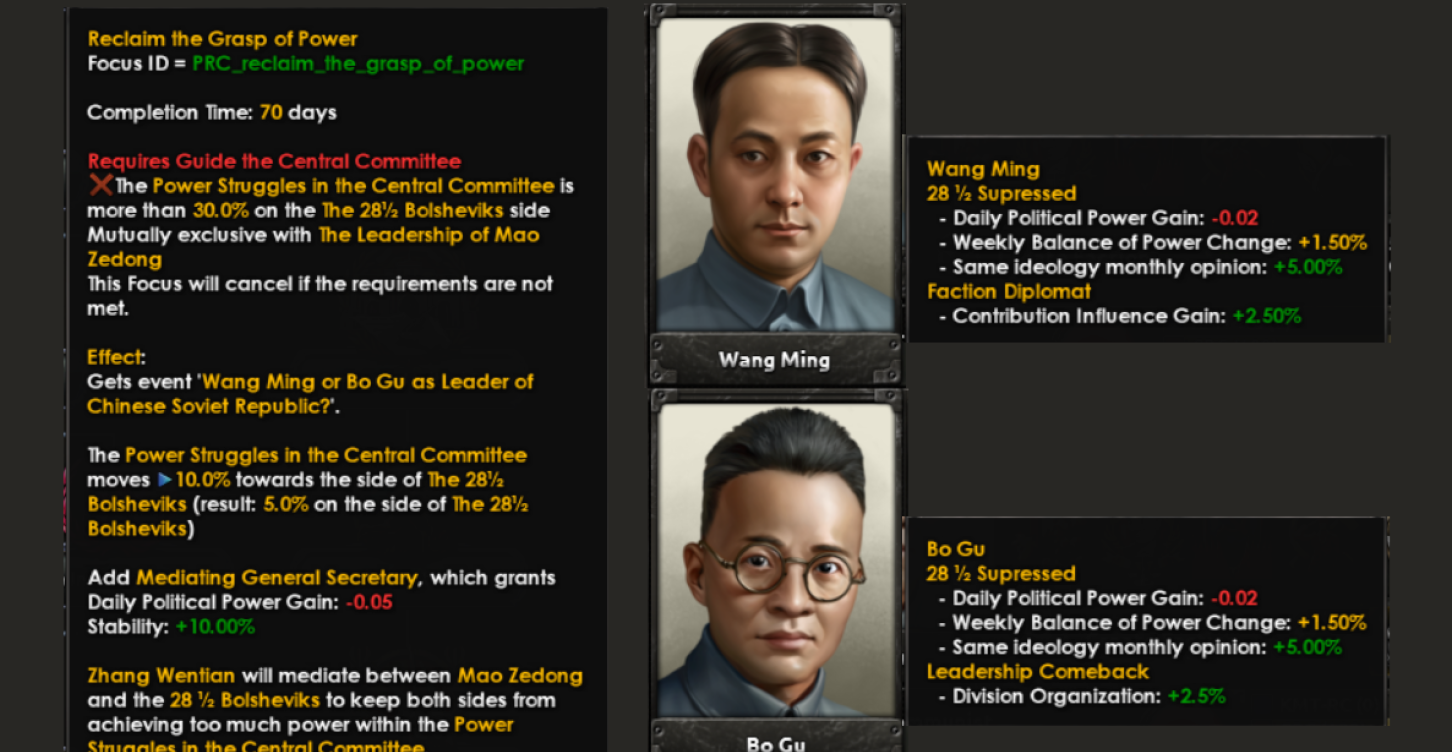 Bo Gu and Wang Ming
Bo Gu and Wang Ming 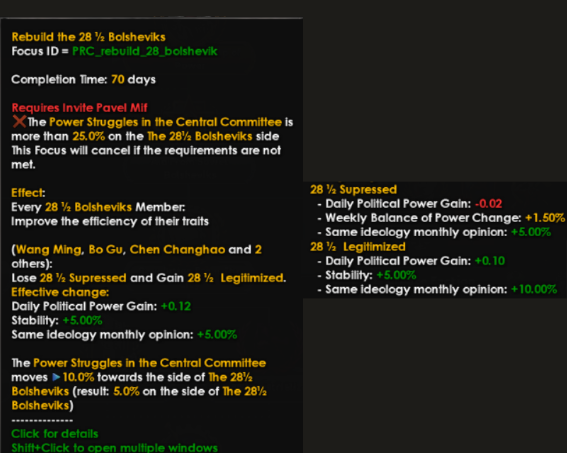 The player can take a focus to upgrade the trait for all leaders and advisors of the 28 ½ Bolsheviks
The player can take a focus to upgrade the trait for all leaders and advisors of the 28 ½ Bolsheviks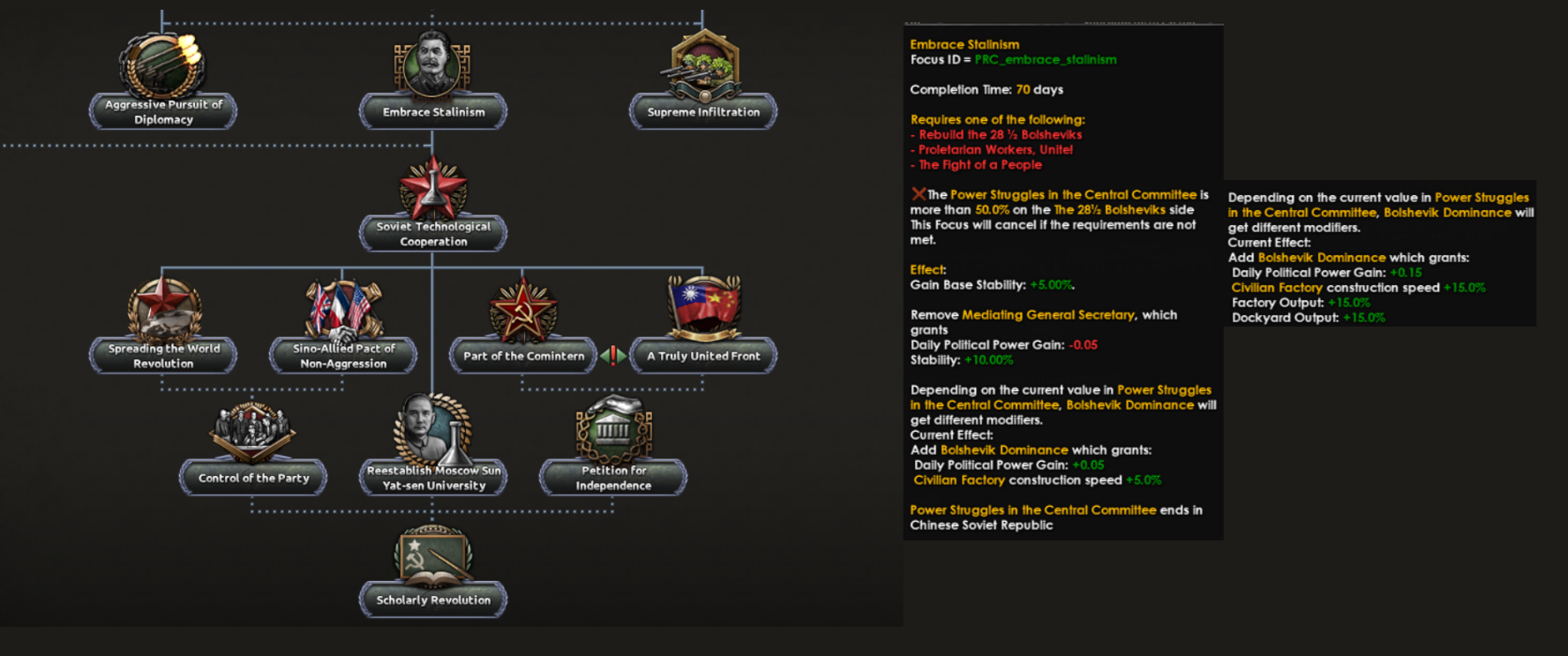 The strength of the modifier gained from Embrace Stalinism is based on the current Balance of Power value
The strength of the modifier gained from Embrace Stalinism is based on the current Balance of Power value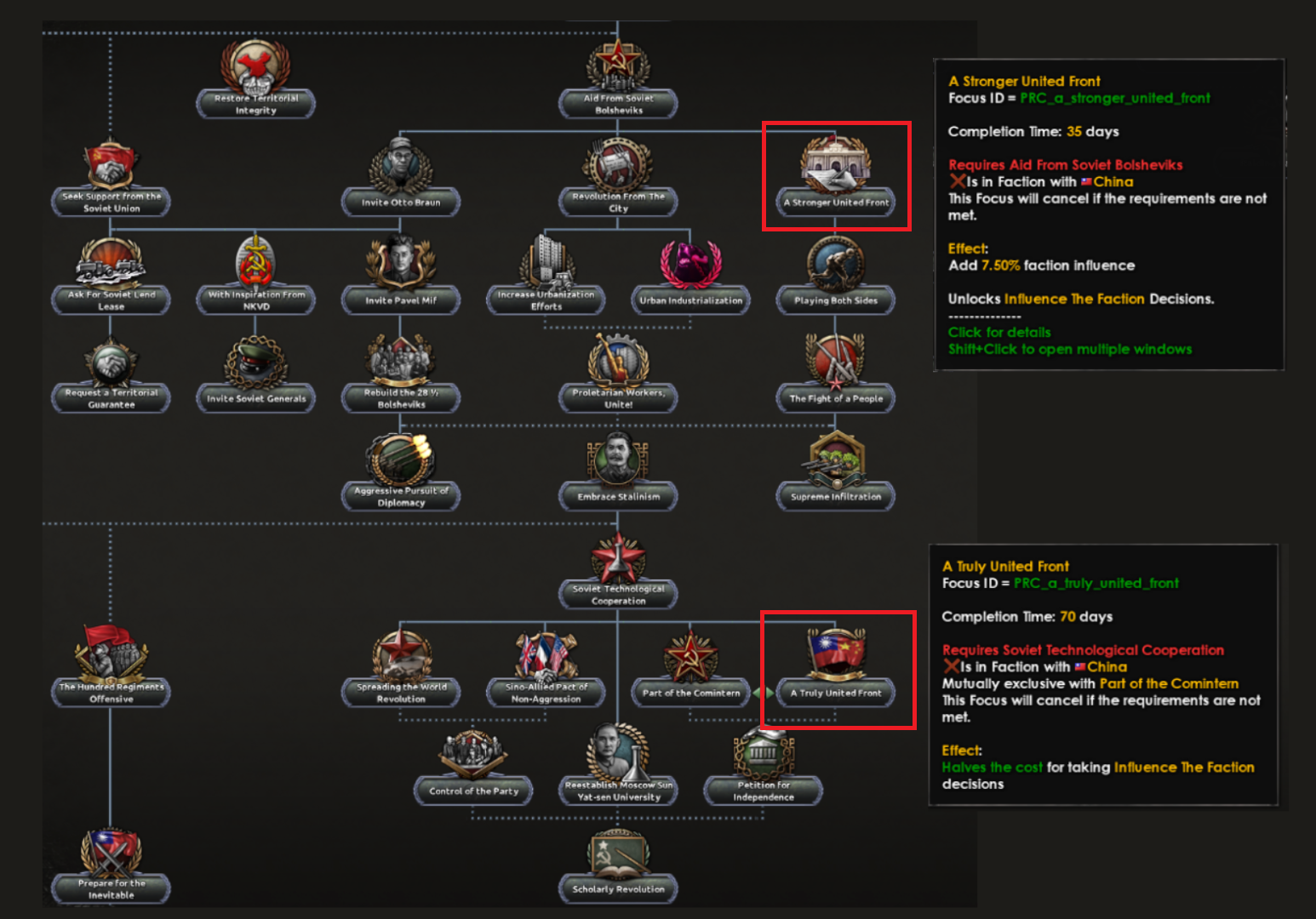
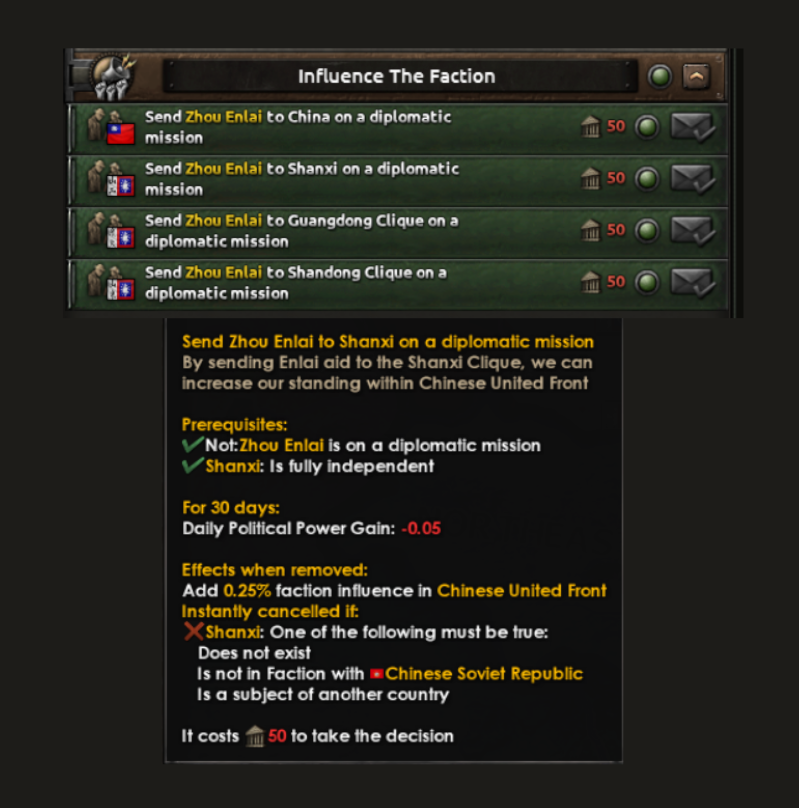 Tier one decisions
Tier one decisions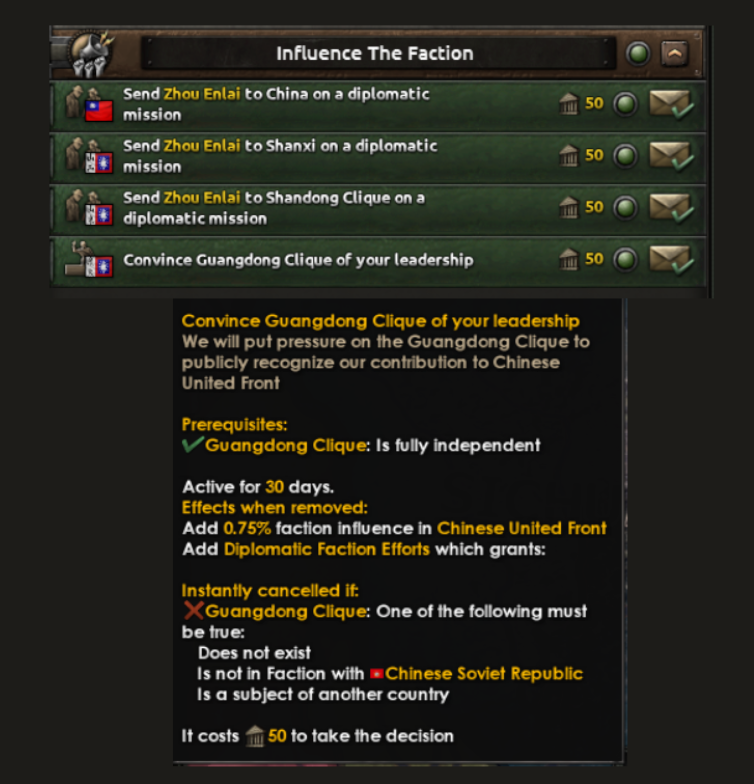 Tier two decision
Tier two decision If you prefer diplomatic gameplay over infiltration, this path might be for you!
If you prefer diplomatic gameplay over infiltration, this path might be for you!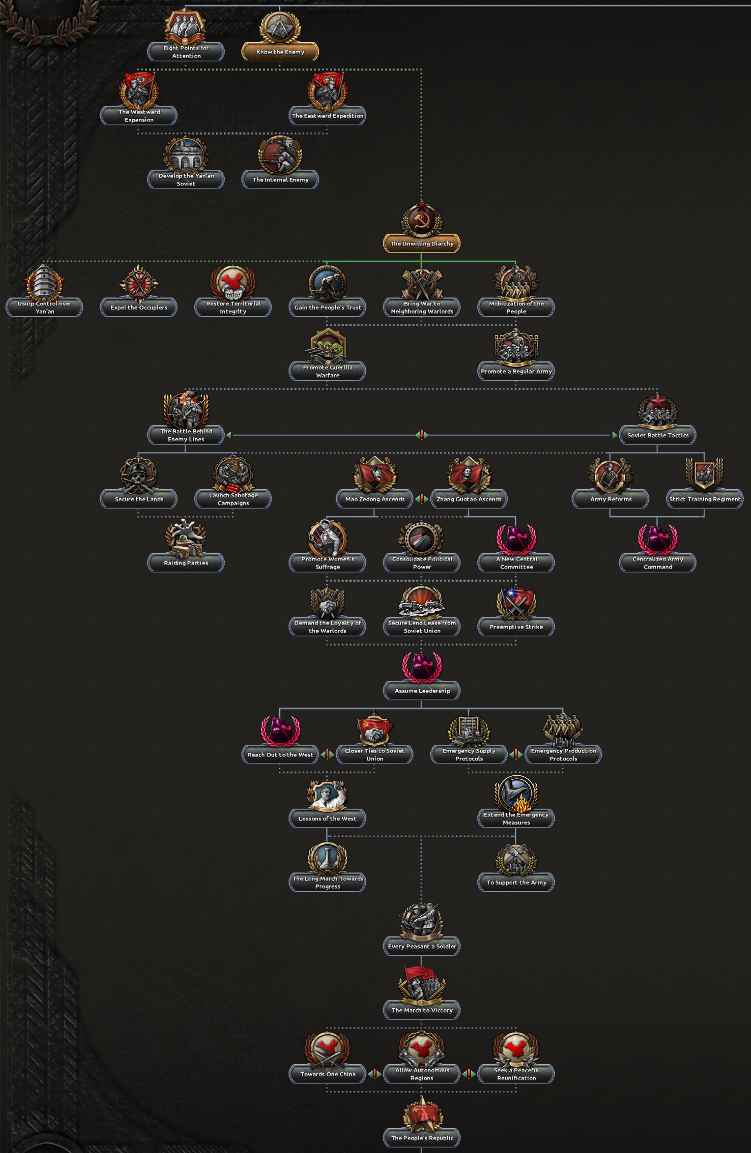

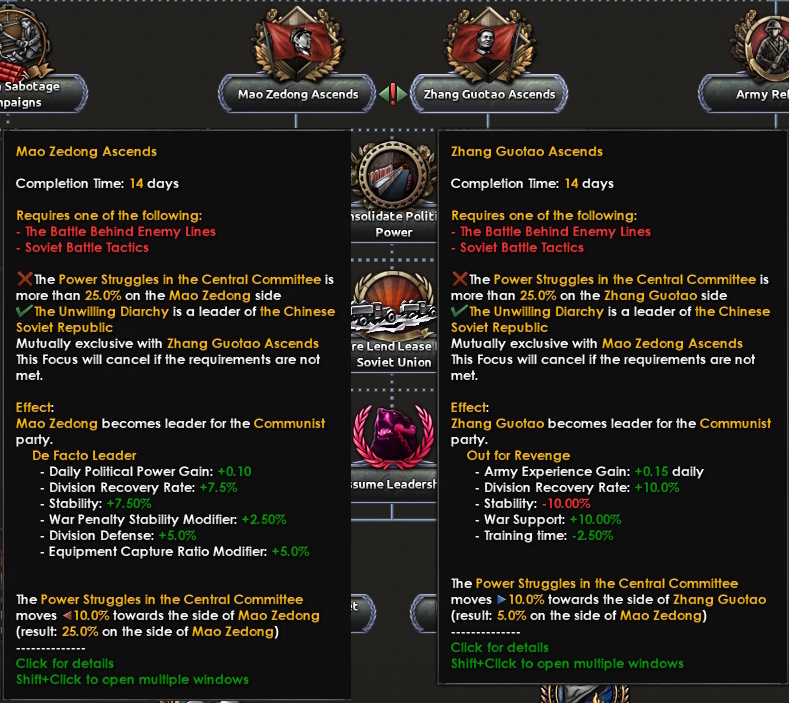
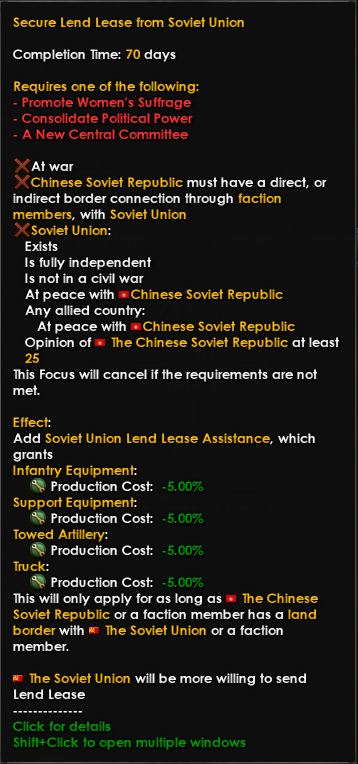
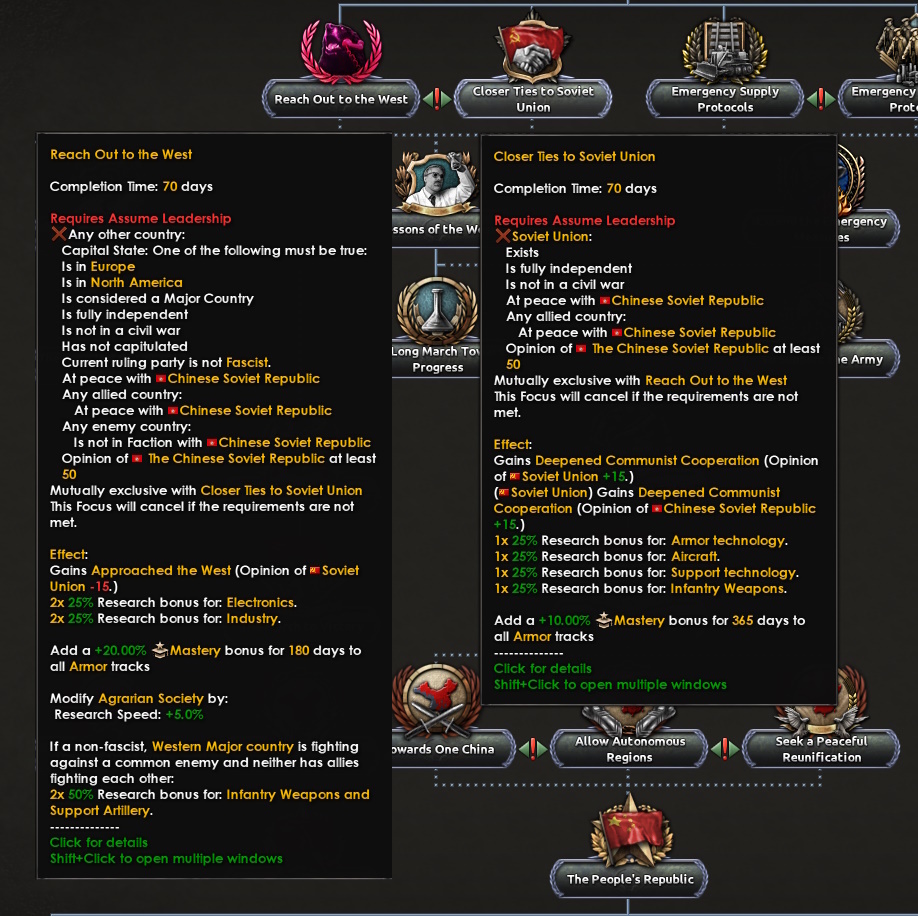
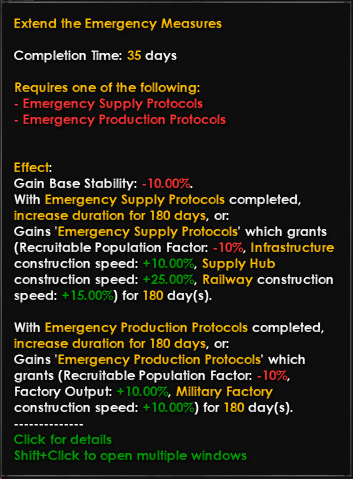
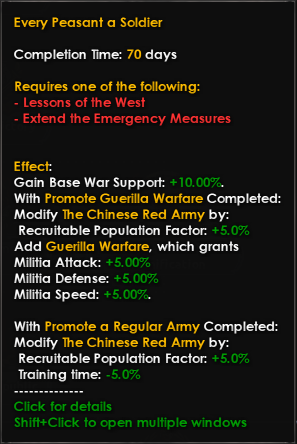
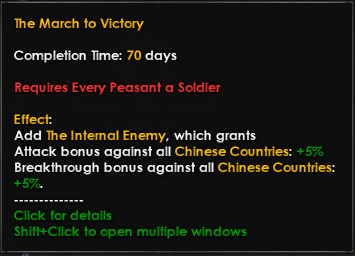
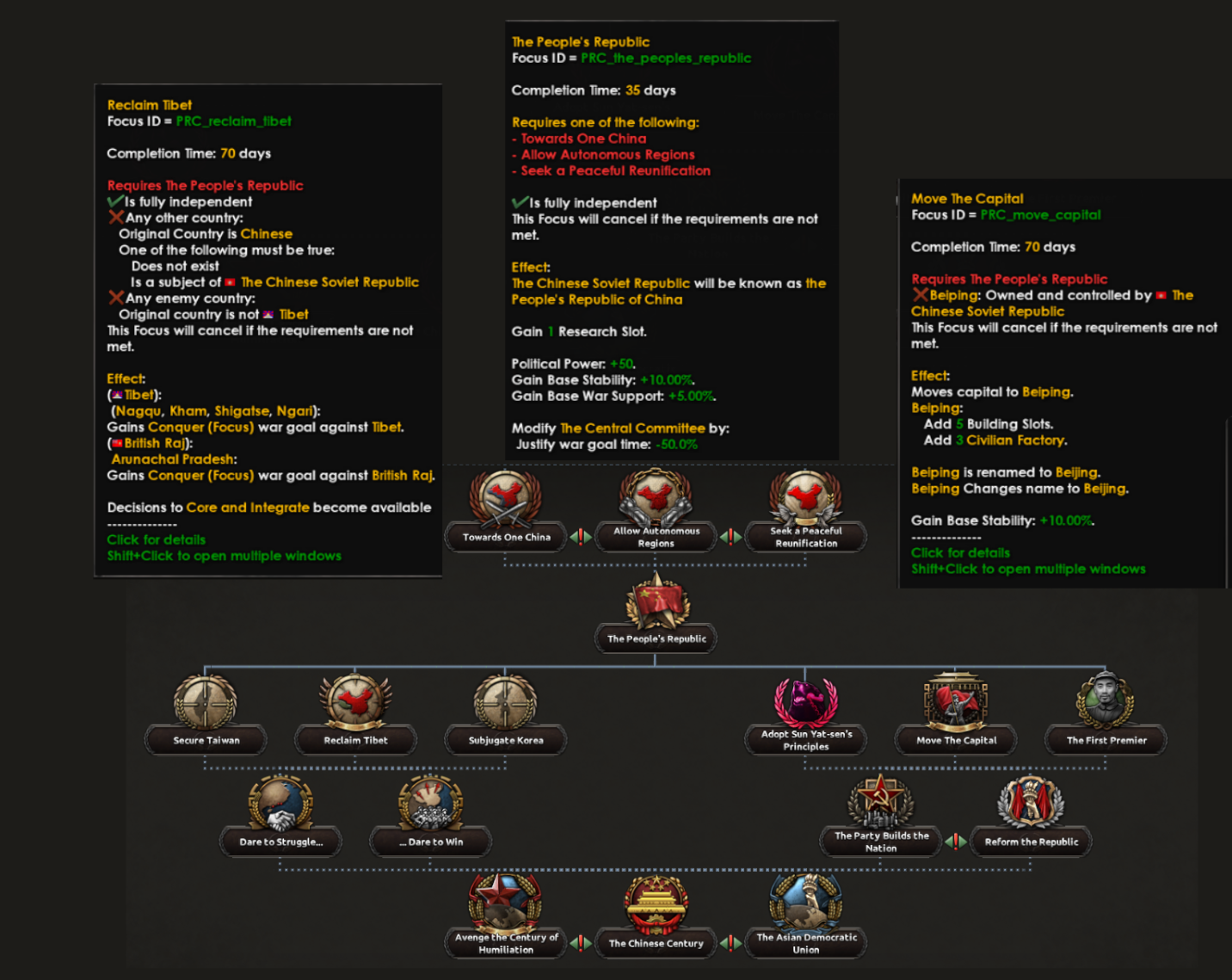 End game political branch
End game political branch
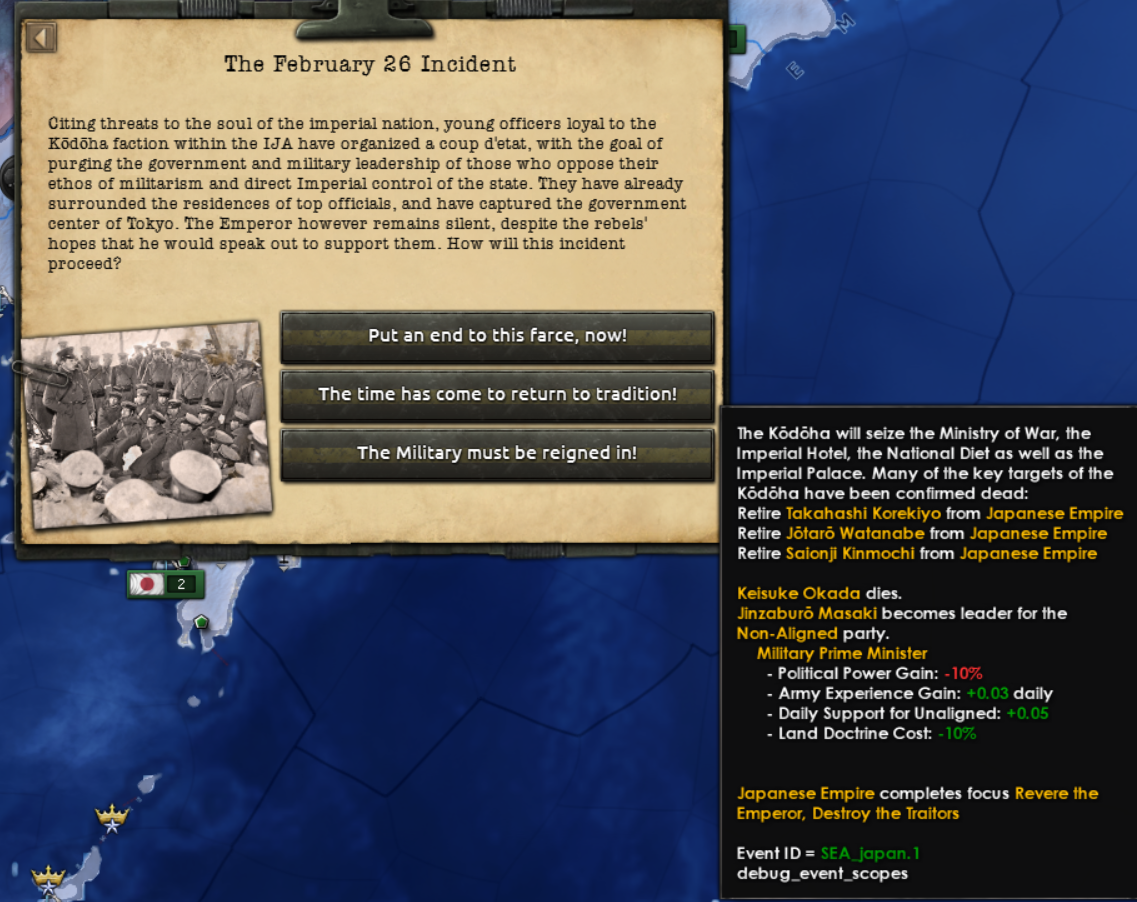
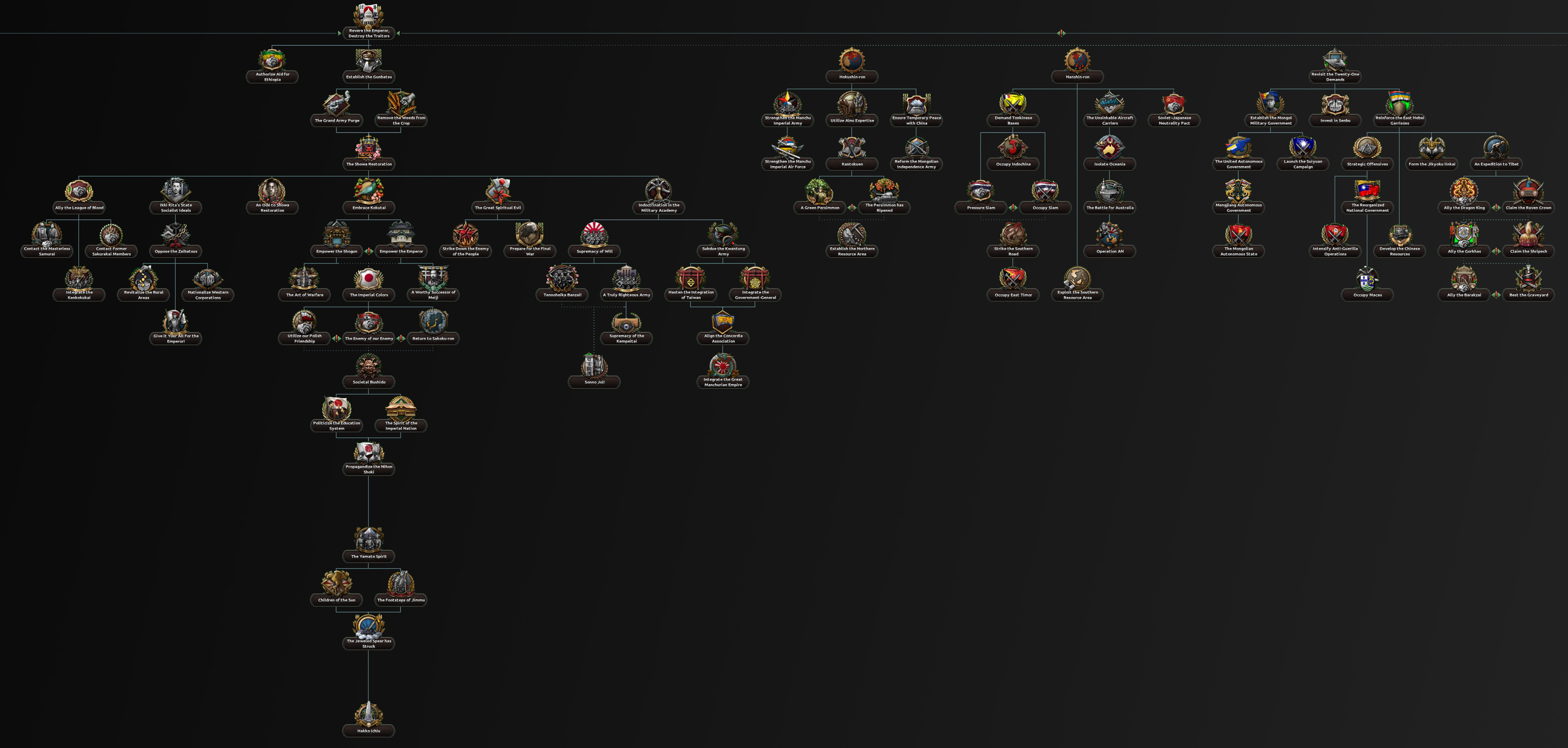
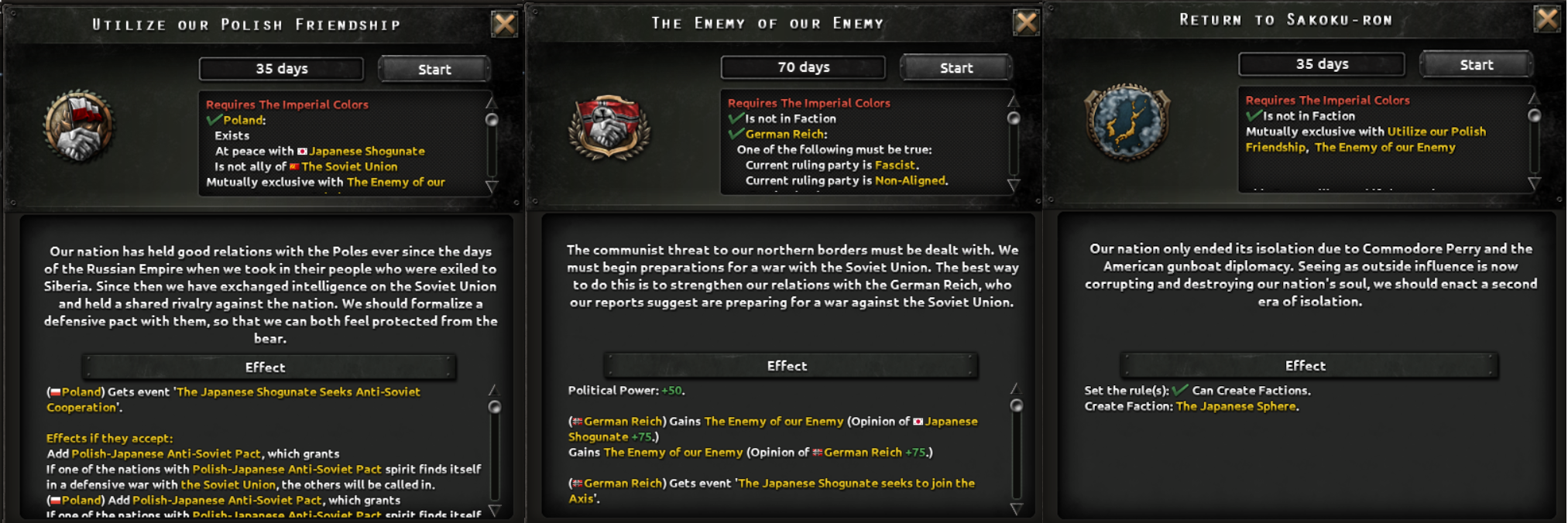

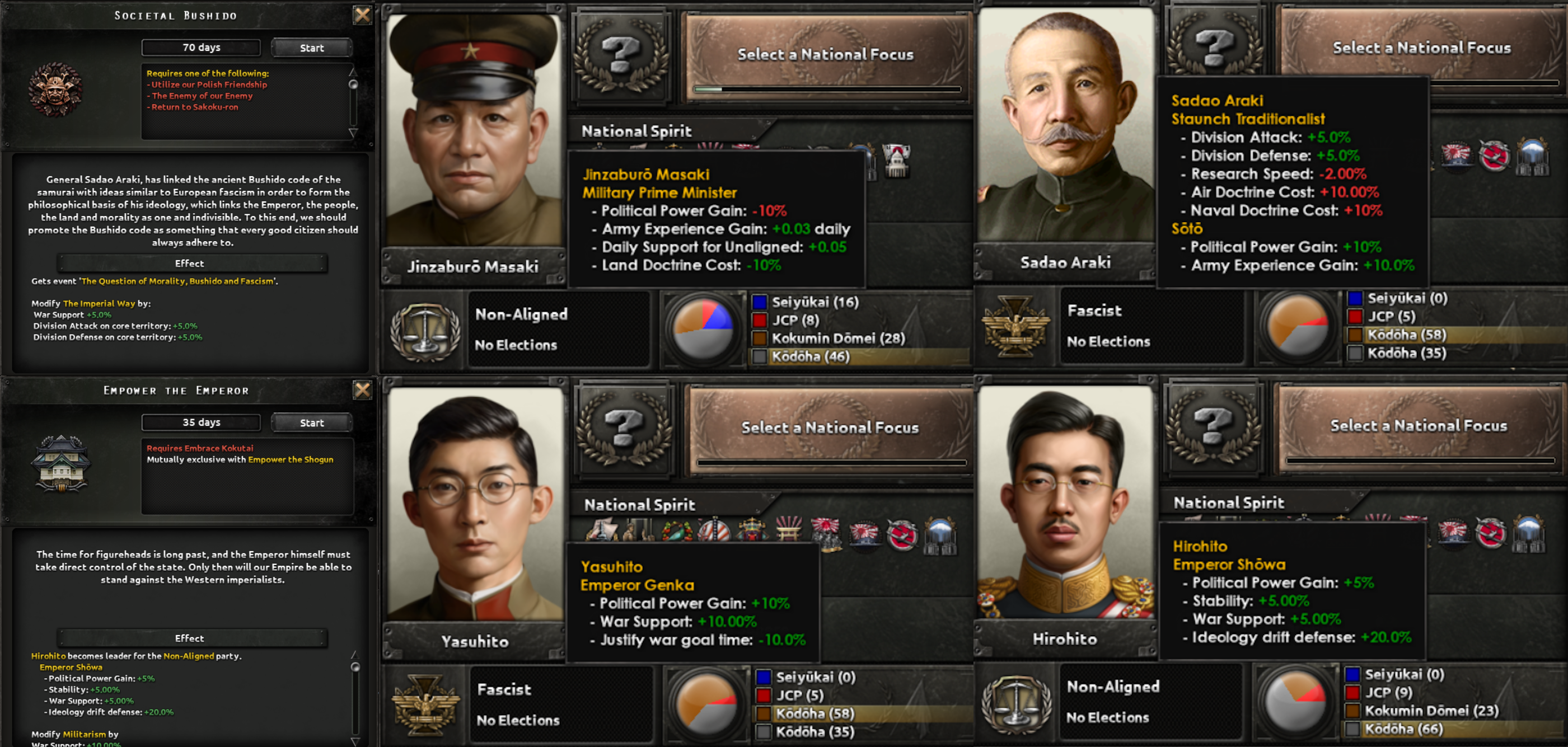
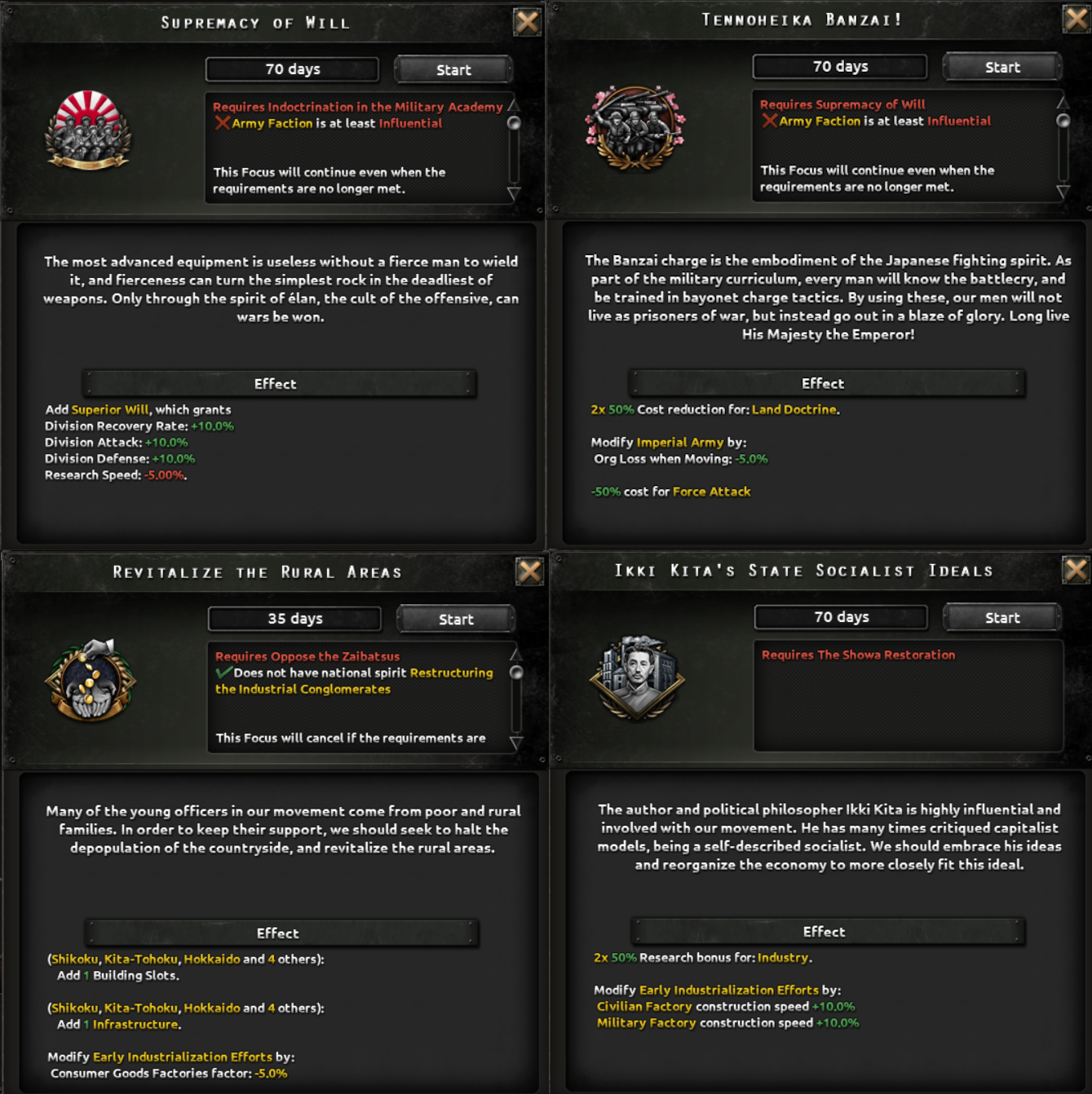

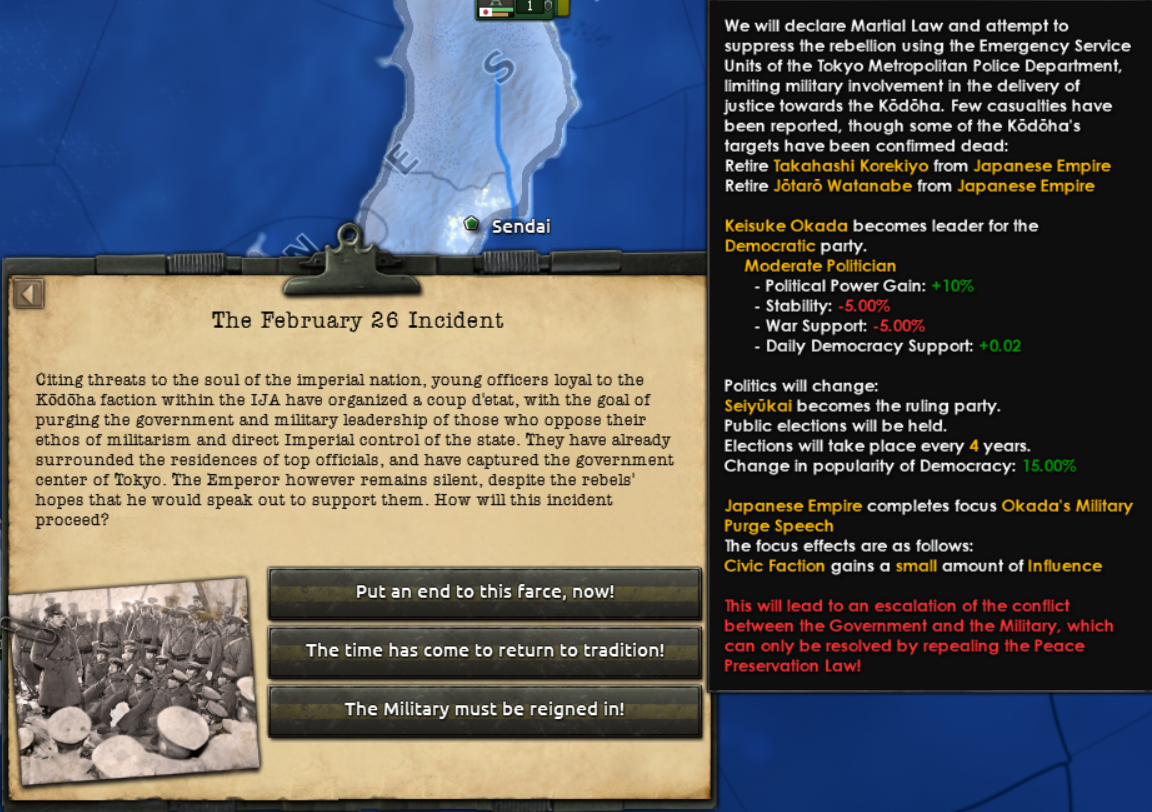
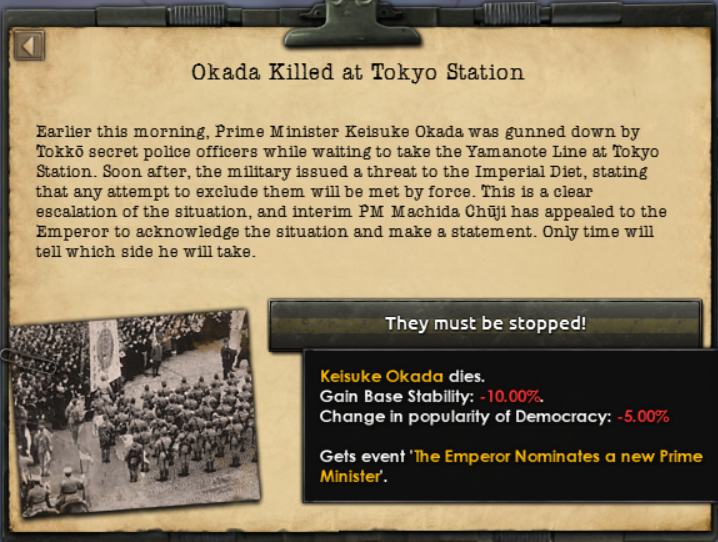

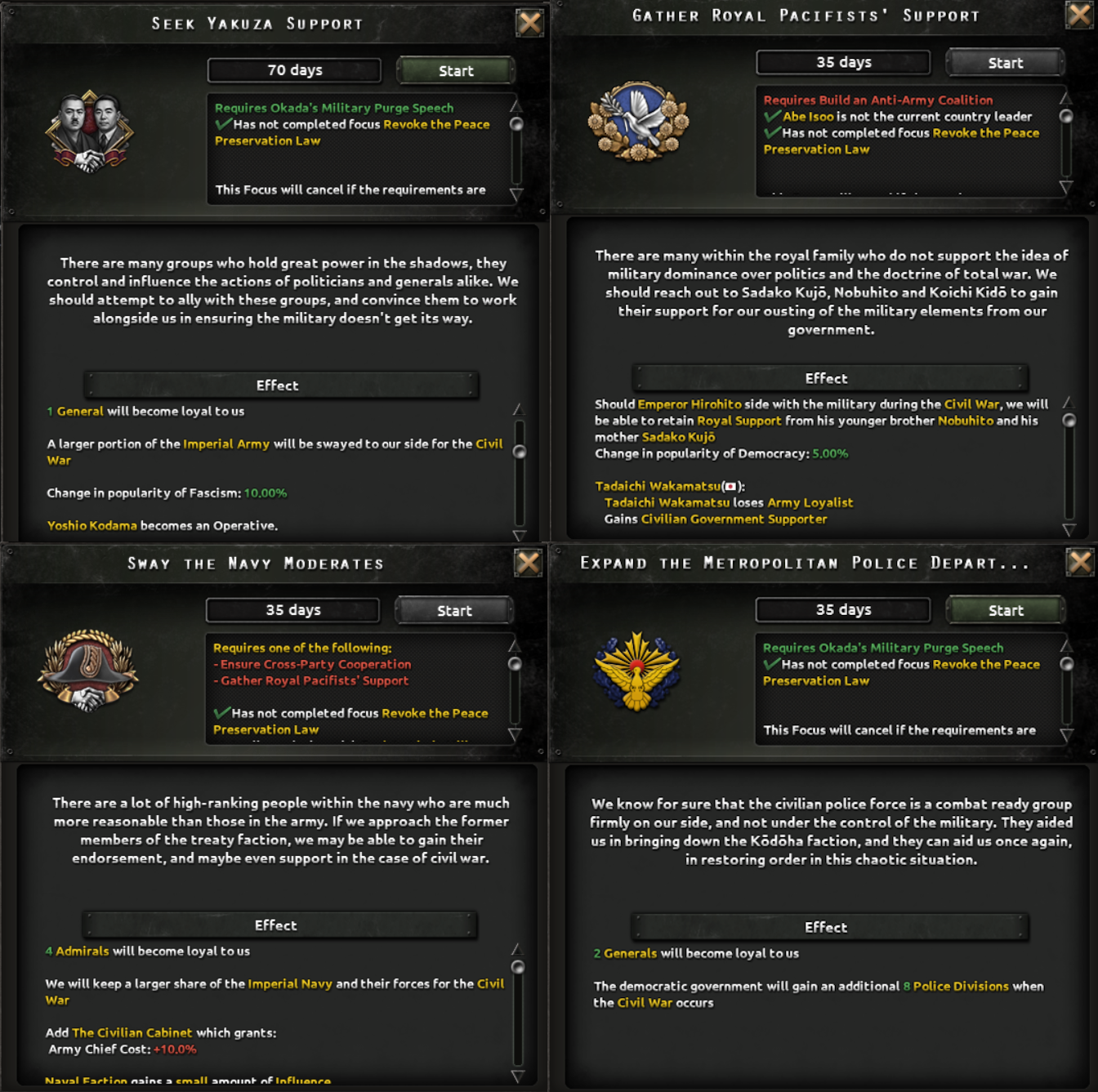
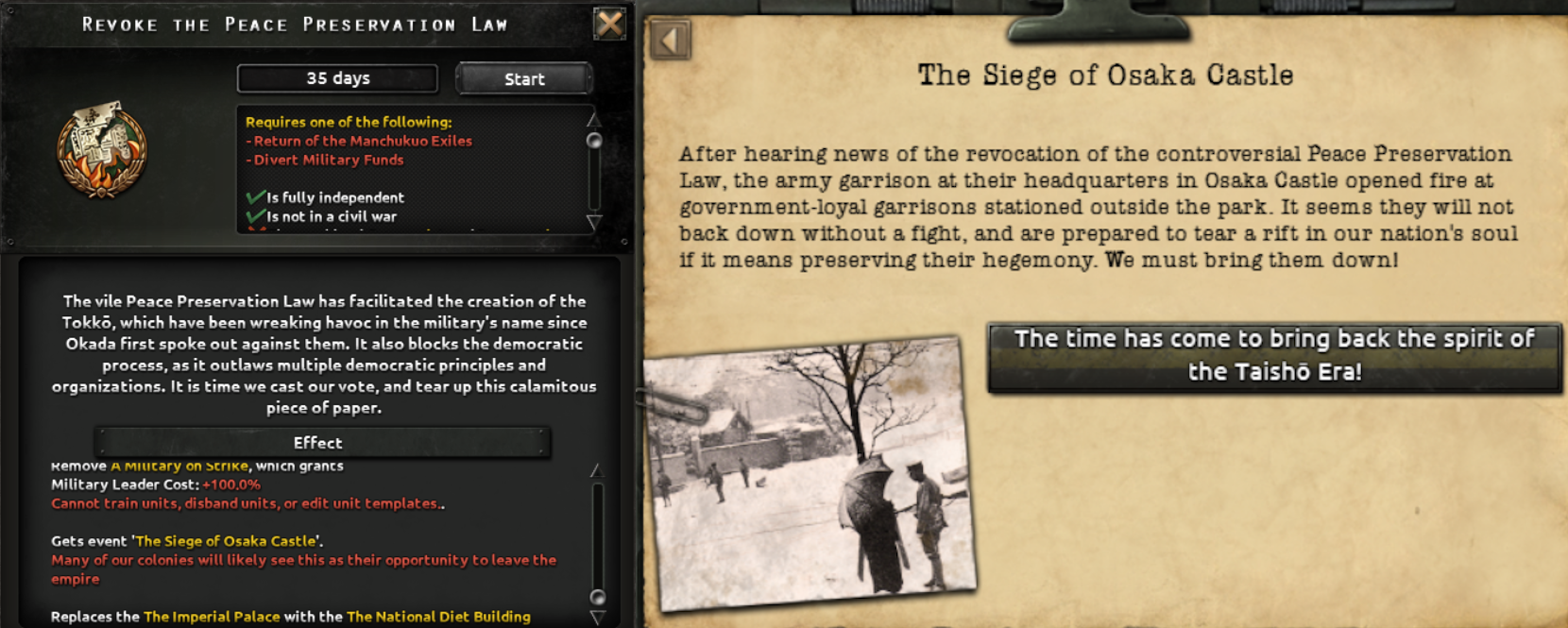
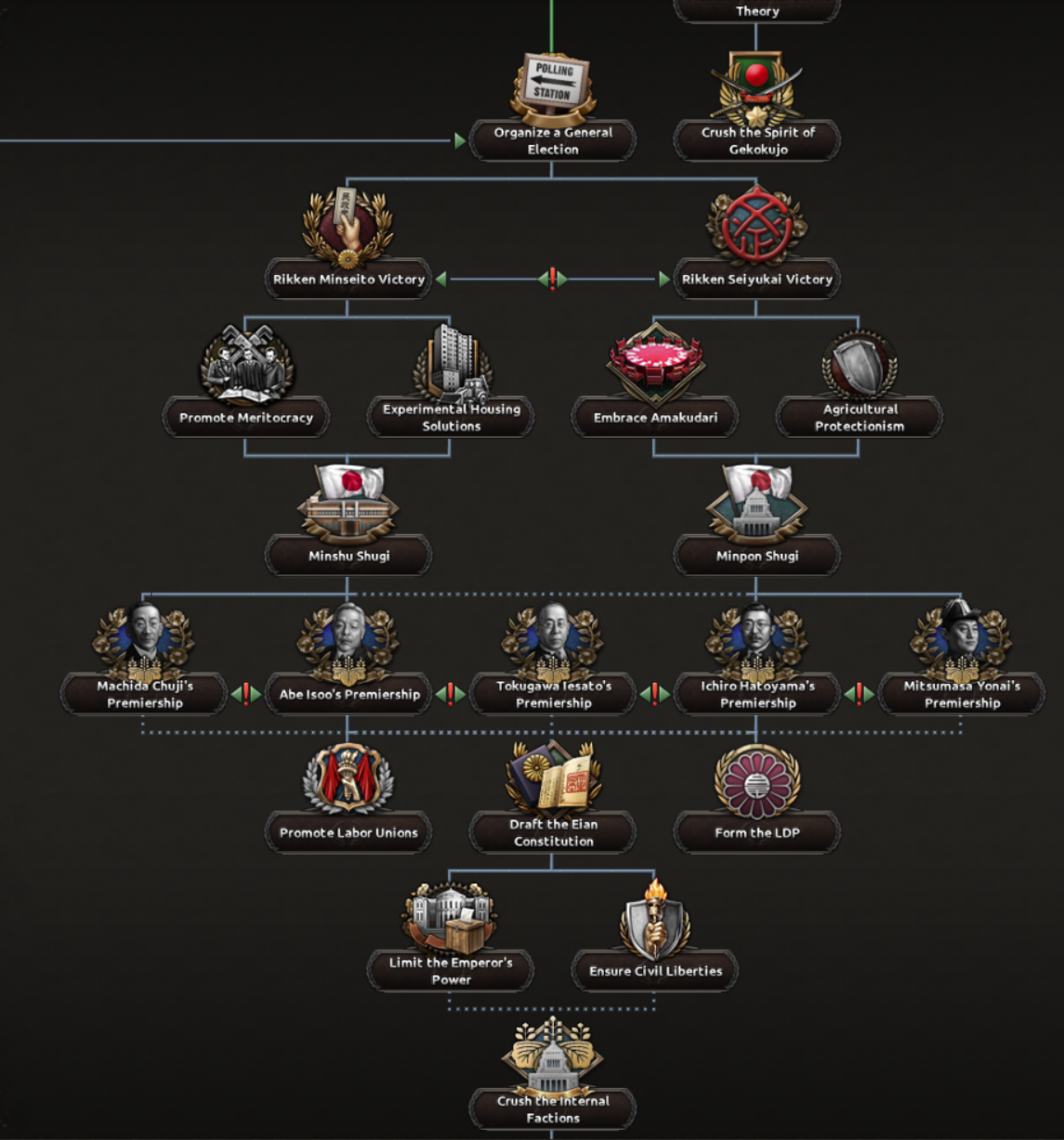


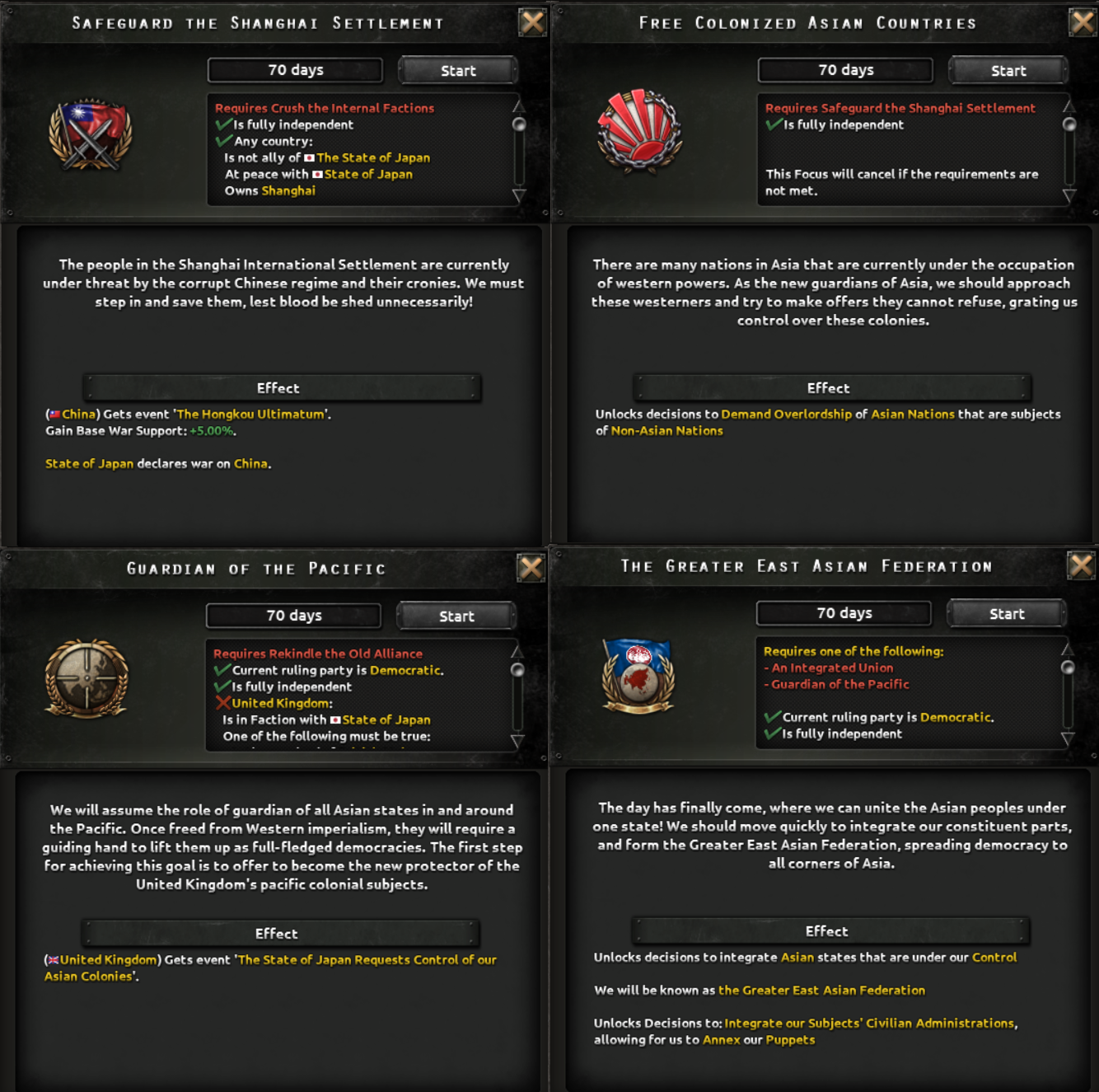

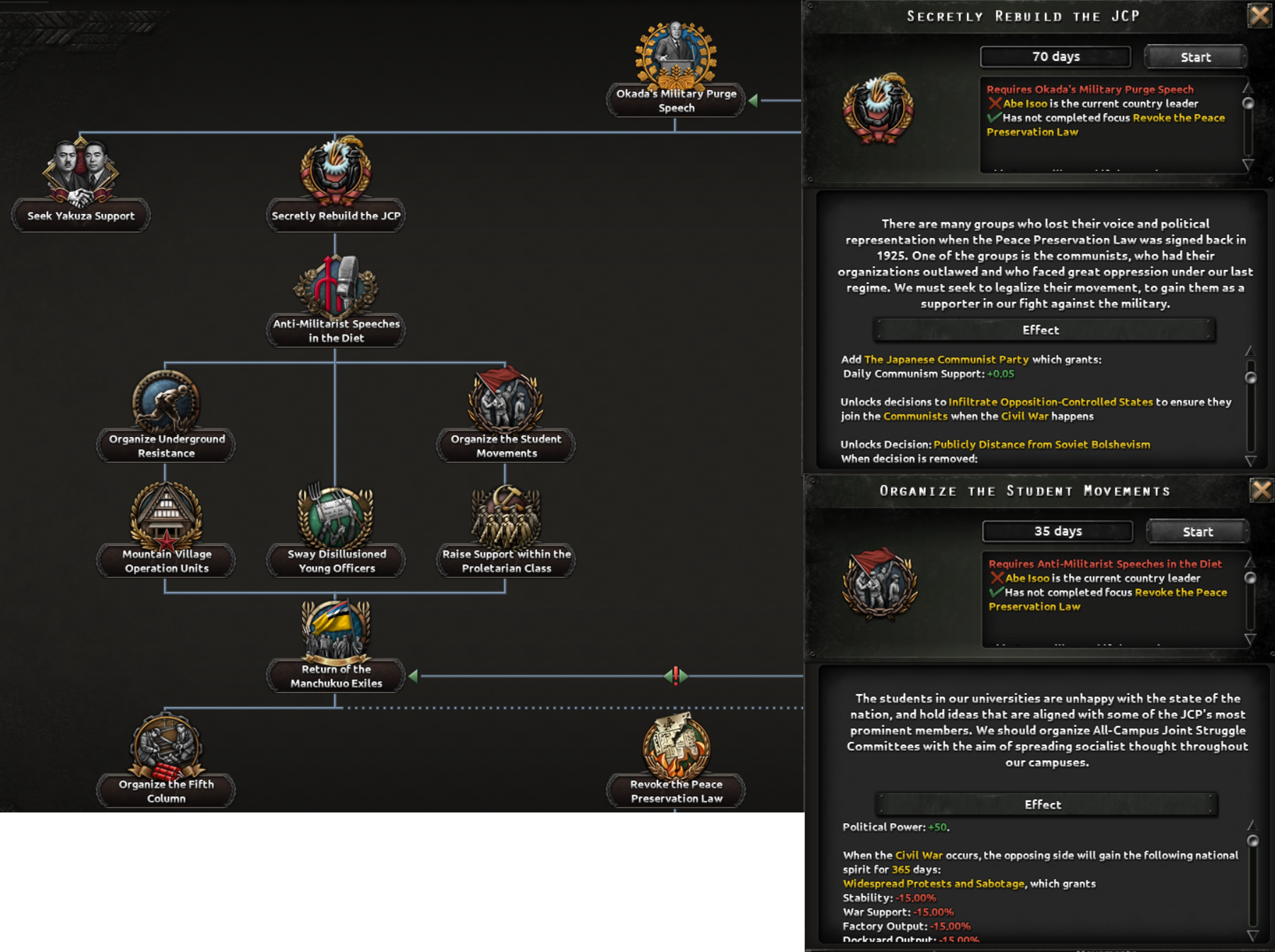
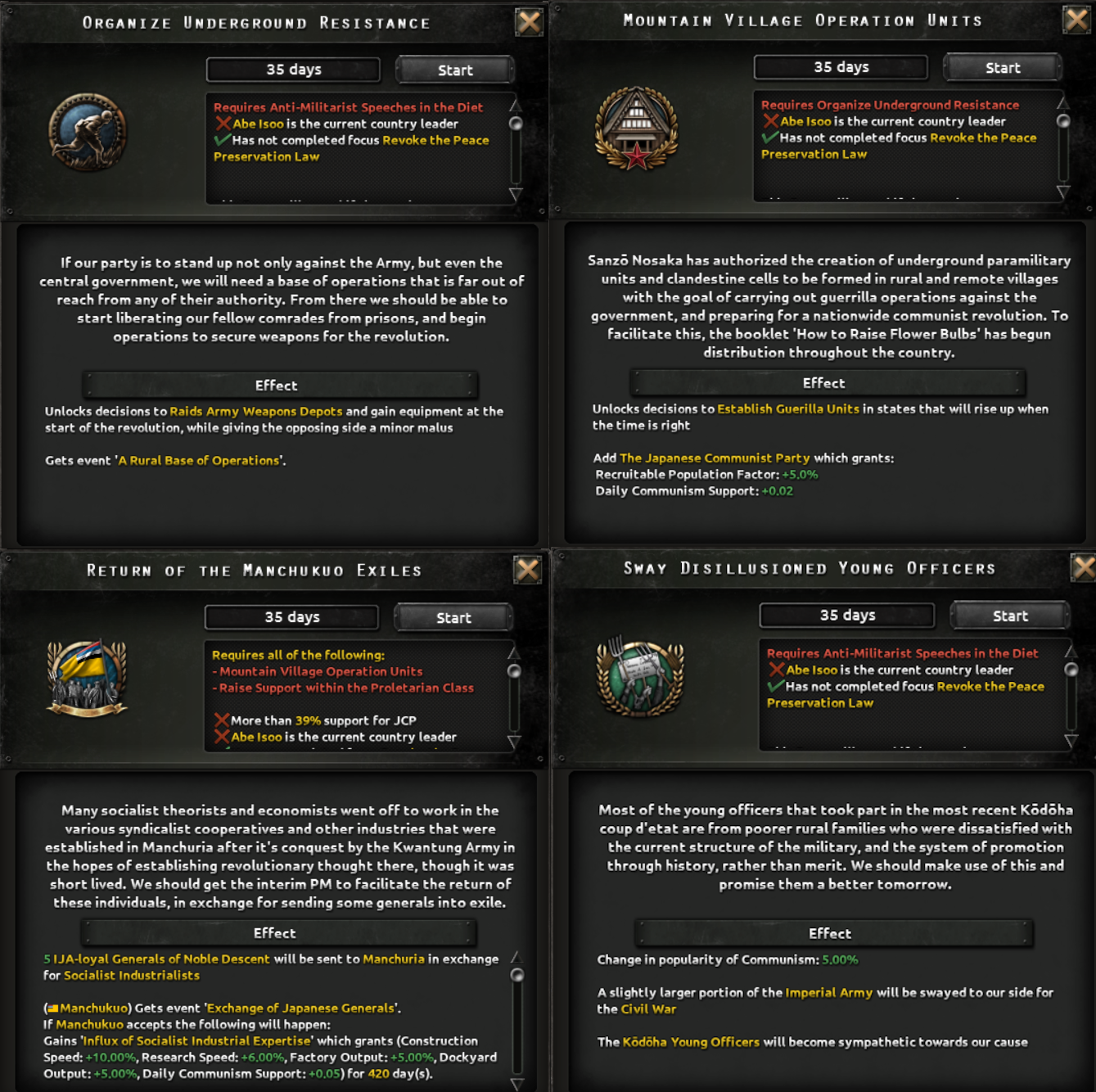
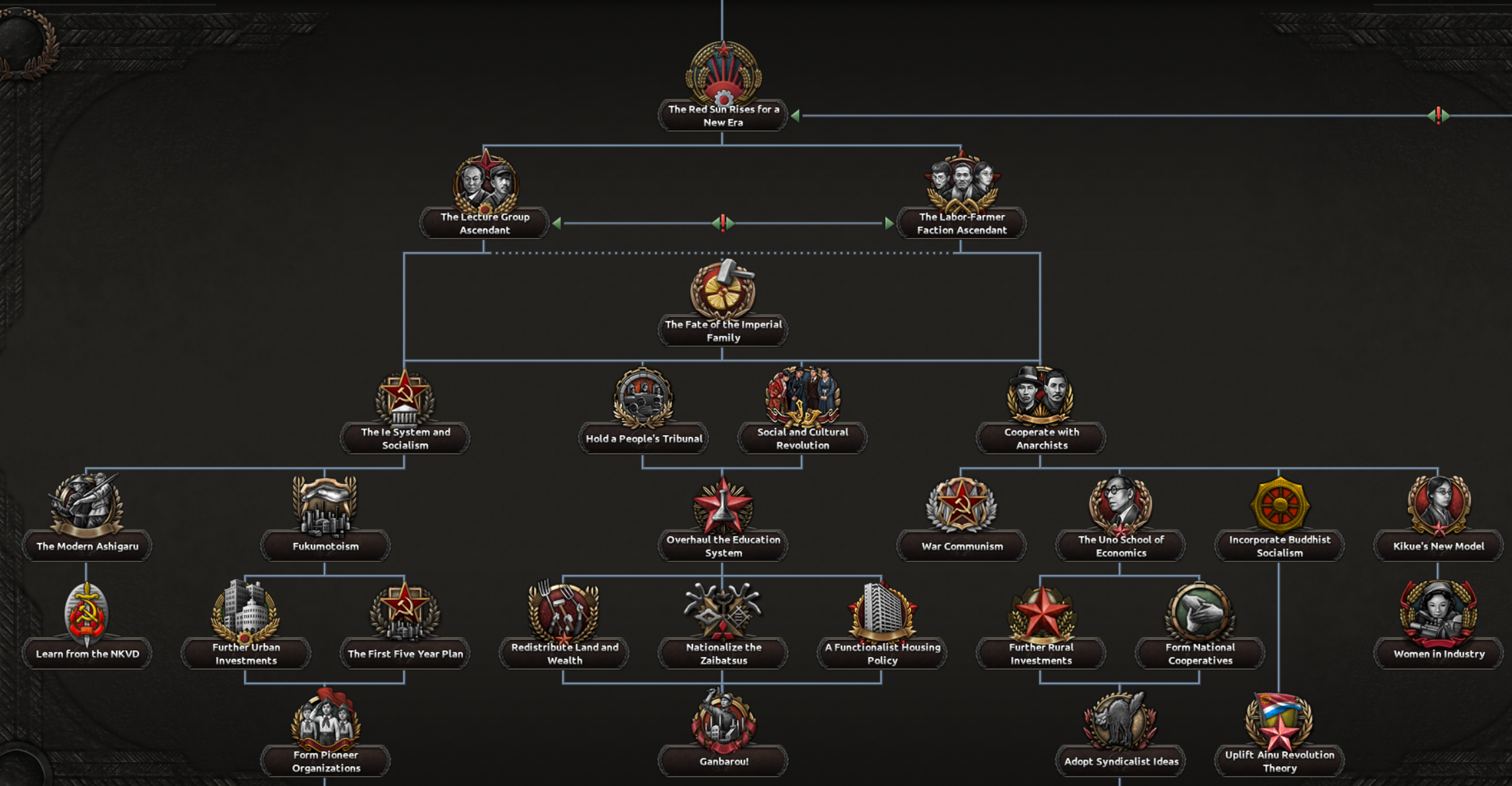

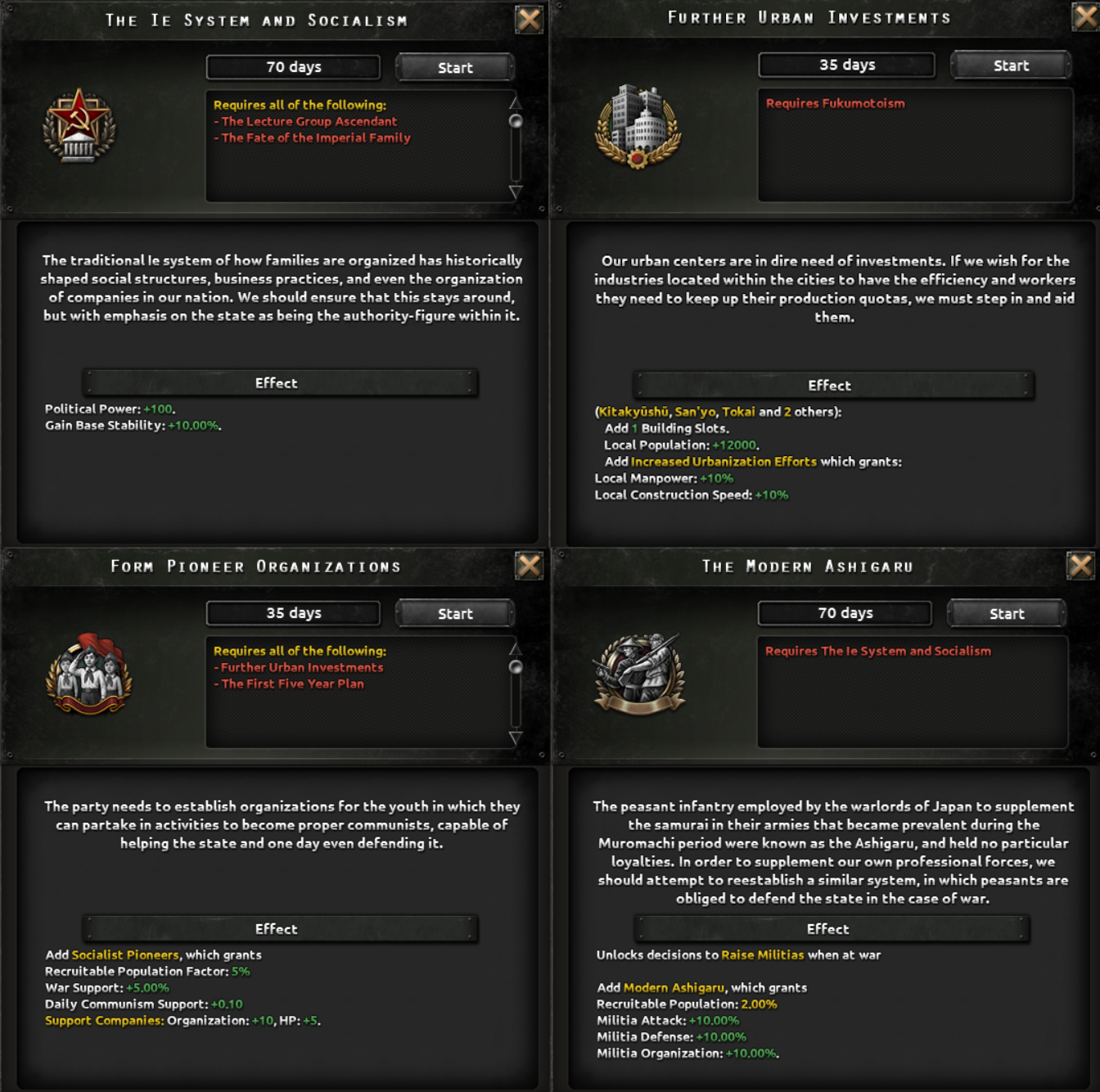
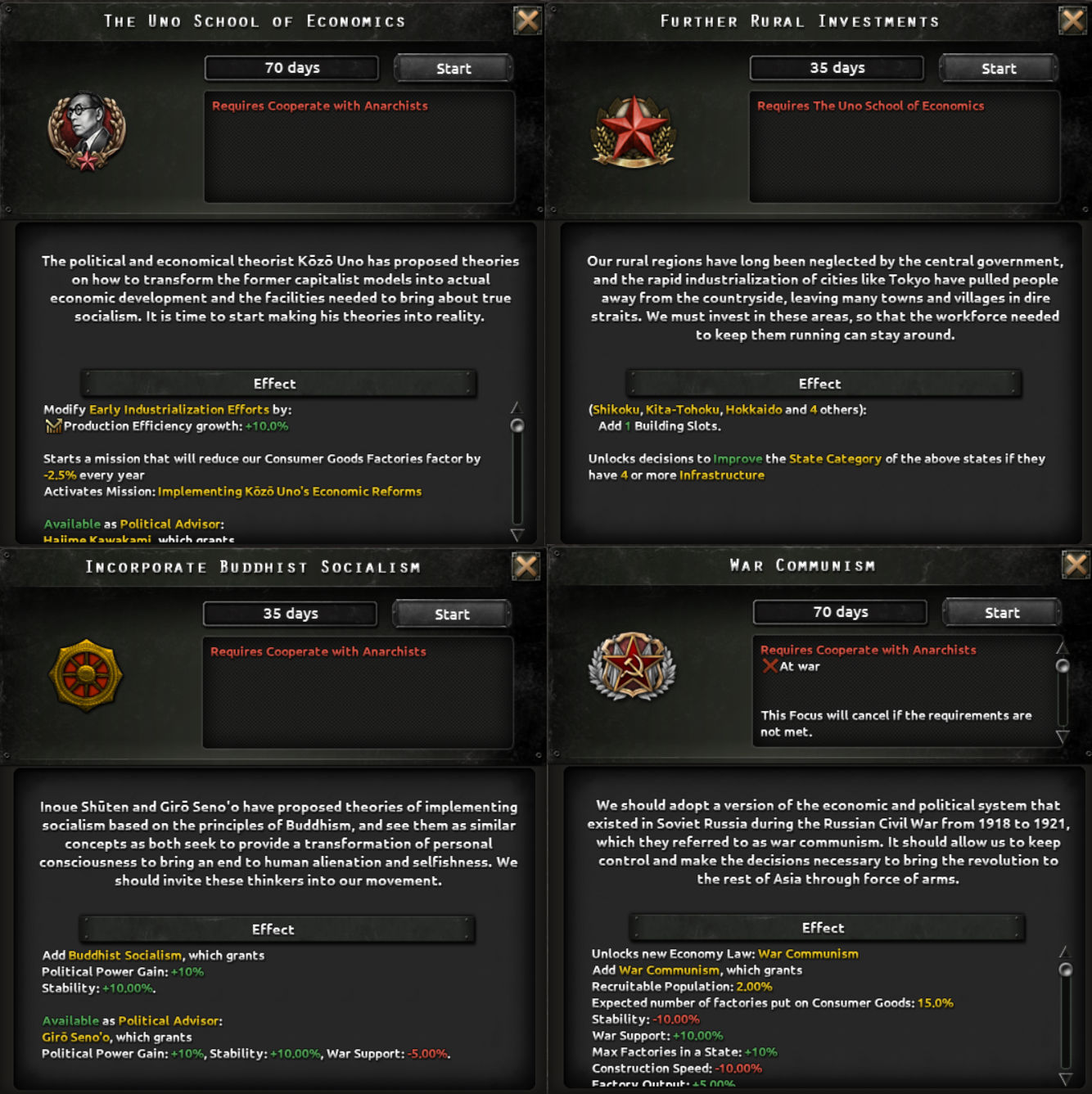

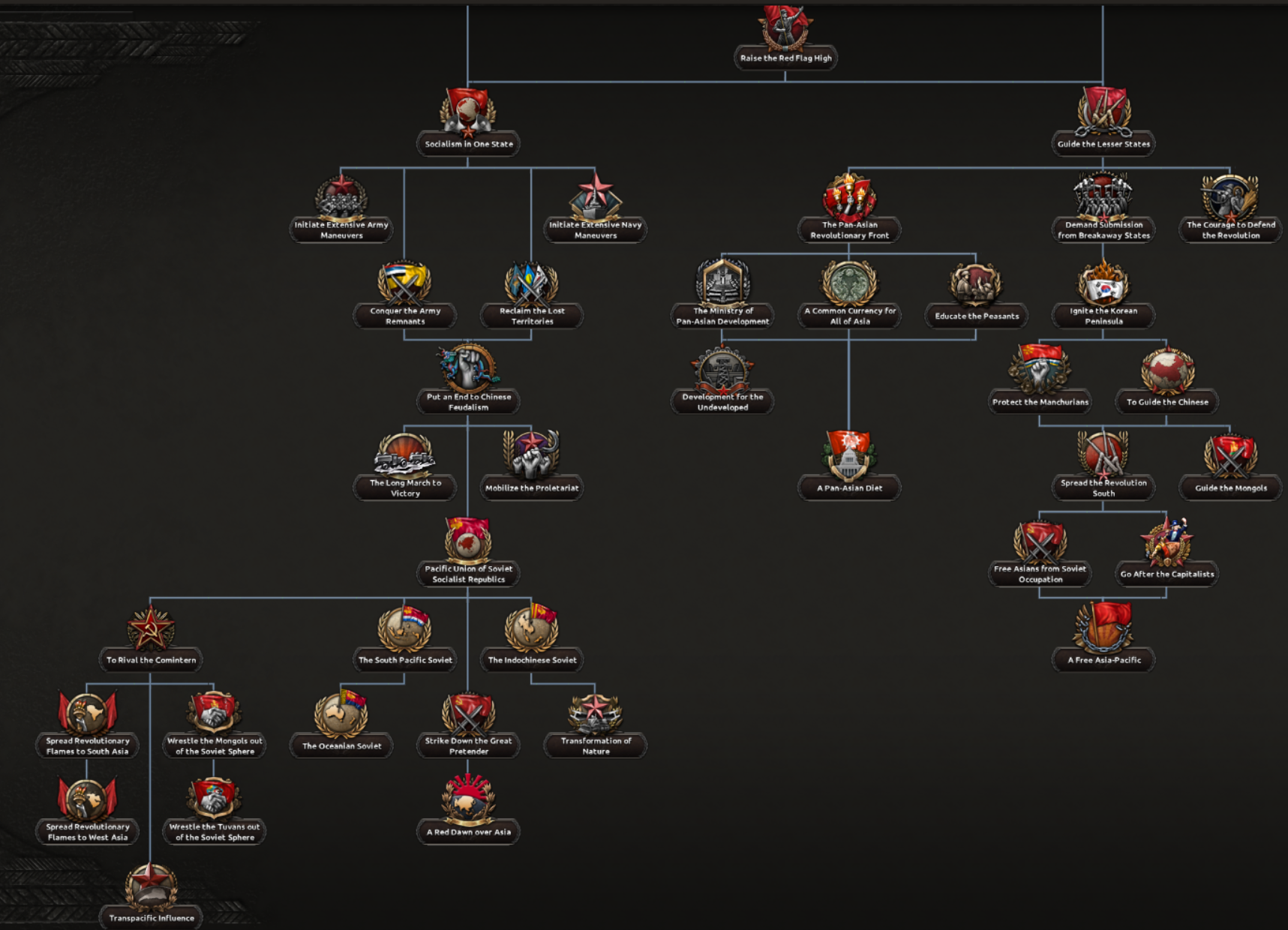
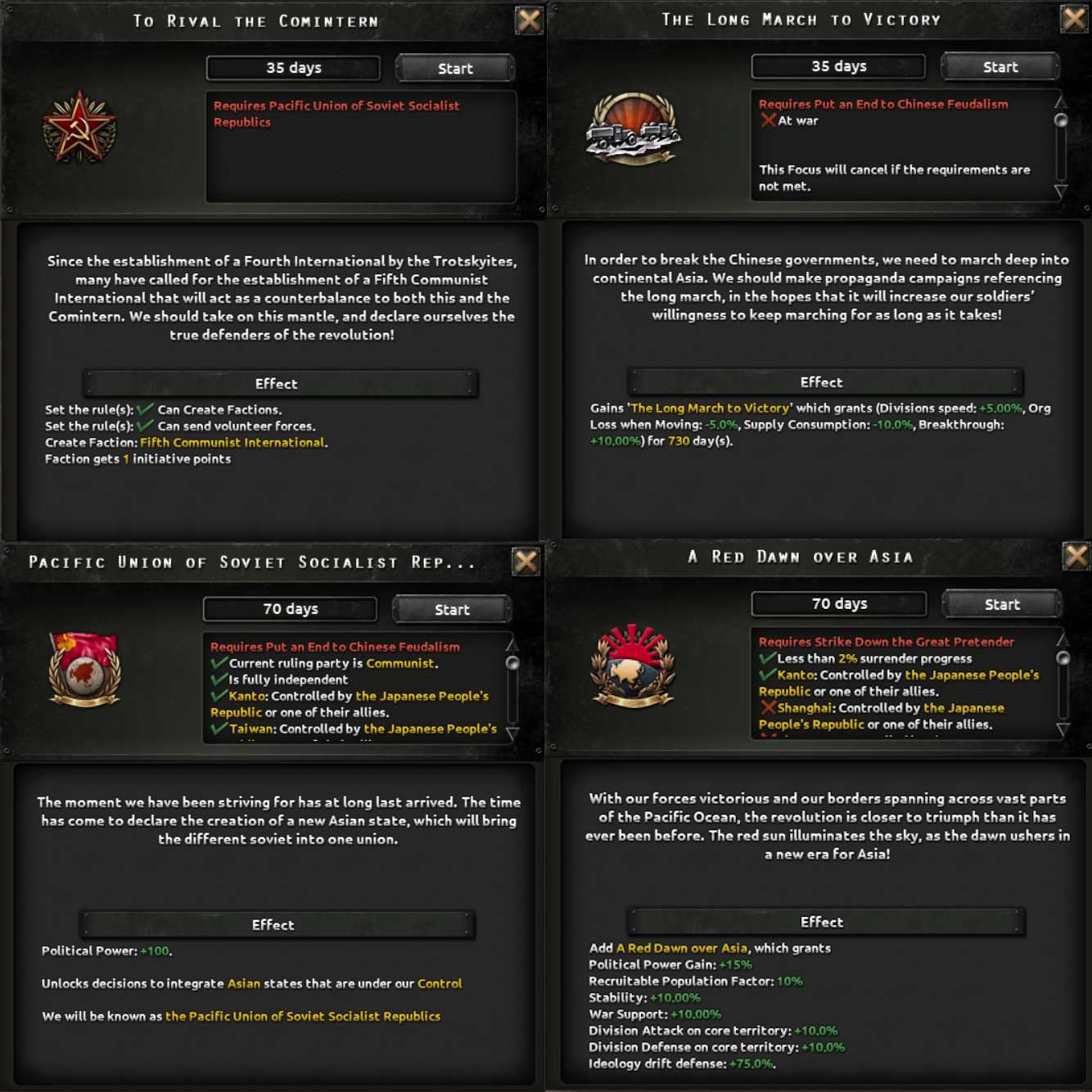
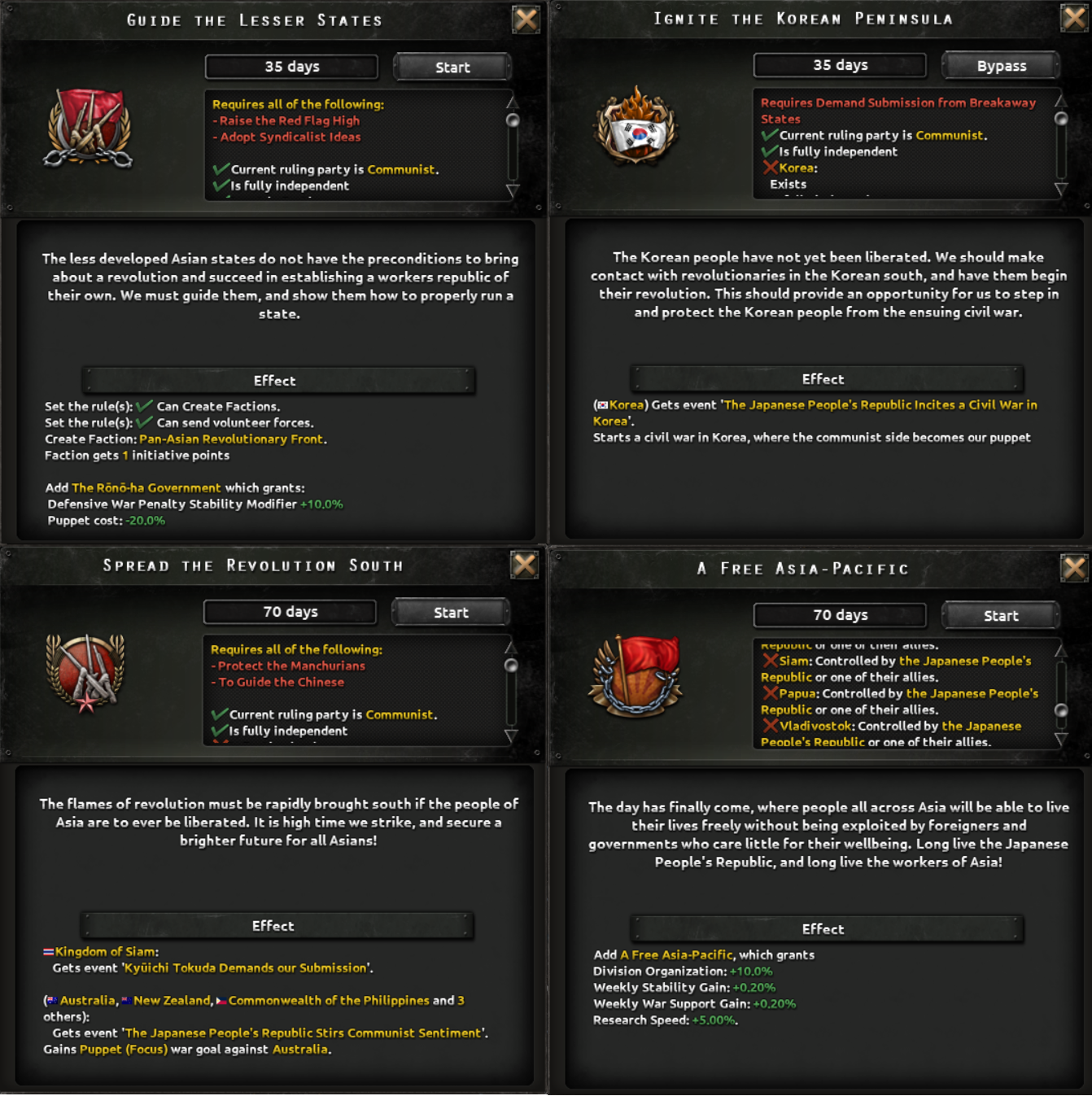



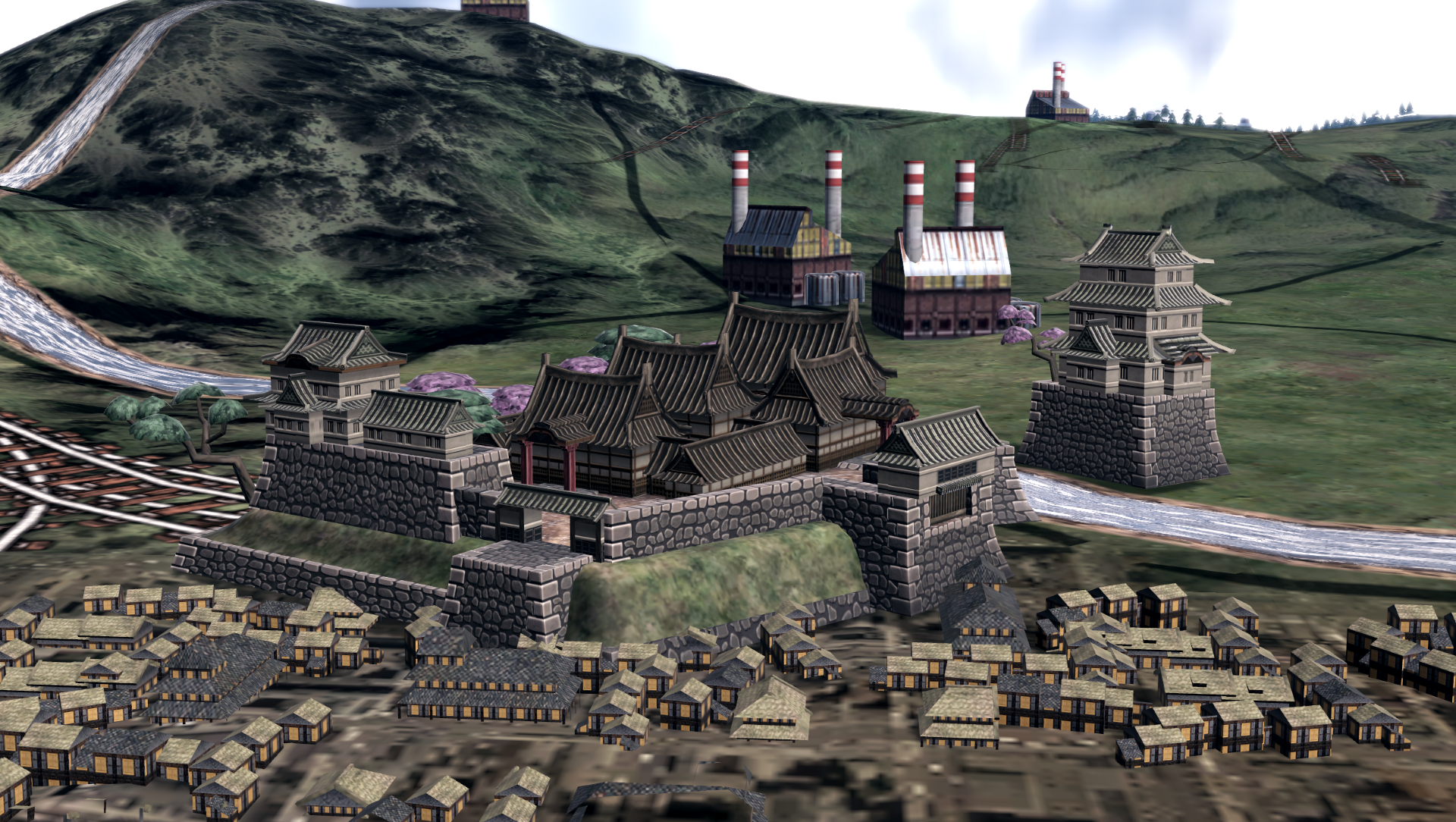
 So many new things! New Focuses, new National Spirits, a new Country Leader, and a different Ideology
So many new things! New Focuses, new National Spirits, a new Country Leader, and a different Ideology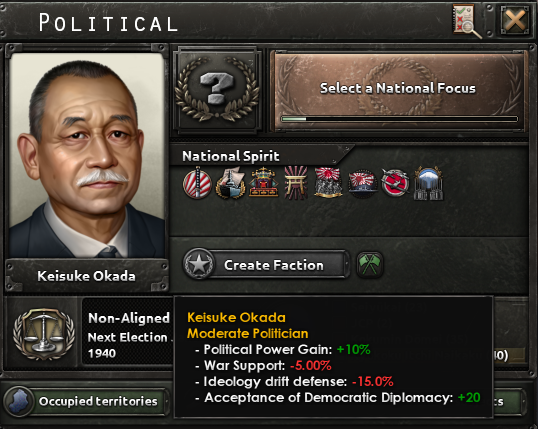 The Political Situation in Japan 1936
The Political Situation in Japan 1936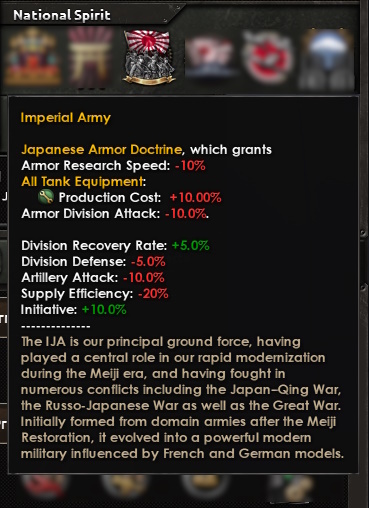 There is plenty to unpack here. As you might have noticed, the Imperial Army looks a bit different from other National Spirits as it’s kind of split in two parts: The Japanese Armor Doctrine at the top and the rest of the modifiers below. This kind of thing has been made possible with last year's DLC
There is plenty to unpack here. As you might have noticed, the Imperial Army looks a bit different from other National Spirits as it’s kind of split in two parts: The Japanese Armor Doctrine at the top and the rest of the modifiers below. This kind of thing has been made possible with last year's DLC 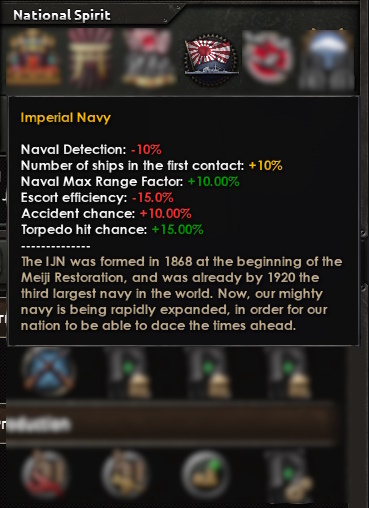 The Japanese naval doctrine was all about Kantai Kessen, the decisive battle, where they sought to have one big sea battle to settle the dominance over the seas. This led to a very aggressive approach to all things navy (well, military really, since the army had a similar mindset), so much so that they designed and built their ships with enough firepower to make them top-heavy and suffered from accidents and damage because of this. This also resulted in an inability to detect the USA’s submarines and protect the all-important naval convoys shipping resources, food, and materiel all across the Empire. What they excelled at, on the other hand, was torpedoes.
The Japanese naval doctrine was all about Kantai Kessen, the decisive battle, where they sought to have one big sea battle to settle the dominance over the seas. This led to a very aggressive approach to all things navy (well, military really, since the army had a similar mindset), so much so that they designed and built their ships with enough firepower to make them top-heavy and suffered from accidents and damage because of this. This also resulted in an inability to detect the USA’s submarines and protect the all-important naval convoys shipping resources, food, and materiel all across the Empire. What they excelled at, on the other hand, was torpedoes.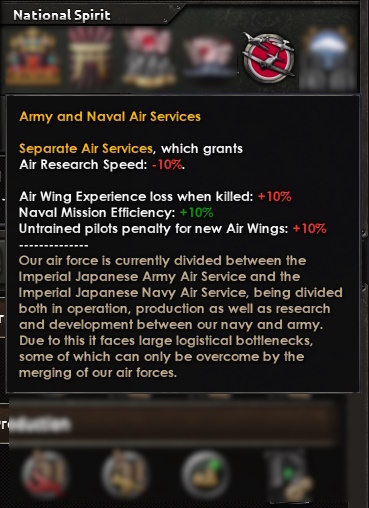 Historically, Japan had two different air forces; the army’s and the navy’s - and they would guard any technological advancement jealously from one another (yeah, their inter-servis rivalry was intense). In the game, we bundled both of them into one National Spirit; Army and Naval Air Services, but once again we can see that this Spirit is also split in two with the Separate Air Services research debuff and the rest of the modifiers. Japan probably had the best carrier air wings at the beginning of the game, but also suffered immensely later on when they started to lose pilots at a rapid pace because their training was so rigorous. This meant that they couldn’t replenish their losses fast enough, but had to use untrained pilots.
Historically, Japan had two different air forces; the army’s and the navy’s - and they would guard any technological advancement jealously from one another (yeah, their inter-servis rivalry was intense). In the game, we bundled both of them into one National Spirit; Army and Naval Air Services, but once again we can see that this Spirit is also split in two with the Separate Air Services research debuff and the rest of the modifiers. Japan probably had the best carrier air wings at the beginning of the game, but also suffered immensely later on when they started to lose pilots at a rapid pace because their training was so rigorous. This meant that they couldn’t replenish their losses fast enough, but had to use untrained pilots.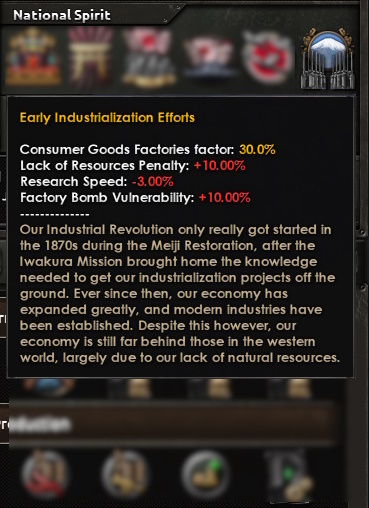 Japan had industrialized at a never-before-seen pace in the late 1900s, frantically trying to catch up with the West. And while they achieved something truly impressive with their rapid industrialization, they never really got on the same level as the other major powers. The biggest issue facing Japanese industries was the lack of natural resources within the home islands - and the reason why the military wanted to expand and acquire these through aggressive means.
Japan had industrialized at a never-before-seen pace in the late 1900s, frantically trying to catch up with the West. And while they achieved something truly impressive with their rapid industrialization, they never really got on the same level as the other major powers. The biggest issue facing Japanese industries was the lack of natural resources within the home islands - and the reason why the military wanted to expand and acquire these through aggressive means.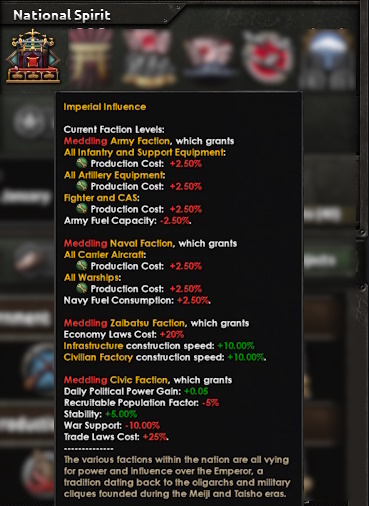 Japan suffered from political infighting between various factions and unchecked military aspirations during this period. The inter-service rivalry between the army and the navy is reflected in the Imperial Influence, where both are vying for influence and the limited resources Japan possesses; if one faction gains influence over the other, it’ll produce its equipment at a cheaper cost, while the opposing faction will face more expensive production costs. But there are two other factions that’s struggling to attain the Emperor’s attention; the industrial Zaibatsus and the civilian government.
Japan suffered from political infighting between various factions and unchecked military aspirations during this period. The inter-service rivalry between the army and the navy is reflected in the Imperial Influence, where both are vying for influence and the limited resources Japan possesses; if one faction gains influence over the other, it’ll produce its equipment at a cheaper cost, while the opposing faction will face more expensive production costs. But there are two other factions that’s struggling to attain the Emperor’s attention; the industrial Zaibatsus and the civilian government. The four stages of Influence
The four stages of Influence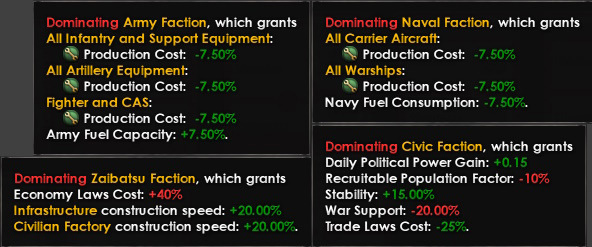 All of this means that you can focus your attention on a specific thing to make it more effective; the Army faction and Navy Faction will decrease production costs towards their respective equipment, while the Zaibatsu faction will increase Civilian factory and Infrastructure Construction Speed, and the Civic Faction will increase your Political Power and reduce the cost for changing Trade Laws.
All of this means that you can focus your attention on a specific thing to make it more effective; the Army faction and Navy Faction will decrease production costs towards their respective equipment, while the Zaibatsu faction will increase Civilian factory and Infrastructure Construction Speed, and the Civic Faction will increase your Political Power and reduce the cost for changing Trade Laws.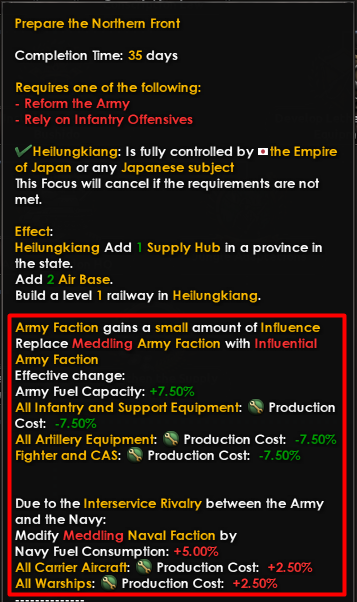 Due to their inter-service rivalry, the Army and Naval Factions are the only ones that directly affect each other; as long as they are on the same level, they will suffer slight Production Cost maluses, while if one of them rises above the other one, the more influential of them will gain bonuses towards its Production Costs, while the other one receives even more severe maluses. This means you can start out supporting the army by building lots of infantry and artillery equipment before and during its invasion of China, before pivoting to support the navy and building up a strong fleet to face off against the allies.
Due to their inter-service rivalry, the Army and Naval Factions are the only ones that directly affect each other; as long as they are on the same level, they will suffer slight Production Cost maluses, while if one of them rises above the other one, the more influential of them will gain bonuses towards its Production Costs, while the other one receives even more severe maluses. This means you can start out supporting the army by building lots of infantry and artillery equipment before and during its invasion of China, before pivoting to support the navy and building up a strong fleet to face off against the allies. The Influence level can also boost the rewards you get from some focuses. So, how do you go about increasing (or decreasing, for that matter) the level of a faction? This can be done by completing focuses or by simply spending some Political Power and either Endorse or Suppress a Faction within the Imperial Influence inlay window.
The Influence level can also boost the rewards you get from some focuses. So, how do you go about increasing (or decreasing, for that matter) the level of a faction? This can be done by completing focuses or by simply spending some Political Power and either Endorse or Suppress a Faction within the Imperial Influence inlay window.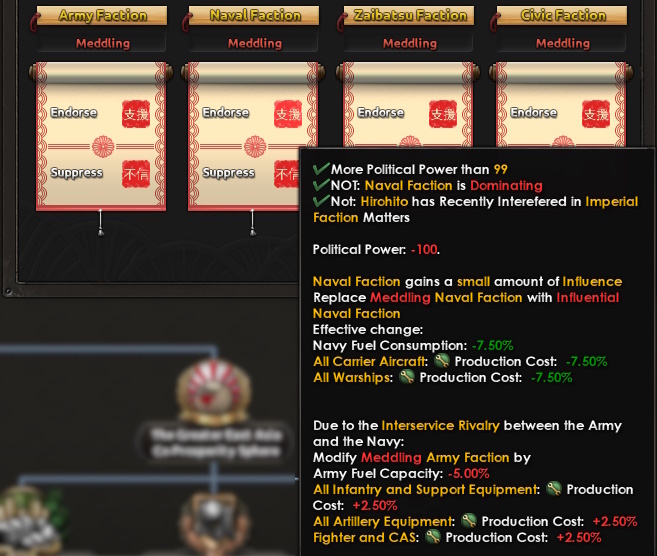
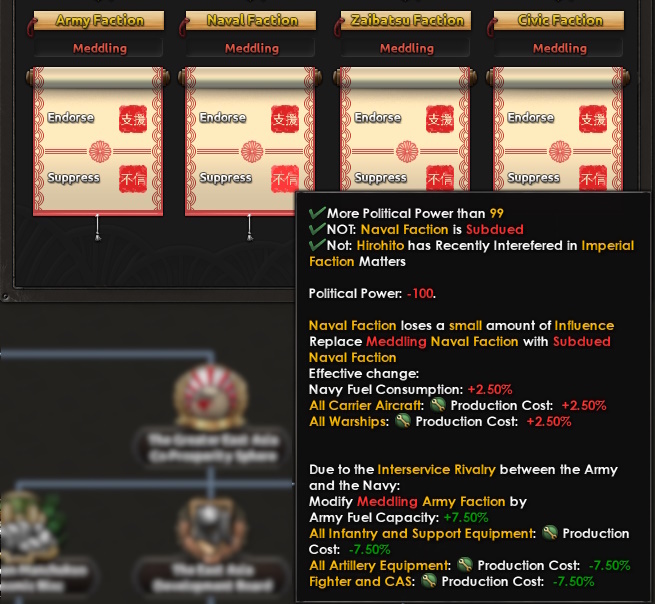 If a faction becomes influential enough, they will also start to send Demands. If you complete these Demands, they will gain additional influence, but if you fail, they will lose it instead. If you’ve played historical Italy you should be familiar with the “Missiolinis”, where Mussolini will want to do certain things, you have a pretty good idea of what the Faction Demands are all about.
If a faction becomes influential enough, they will also start to send Demands. If you complete these Demands, they will gain additional influence, but if you fail, they will lose it instead. If you’ve played historical Italy you should be familiar with the “Missiolinis”, where Mussolini will want to do certain things, you have a pretty good idea of what the Faction Demands are all about.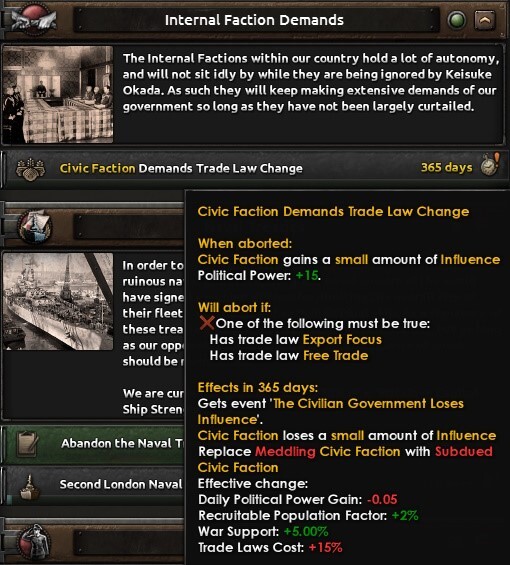 With that out of the way, it’s high time we take a look at the actual meat and bones of this Dev Diary; the Focus Tree! And let’s start with:
With that out of the way, it’s high time we take a look at the actual meat and bones of this Dev Diary; the Focus Tree! And let’s start with: The Industrial Branch for Japan
The Industrial Branch for Japan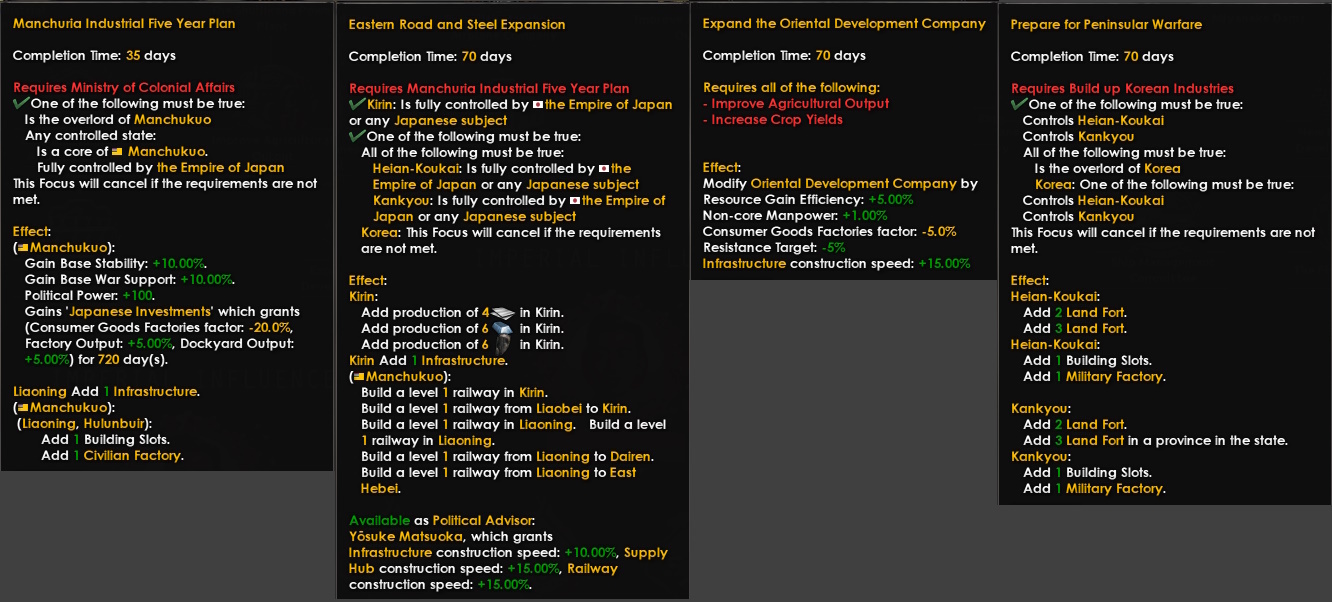 The Ministry of Colonial Affairs sub-branch is all about building up your puppet Manchukuo and your colonies throughout the Pacific with Civilian and Military Factories, Dams, Infrastructure, and Resource Prospecting - all the while helping your own economy.
The Ministry of Colonial Affairs sub-branch is all about building up your puppet Manchukuo and your colonies throughout the Pacific with Civilian and Military Factories, Dams, Infrastructure, and Resource Prospecting - all the while helping your own economy.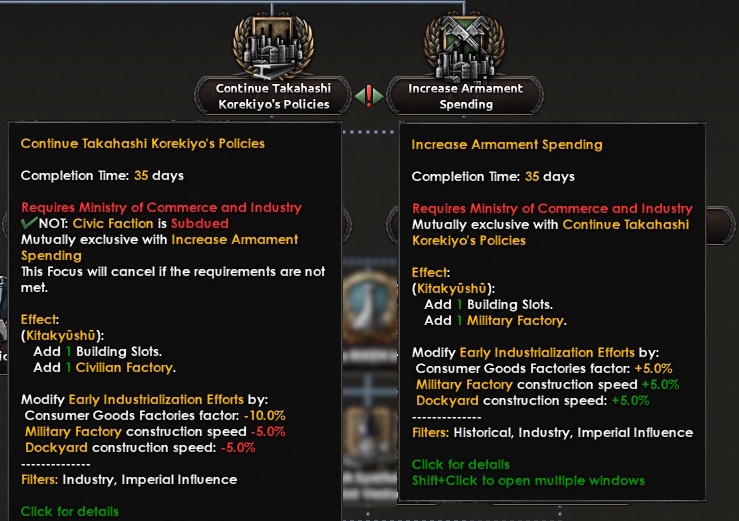 When developing the home islands, you first have to choose between Continue Takahashi Korekiyo’s Policies or Increase Armament Spending. And after that, you get to approach one (or all four) of the Big Zaibatsus, industrial conglomerates - each one unlocking at least an Industrial Concern.
When developing the home islands, you first have to choose between Continue Takahashi Korekiyo’s Policies or Increase Armament Spending. And after that, you get to approach one (or all four) of the Big Zaibatsus, industrial conglomerates - each one unlocking at least an Industrial Concern. 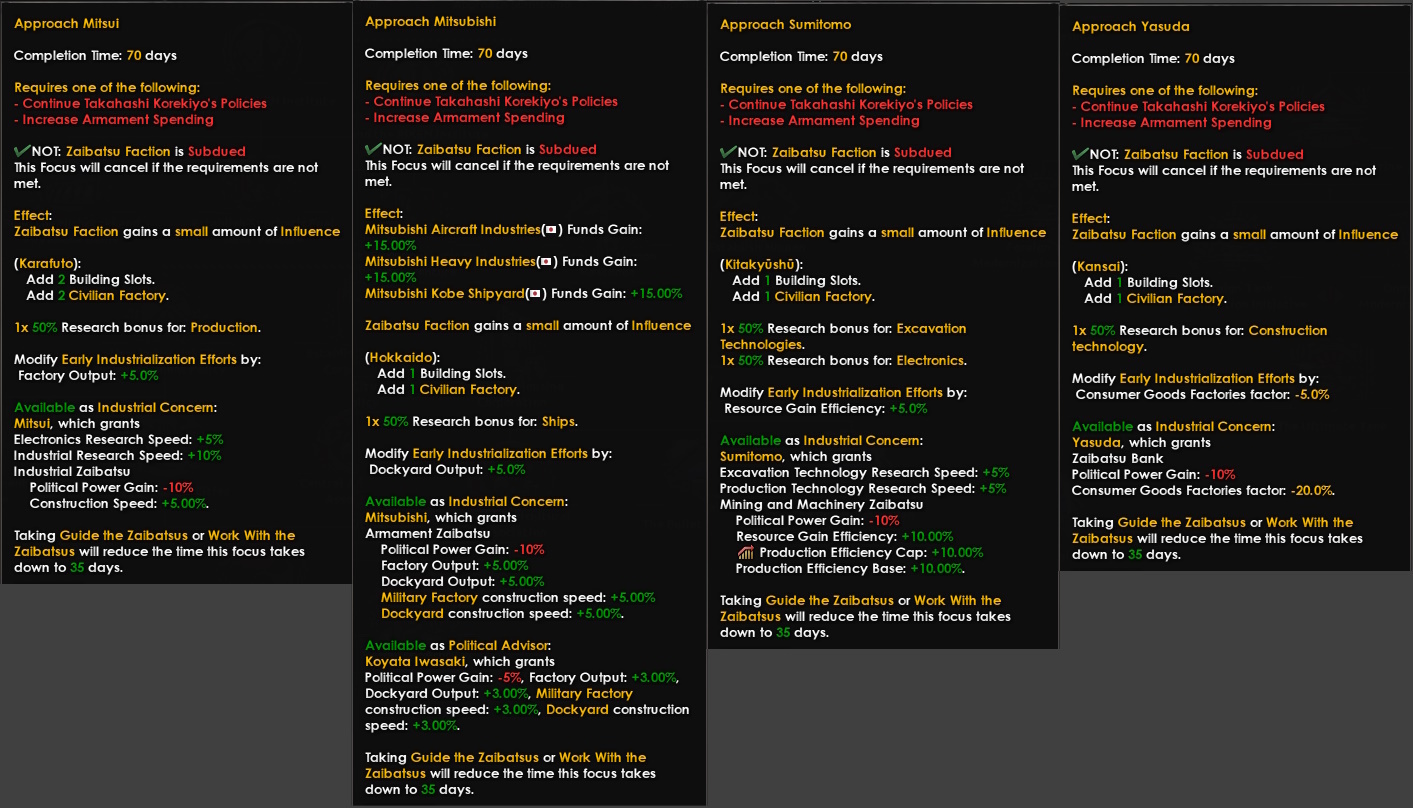 The Fund the RIKEN Institute has one of those effects we talked about above, where if the Zaibatsu Faction is at least Influential within the Imperial Influence, you gain a Nuclear Research facility - pretty fancy if you ask me.
The Fund the RIKEN Institute has one of those effects we talked about above, where if the Zaibatsu Faction is at least Influential within the Imperial Influence, you gain a Nuclear Research facility - pretty fancy if you ask me. With the last focus in the branch, the Resource Security, you transform your Early Industrialization Efforts to The Economic Miracle - but it comes with hefty requirements:
With the last focus in the branch, the Resource Security, you transform your Early Industrialization Efforts to The Economic Miracle - but it comes with hefty requirements: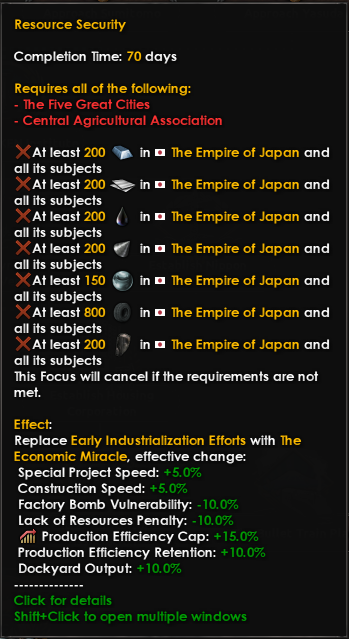 There are also a lot of new Industrial Concerns and MIOs - why don’t we have a look at them? Just a quick sneak peek ;)
There are also a lot of new Industrial Concerns and MIOs - why don’t we have a look at them? Just a quick sneak peek ;)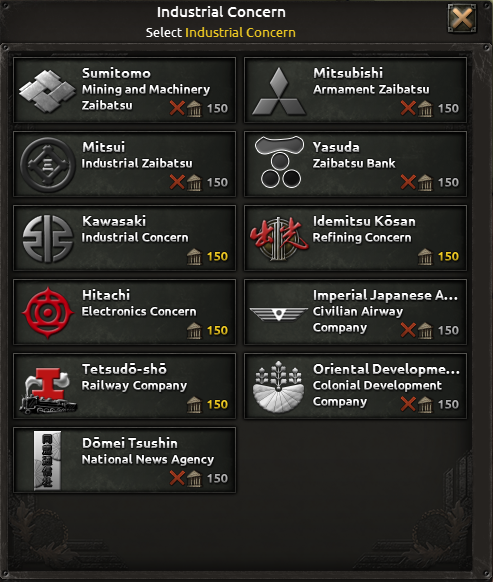
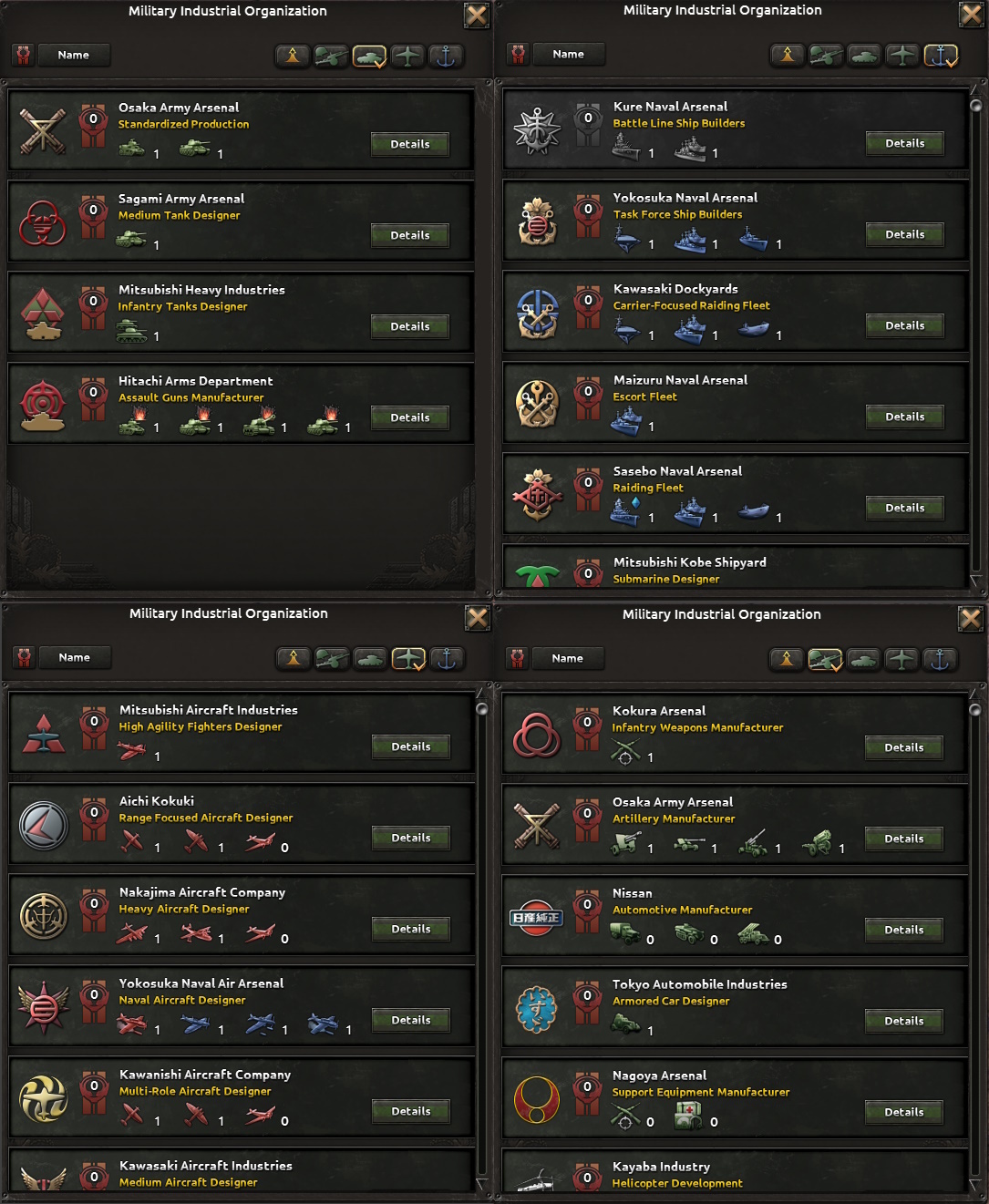 We’ve talked about how to build up your industry now - but why is that so important? Well, because you need a strong industrial backbone if you want to be successful in waging wars. Speaking of, let’s talk about…
We’ve talked about how to build up your industry now - but why is that so important? Well, because you need a strong industrial backbone if you want to be successful in waging wars. Speaking of, let’s talk about… The Japanese military, from the army to the navy, was more or less all about striking hard and striking fast. The army focused on fast-moving and mobile infantry units, intended to win quick wars, while the navy followed the Kantai Kessen, the decisive battle way of thinking - where they aimed to knock out an enemy navy (*cough*USA*cough*) in one single battle. The military branches, therefore, all start with The Imperial Defense Plan, which grants National Spirits if you declare war on countries that meet a specific goal:
The Japanese military, from the army to the navy, was more or less all about striking hard and striking fast. The army focused on fast-moving and mobile infantry units, intended to win quick wars, while the navy followed the Kantai Kessen, the decisive battle way of thinking - where they aimed to knock out an enemy navy (*cough*USA*cough*) in one single battle. The military branches, therefore, all start with The Imperial Defense Plan, which grants National Spirits if you declare war on countries that meet a specific goal: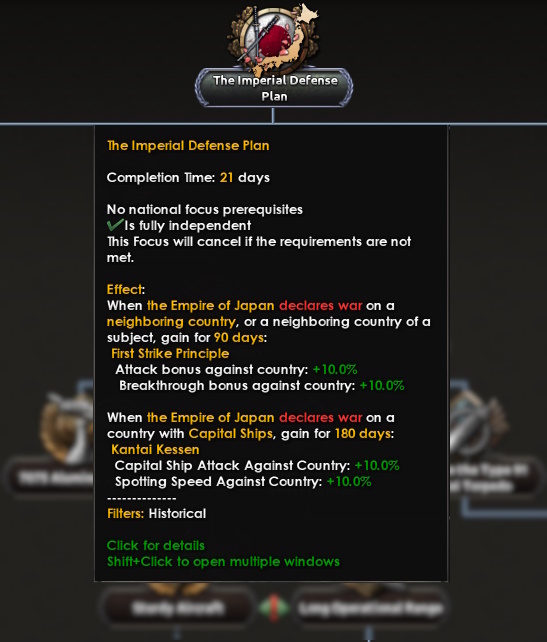 With that focus out of the way, you can progress down the individual branches of the military.
With that focus out of the way, you can progress down the individual branches of the military. Almost from the get-go, you have a choice to make when going down the Army Branch; do you embrace tank superiority and Reform the Army, or do you accept the supremacy of Will and Rely on Infantry Offensives? Either choice will boost your research for and usage of armor or infantry and artillery equipment, letting you lean into those categories further and streamline your army and doctrines.
Almost from the get-go, you have a choice to make when going down the Army Branch; do you embrace tank superiority and Reform the Army, or do you accept the supremacy of Will and Rely on Infantry Offensives? Either choice will boost your research for and usage of armor or infantry and artillery equipment, letting you lean into those categories further and streamline your army and doctrines. The Imperial Army’s National Spirit after specializing in tanks, infantry, and artillery, respectively
The Imperial Army’s National Spirit after specializing in tanks, infantry, and artillery, respectively The final important decisions you’ll have to make are probably dependent on how the war is going; will you Pivot Towards Defensive Measures, or Strengthen the Supply Lines?
The final important decisions you’ll have to make are probably dependent on how the war is going; will you Pivot Towards Defensive Measures, or Strengthen the Supply Lines?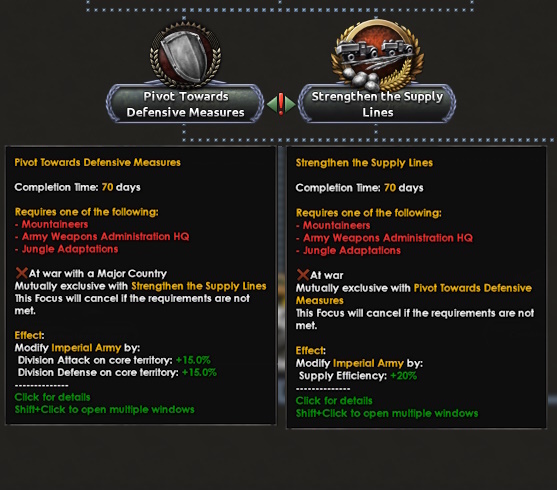 Having looked over Japan’s ground forces, it’s time to look up at the sky, and the….
Having looked over Japan’s ground forces, it’s time to look up at the sky, and the….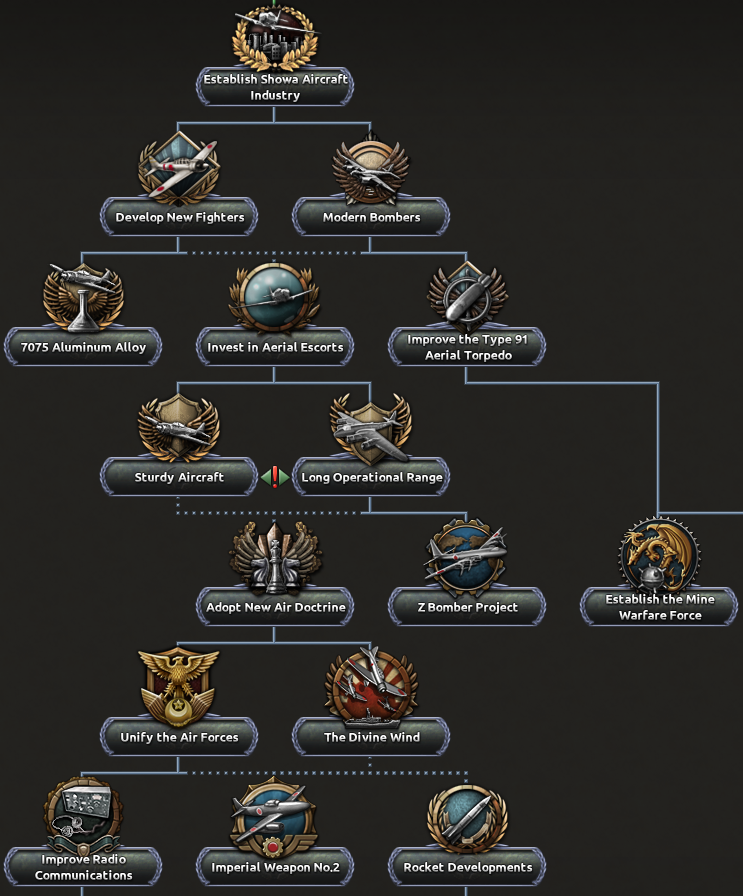 Rejoice, all Japan players, for no longer do you have to choose between the Zero or the Yamato! You can now, as the second focus in the
Rejoice, all Japan players, for no longer do you have to choose between the Zero or the Yamato! You can now, as the second focus in the 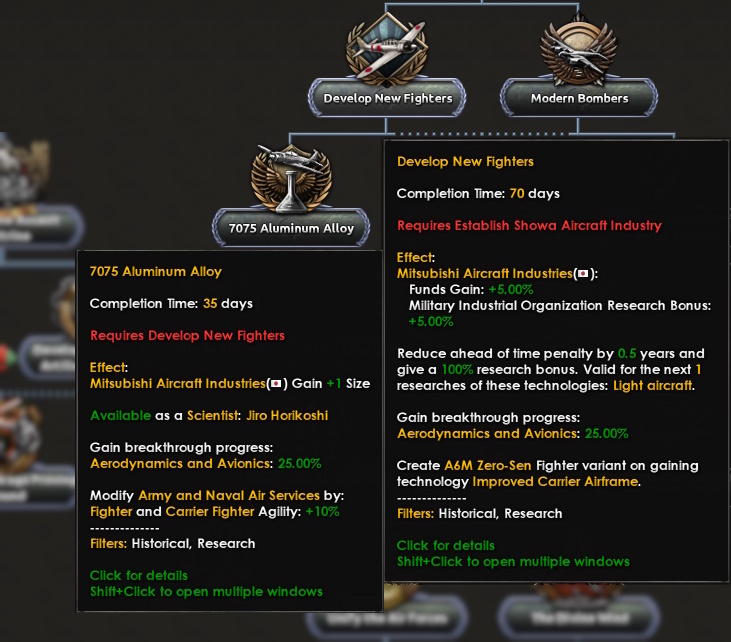 As you move into China, it might also be wise to invest in your bombers so you can truly take advantage of your almost guaranteed air supremacy to research Modern Bombers. After that, you can also lay the groundwork for a successful strike of Pearl Harbor and Improve the Type 91 Aerial Torpedo (which was specifically designed for shallow harbours).
As you move into China, it might also be wise to invest in your bombers so you can truly take advantage of your almost guaranteed air supremacy to research Modern Bombers. After that, you can also lay the groundwork for a successful strike of Pearl Harbor and Improve the Type 91 Aerial Torpedo (which was specifically designed for shallow harbours).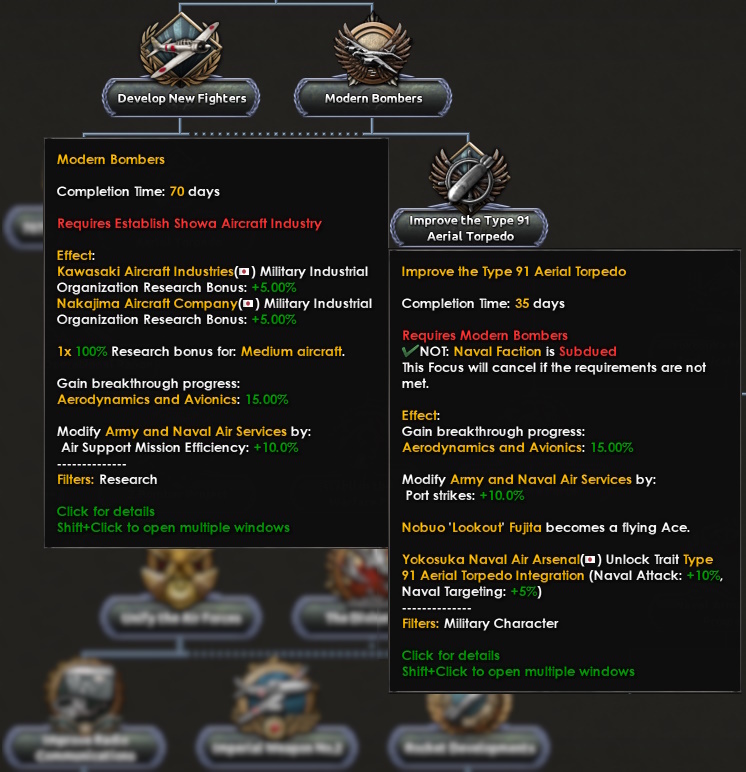 Once you’re at war, you can Invest in Aerial Escorts before deciding if you want Sturdy Aircraft with better defenses, but less range, or Long Operational Range but less defenses - and if you choose to focus on this, you can also develop the Z Bomber Project (a programme similar to Germany’s Amerikabomber with the aim to bomb New York).
Once you’re at war, you can Invest in Aerial Escorts before deciding if you want Sturdy Aircraft with better defenses, but less range, or Long Operational Range but less defenses - and if you choose to focus on this, you can also develop the Z Bomber Project (a programme similar to Germany’s Amerikabomber with the aim to bomb New York).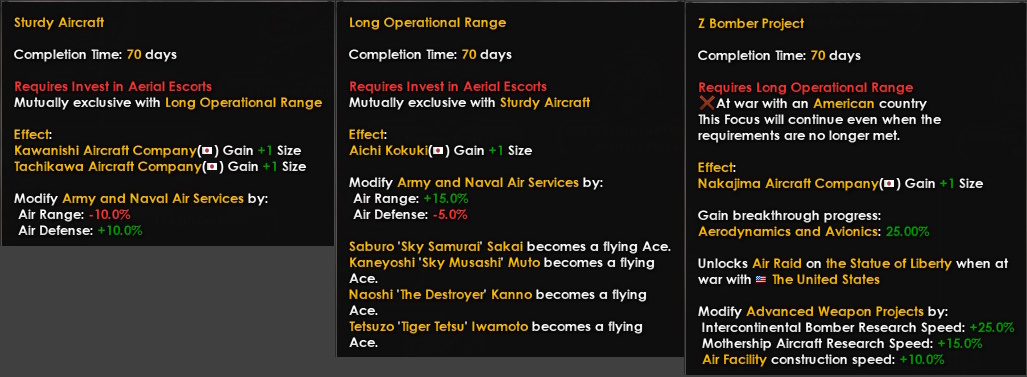 Having finished that, you can Unify the Air Forces under the same organization, effectivizing the organization and getting rid of those damn maluses.
Having finished that, you can Unify the Air Forces under the same organization, effectivizing the organization and getting rid of those damn maluses. Now, let us turn our gaze towards the rolling waves at the horizon and to the….
Now, let us turn our gaze towards the rolling waves at the horizon and to the….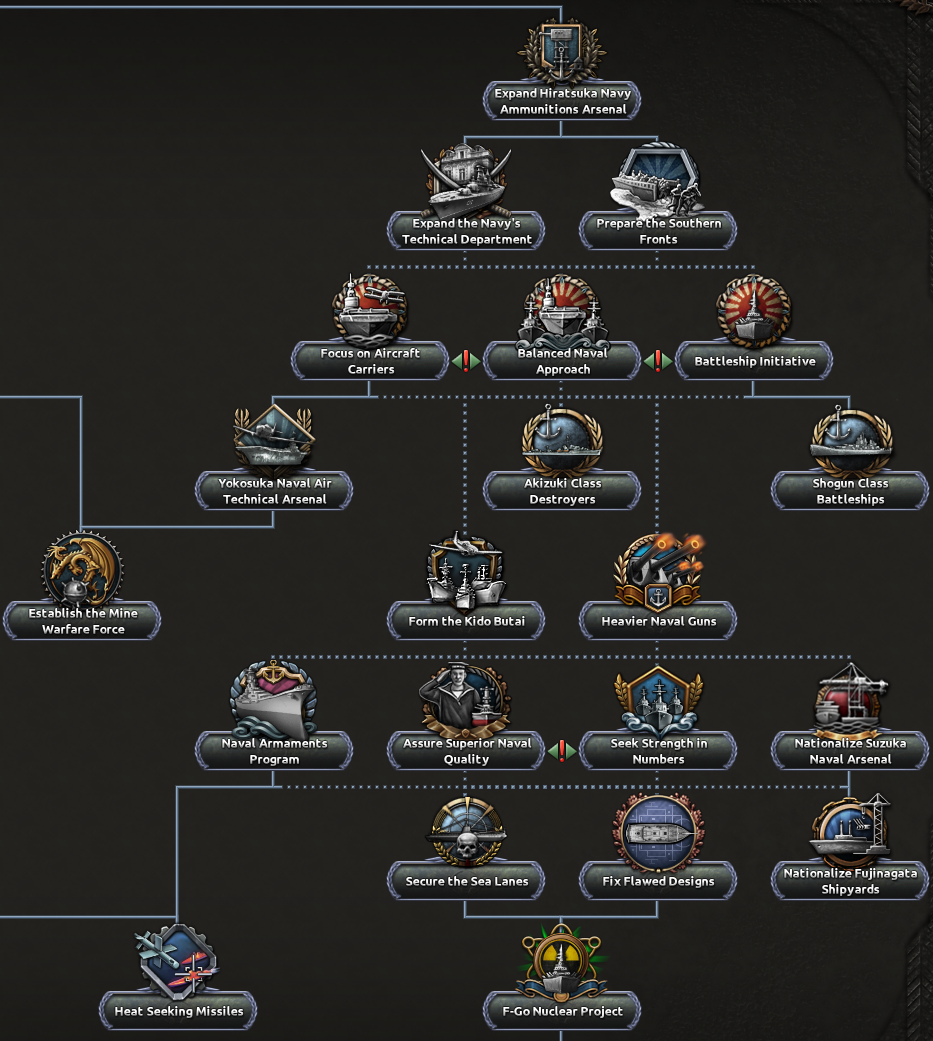 Before choosing what you want to focus your navy on, you can Expand the Navy’s Technical Department to gain some nice tech bonuses, and/or Prepare the Southern Fronts to improve your naval invasions of South East Asia for when that time comes around - both should be quite helpful though.
Before choosing what you want to focus your navy on, you can Expand the Navy’s Technical Department to gain some nice tech bonuses, and/or Prepare the Southern Fronts to improve your naval invasions of South East Asia for when that time comes around - both should be quite helpful though. After that, it’s time to make a pivotal decision regarding your navy; do you want to Focus on Aircraft Carriers, take a Balanced Naval Approach, or go for the Battleship Initiative? Either one of them should help you lean into a specific playstyle. This decision will also dictate which of the following focuses you can take.
After that, it’s time to make a pivotal decision regarding your navy; do you want to Focus on Aircraft Carriers, take a Balanced Naval Approach, or go for the Battleship Initiative? Either one of them should help you lean into a specific playstyle. This decision will also dictate which of the following focuses you can take.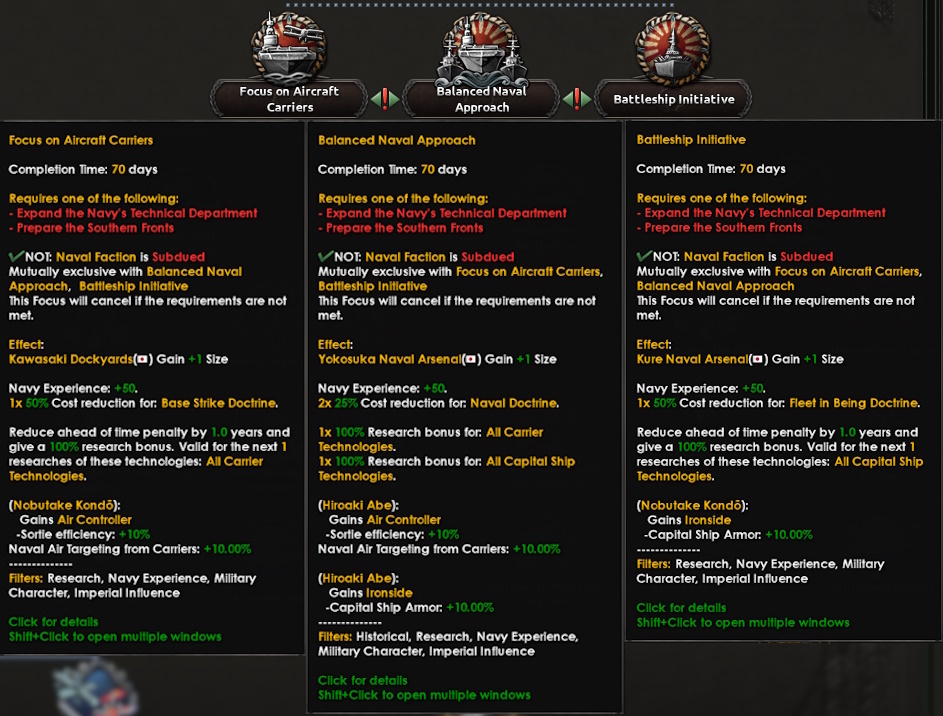 Depending on what you decide to focus on, the Naval Armaments Program will give you different things:
Depending on what you decide to focus on, the Naval Armaments Program will give you different things: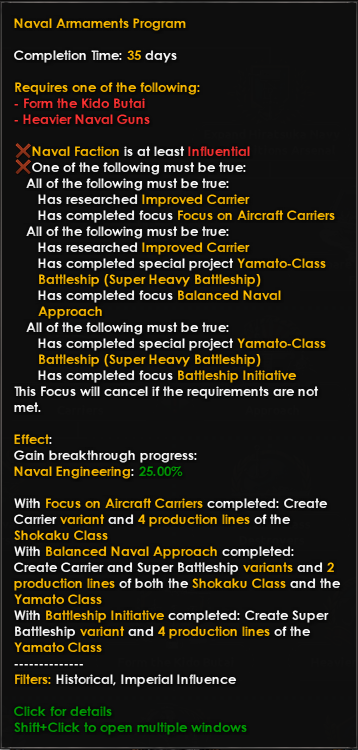 And with that, we’ve come to the conclusion of the Common Branches, and it’s time to take a look at what Japan’s politics has to offer!
And with that, we’ve come to the conclusion of the Common Branches, and it’s time to take a look at what Japan’s politics has to offer! 